The Puglia Guys Ostuni guide. Made in Puglia.
Sophisticated and stylish, poetic and timeless. Ostuni rises up from the rolling olive groves that surround it, a gleaming white oasis, framed by Puglia’s endless blue sky. With a vibrant bar and restaurant scene Ostuni is one of the most popular stops for visitors to our region. Loose yourself in its nooks and crannies as you explore the tangle of narrow streets and stairways of the centro storico. Its central location makes Ostuni the perfect home base for venturing into the Valle d’Itria and beyond.
The Puglia Podcast | Ostuni Guide
Also available on Apple Podcasts, Spotify and wherever you get your podcasts from.
We don’t accept payments or freebies for positive coverage or recommendations. Our reviews are anonymous to ensure we have the same experience as any visitor.
Follow us on Instagram for frequent video stories, reels, photos, ideas and other information to inspire your visit to Puglia.
Ostuni Overview
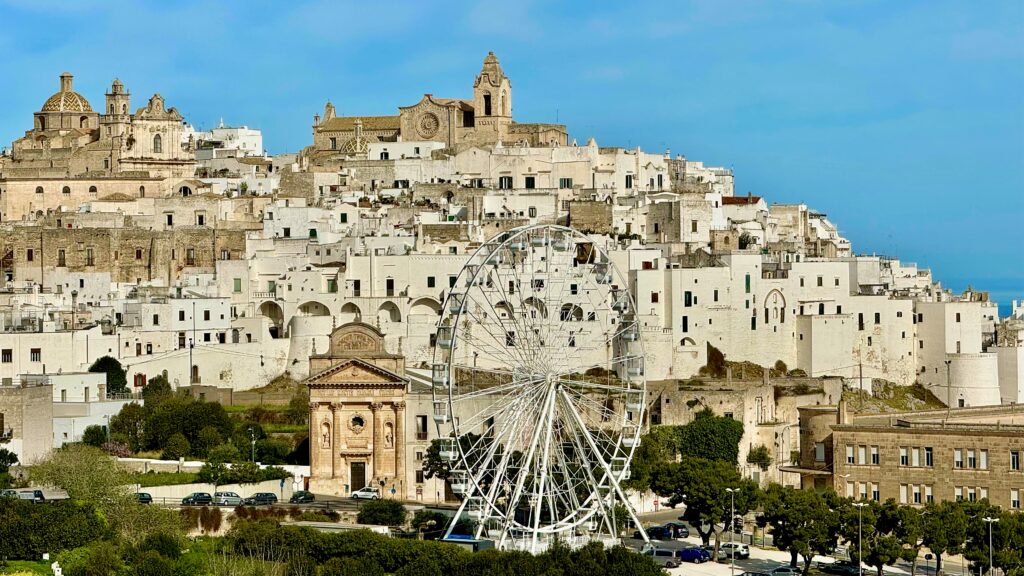
Ostuni is 40 km (about 25 miles, less than a 30 minute drive) north of Brindisi’s Salento airport and around 100 km (62 miles, a little over an hour’s drive) from Bari airport. Ostuni’s train station is on the Bari – Lecce regional train line. A modern, efficient and reliable train service runs regularly connecting Ostuni to Monopoli, Polignano, Bari and to Brindisi and Lecce. However the train station is approximately 3.5km from town, connected by a bus service and occasional taxis!
Nestled atop seven hills and overlooking the shimmering Adriatic Sea, Ostuni is a vision of whitewashed charm and historical grandeur. This ancient town, home to approximately 33,000 inhabitants (visitors swell numbers to around 200,000 at the peak of Italy’s summer season), sits just six kilometres from the coast. Divided into the lower coastal region known as the “Marina” and the higher inland area called the “Selva,” Ostuni presents a mix of rolling hills, olive groves, and labyrinthine streets waiting to be explored.
The white walls and buildings of the old town gleam in the distance and can be seen as you drive along the main coastal highway.
Insider Tip | The best views driving into Ostuni are from the E55 (SS379) Adriatic coastal highway along the SP19 (take the exit at Pilone coming down from the north/Bari) or from the SP21 (take the Torre Pozzella exit coming up from the south – Lecce/Brindisi) turning off at the Contrada Rosaria fork as you climb to approach Ostuni. The latter route will also take you to the municipal pay and display car park we often use (see Parking).
On top of that, Ostuni is where we are based and meet up as a team over the summer months. We know it well!
A Walk Through History
Ostuni’s heart is its historic centre, “La Terra,” perched atop a lone hill and enclosed by imposing defensive walls adorned with cylindrical towers. This medieval stronghold is a maze of narrow, winding streets, staircases, and stone arches, revealing the town’s fortified past. Originally accessed through five gates—only Porta Nova remains intact—Ostuni’s defences once included towering battlements and machicolations, designed to ward off invaders.
At the summit, amidst an enchanting sea of whitewashed terraces, stand the city’s historic treasures: the Norman castle, the bishop’s palace, and the magnificent cathedral. The nearby Piazza della Libertà, formerly home to military barracks, a courthouse, and a Franciscan convent, now serves as the town’s bustling central square.
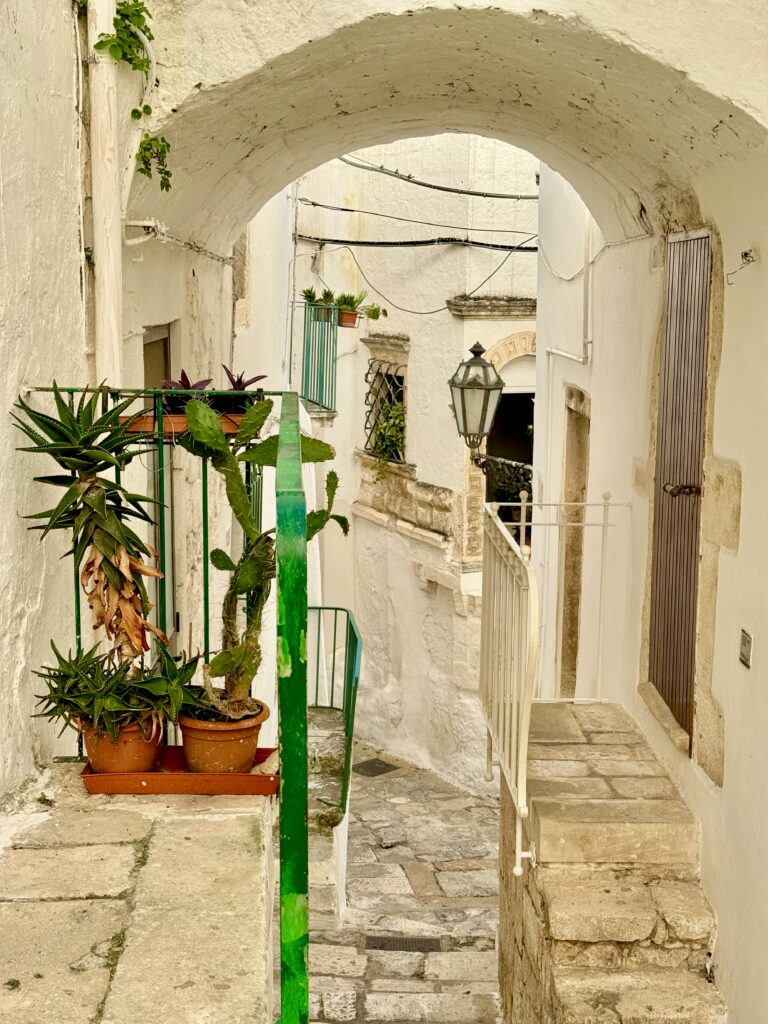
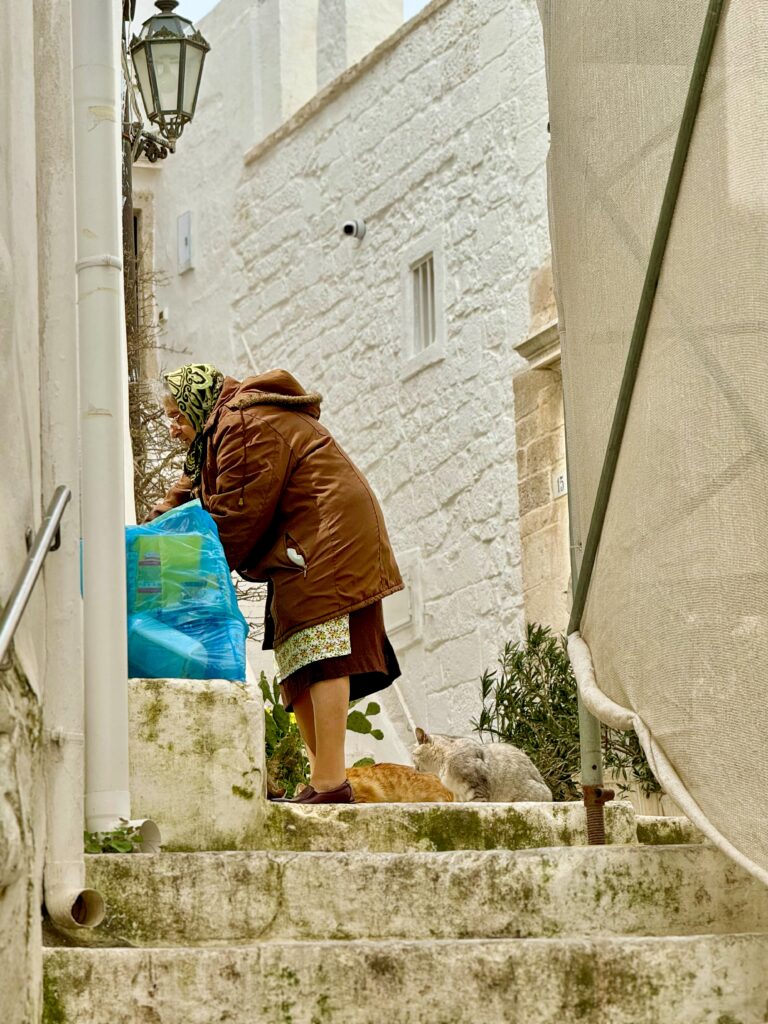
The Evolution of a Timeless City
Ostuni’s origins trace back to the Messapian civilisation, evidenced by archaeological findings. The town endured destruction during the Second Punic War (216 BC), later emerging as the Roman settlement of Stunium. Rebuilt by Byzantine Emperor Basil I in 876 AD, Ostuni adopted Greek-influenced architectural elements, monastic traditions, and even olive cultivation techniques, many of which endure to this day.
Through centuries of shifting rule—from Norman control in 1046 to various feudal lords and finally under the Aragonese dynasty—the city flourished. Despite changing governance, Ostuni maintained a strong sense of identity, reflected in its expanding districts. By the 16th and 17th centuries, it had grown beyond its medieval walls, creating vibrant new quarters, each with its own distinct character.
A Tour of Ostuni’s Landmarks
Arriving in Ostuni, visitors are greeted by an awe-inspiring view: a brilliant white cityscape cascading down the hillside, its pristine facades contrasting with the surrounding greenery. The journey into the town begins along Corso Mazzini, leading to Piazza della Libertà, a lively square dominated by the grand municipal building—once a Franciscan convent—and the Church of San Francesco d’Assisi. At the far end stands the stunning Spire of Sant’Oronzo, a Baroque masterpiece sculpted by Giuseppe Greco in 1771.
Ascending further, one arrives at Ostuni’s crowning jewel, the Cathedral of Santa Maria Assunta. Constructed in the late 15th century, this architectural marvel showcases a fusion of late Romanesque, Gothic, and early Renaissance styles, influenced by Adriatic and Venetian traditions. Its undulating façade features intricately carved portals, pilasters, and three exquisite rose windows, with the central one being among Puglia’s finest.
Exploring the old city’s narrow alleyways, staircases, and sunlit courtyards, visitors are transported to another era. The dazzling whitewashed walls, a legacy of Byzantine influence, create a luminous atmosphere, while hidden viewpoints offer breathtaking vistas over the olive-covered valley stretching towards the Adriatic.
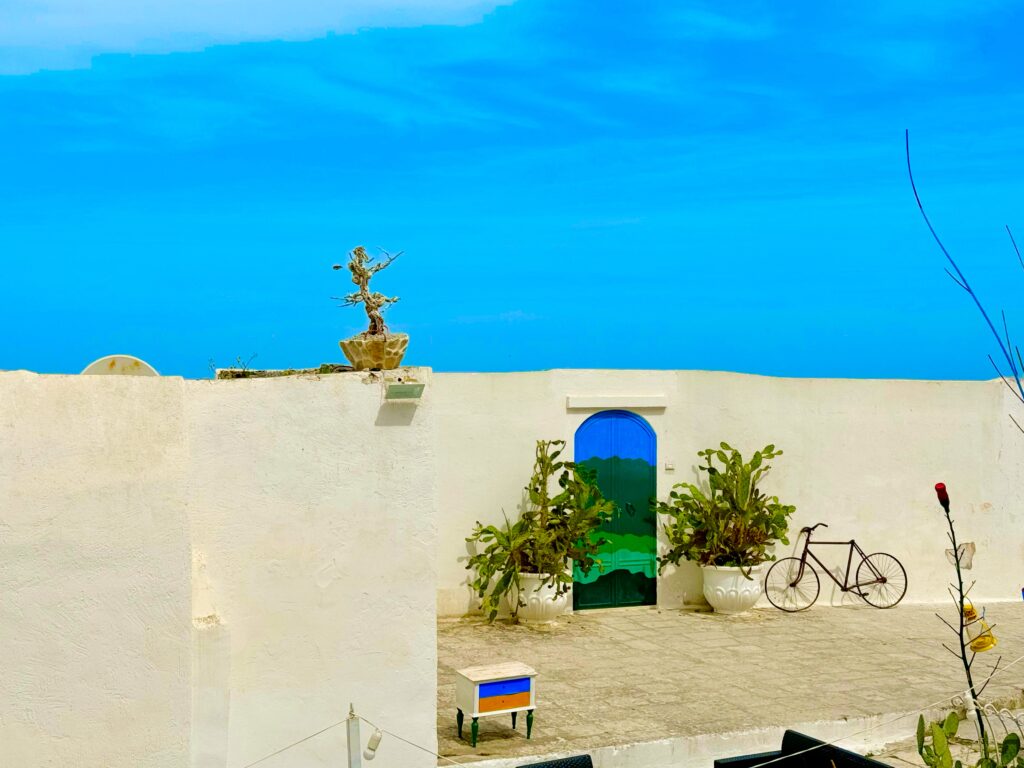
In our Ostuni Guide:
- 1. Where to eat | Ostuni guide recommended bars and restaurants
- Ostuni Bistrot | restaurant
- Al Solito Posto – Ristorante Pizzeria
- Casa San Giacomo | restaurant
- Ristorante Trattoria Fave e Fogghje
- Gabó | restaurant, lounge bar
- Osteria Monacelle | restaurant
- La Pastasciutta | pasta restaurant
- Tito Schipa | for spaghetti all’assassina
- Caffè Fanelli Bistrot | bar
- Borgo Antico Bistrot | bar
- Les cre’ fantastique | panzerotti eat in
- Asso di Spade | panzerotti to go
- Gelaterie | for gelato artigianale
- Ostuni outskirts
- Where we avoid
- 2. Ostuni guide | our favourite nearby beaches
- 3. Where to park | the Ostuni guide to parking
- 4. La città bianca, Puglia's White City | what to see and do
- 5. Where to stay in Ostuni | the Ostuni guide to selected accommodation
- 6. Ostuni Guide | The best time to visit Ostuni
- 7. Aperitivo time | the best value Aperol Spritz on Ostuni’s main piazza
- 8. Ostuni guide | Day trip planning and road trips from Ostuni
- 9. Ostuni guide | Adding value to your Ostuni vacation
- 10. Eating in | Ostuni guide to food and wine shopping
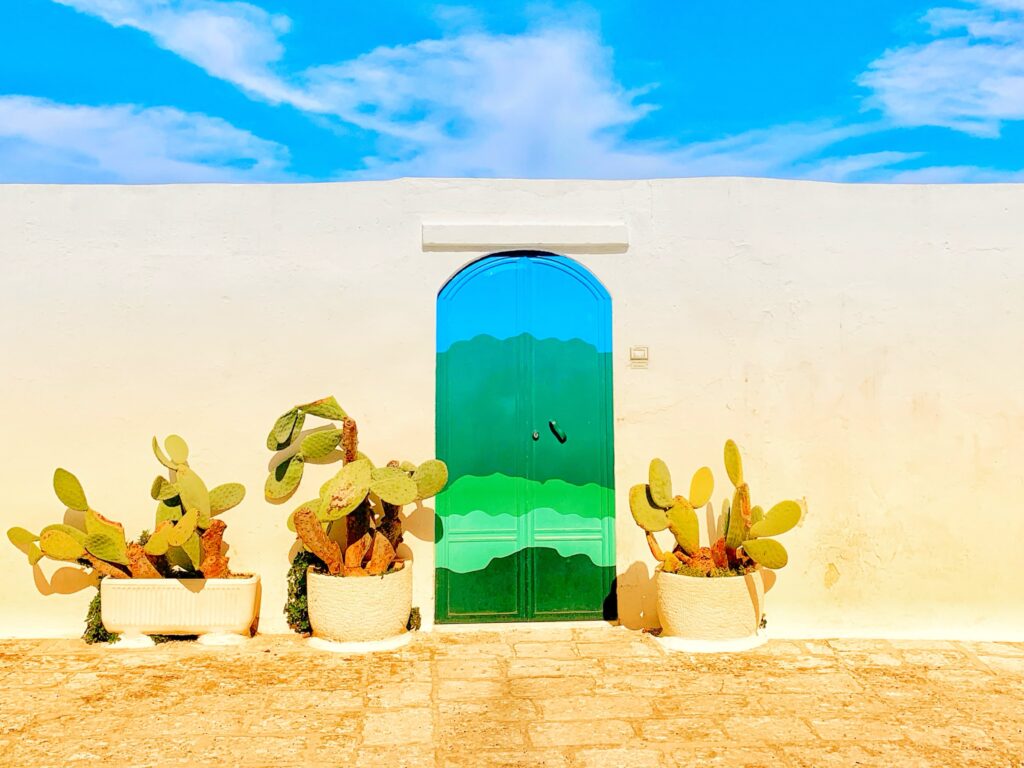
1. Where to eat | Ostuni guide recommended bars and restaurants
The choice of dining experiences in Ostuni during the summer season seems endless. Excellent restaurants and chic bars are tucked away in the maze of medieval alleys, arches and stairwells of the old town that shoot out from via Cattedrale and wind around the duomo and the old town walls.
While bad food is hard to find some restaurants offer better value than others. Many restaurants regularly recommended on travel forums are recommended by tourists and visited by more tourists, even though locals would not eat there. The food and dining experience may be good, but if it is comparatively overpriced without any added value, we haven’t included it.
We eat where locals eat and we pay for all our meals and review anonymously.
Ostuni Bistrot | restaurant
Family run restaurant serving traditional local dishes, offering good food and great value. Osteria Ostuni Bistrot is our favourite Ostuni lunch spot on the piazza. We are regular visitors and always take visiting friends.
The restaurant is located adjacent to the main piazza (📍Piazza della Libertà, 5) with a larger seating area on the main piazza. There is also a comfortable, air-conditioned inside seating area. We usually walk-in, without booking. But in summer, we will ask them to hold a table for us when we are passing by.
The seating area on the piazza is next to the seating area of another restaurant called ‘Petit Bistrot’ (Codice a Barre). Do not confuse one with the other. Ostuni Bistrot is where we want to eat. We do not eat at Petit Bistrot.
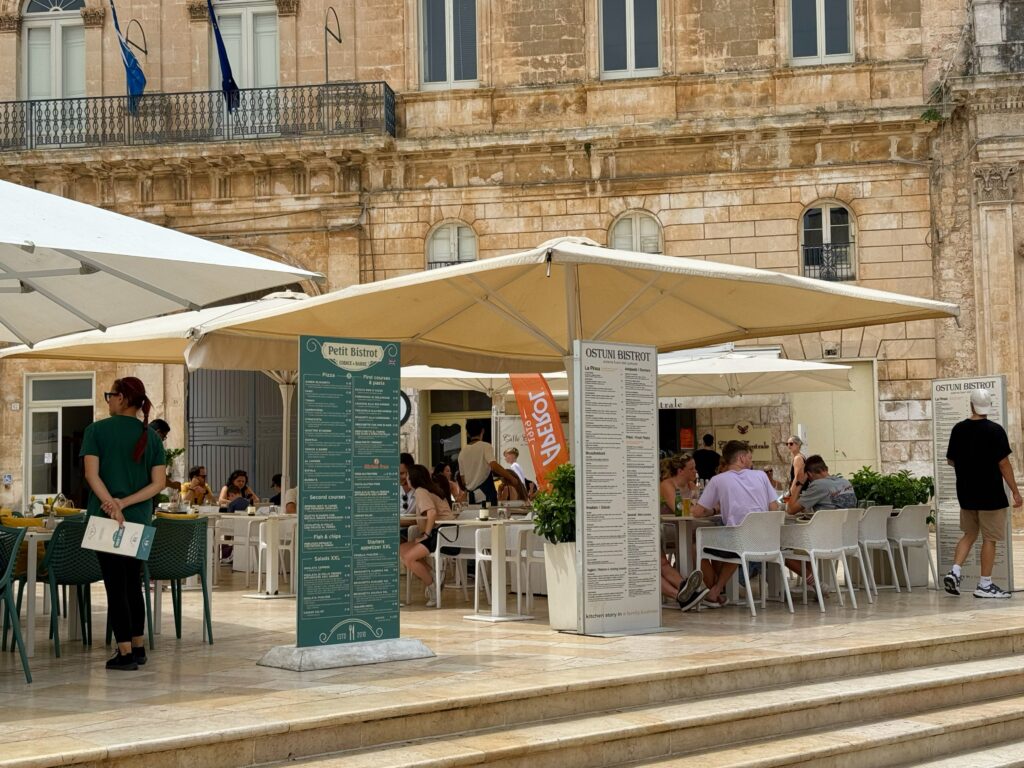
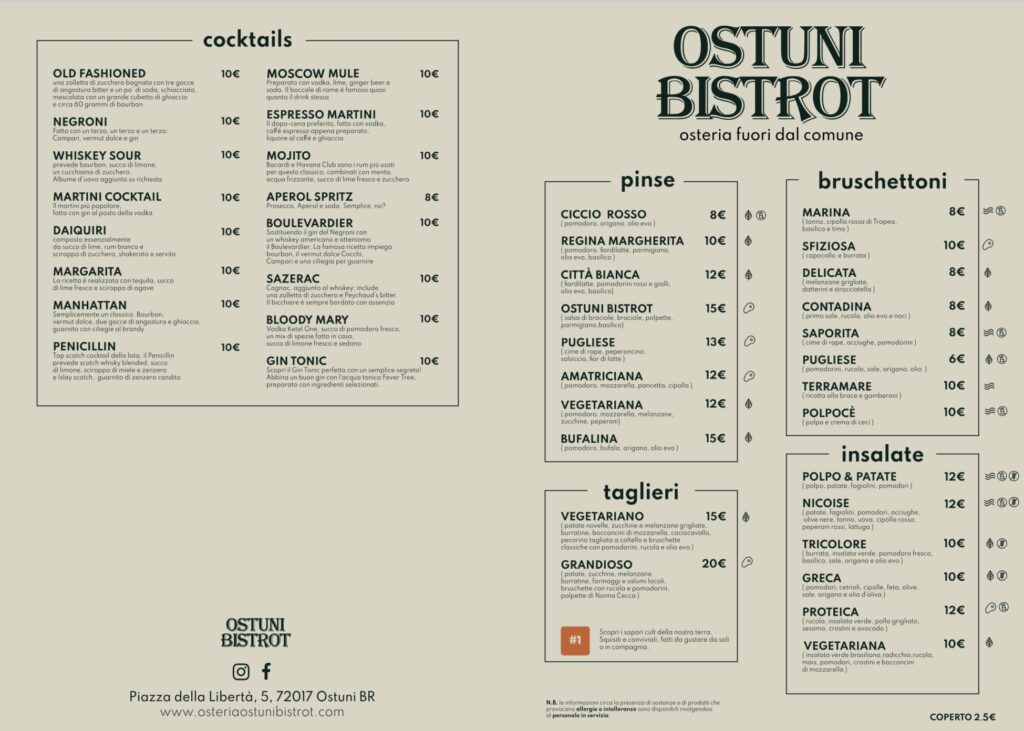
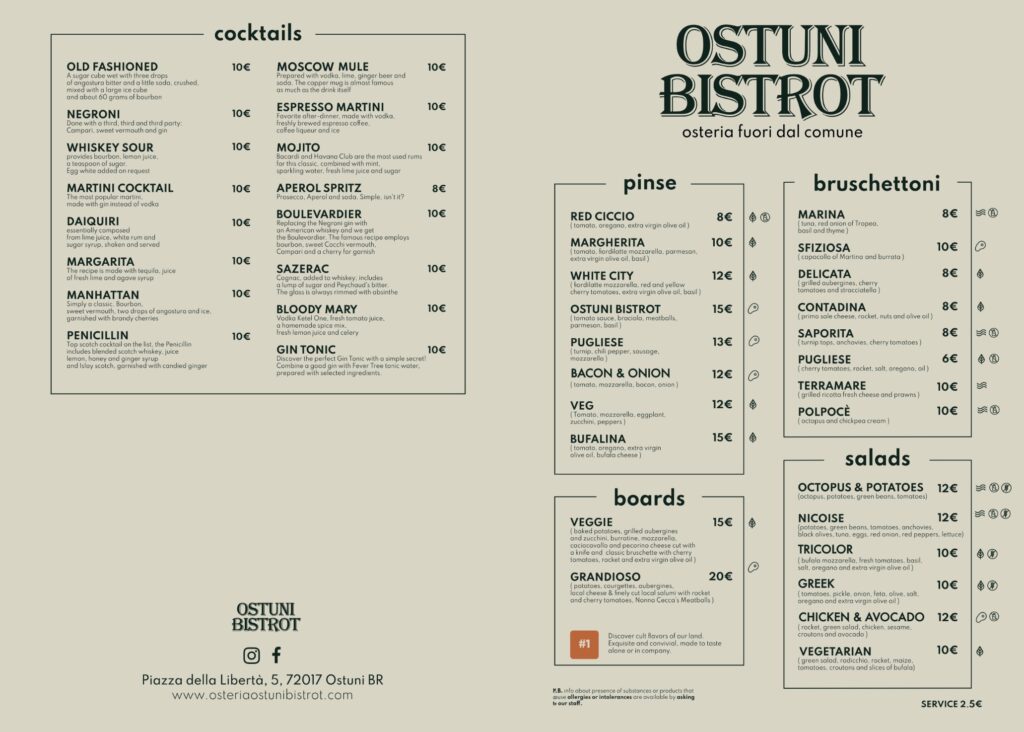
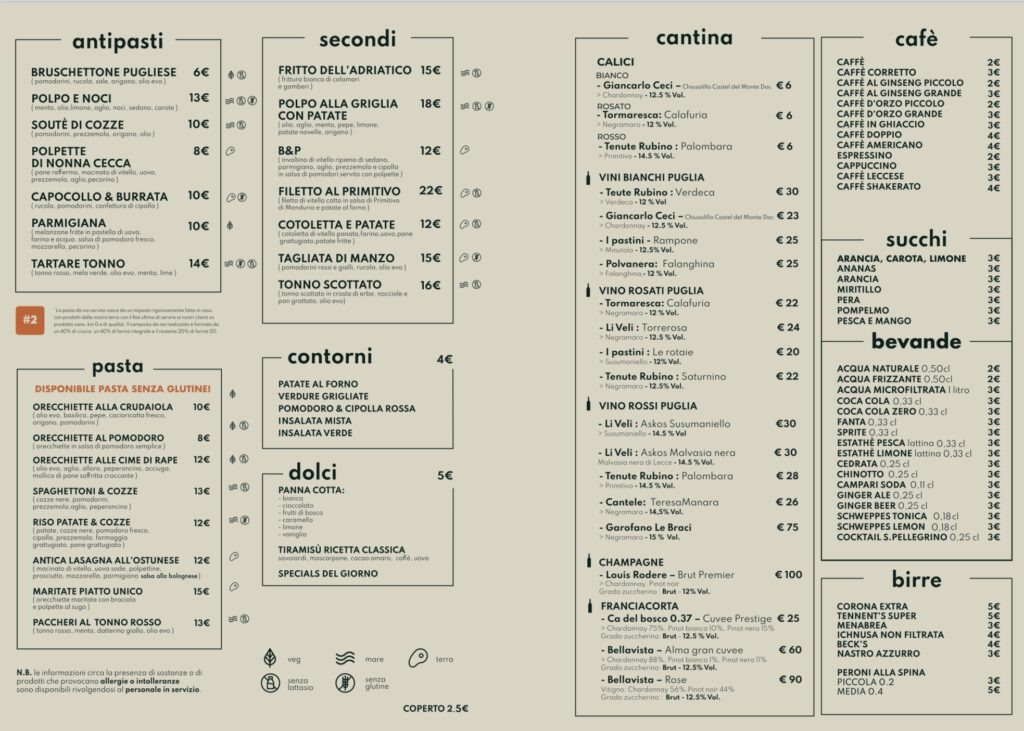
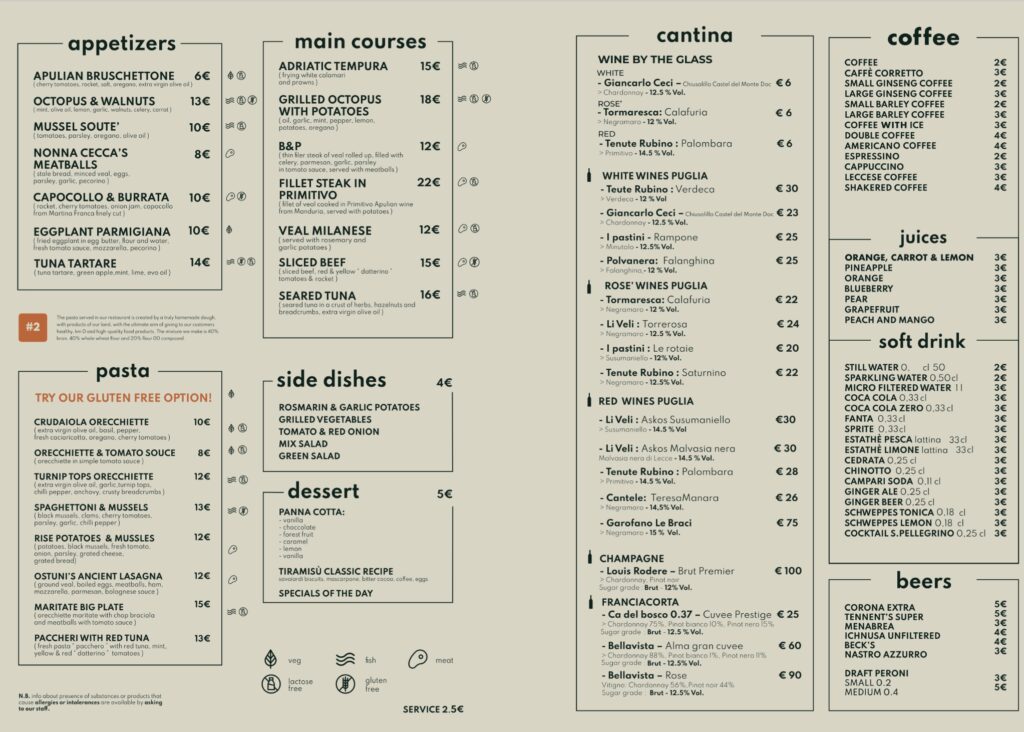
Pinsa | Unlike traditional pizza, which can be heavy and greasy, a pinsa is a lighter version perfect for lunch.
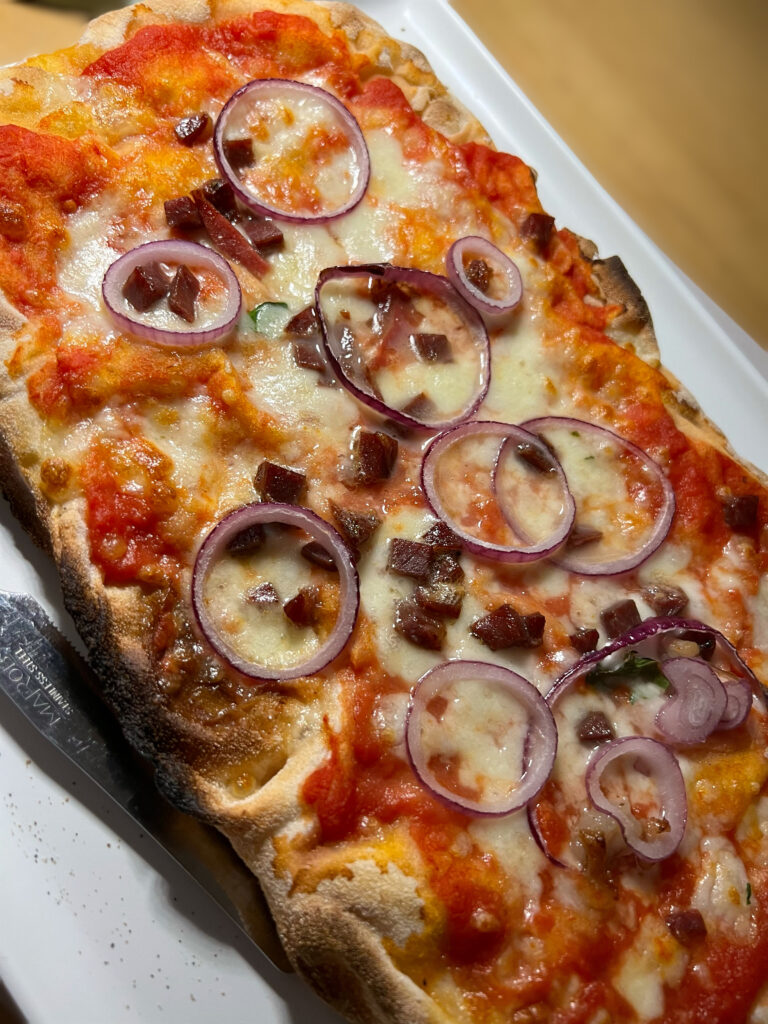
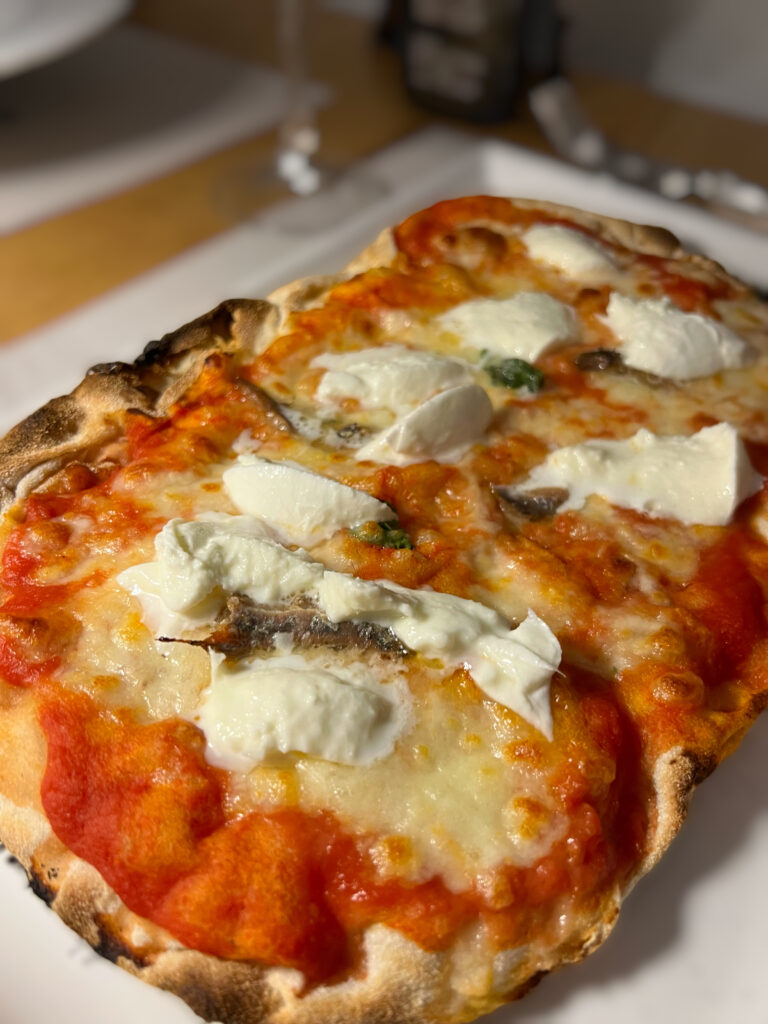
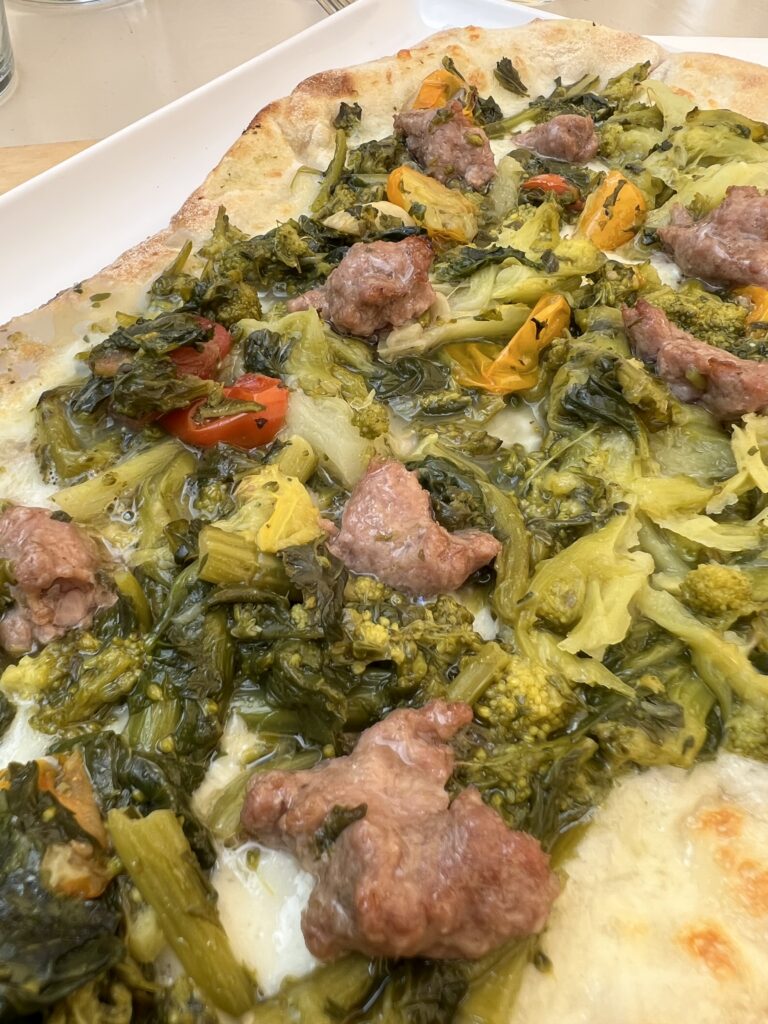
Taglieri | A charcuterie style sharing board. Generous and perfect as a shared appetiser for 3-4 people. If you want to change the balance of one of the boards for more vegetarian or meat choices, consider ordering one or the other with a side of polpette or bruschettoni.
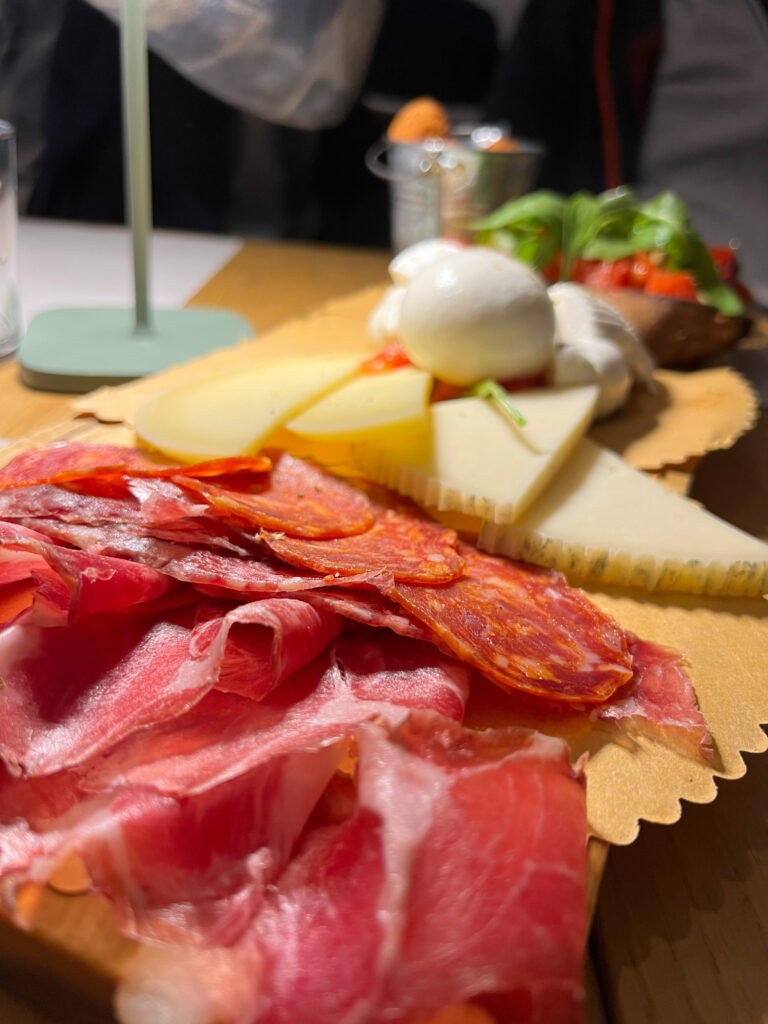
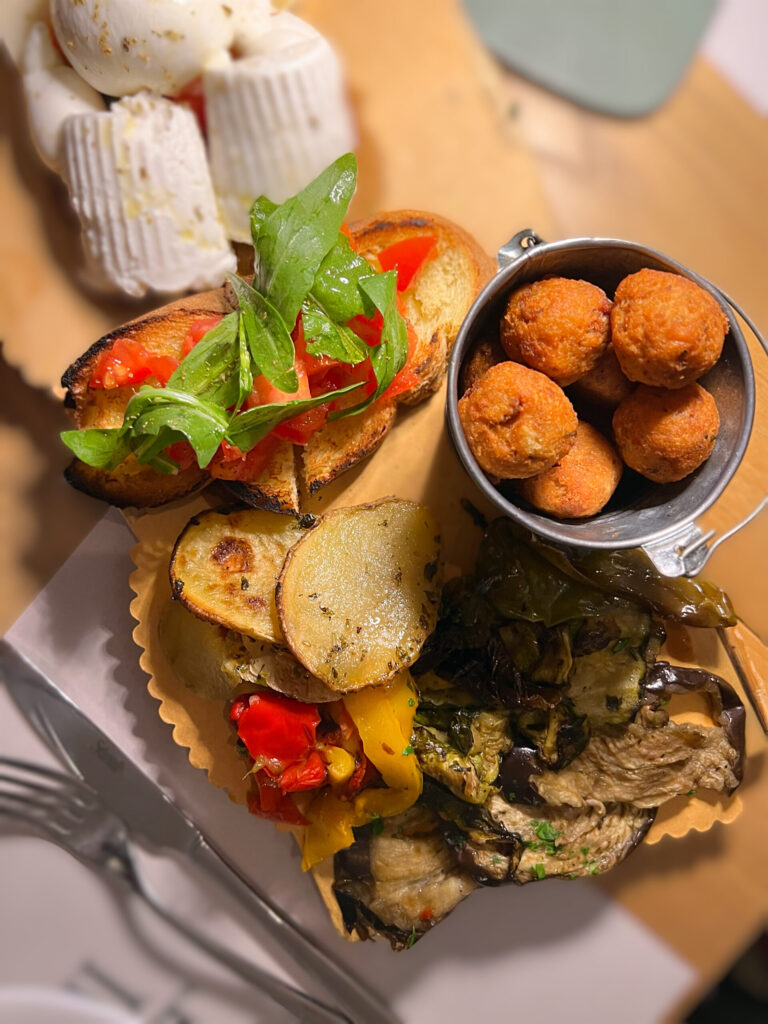
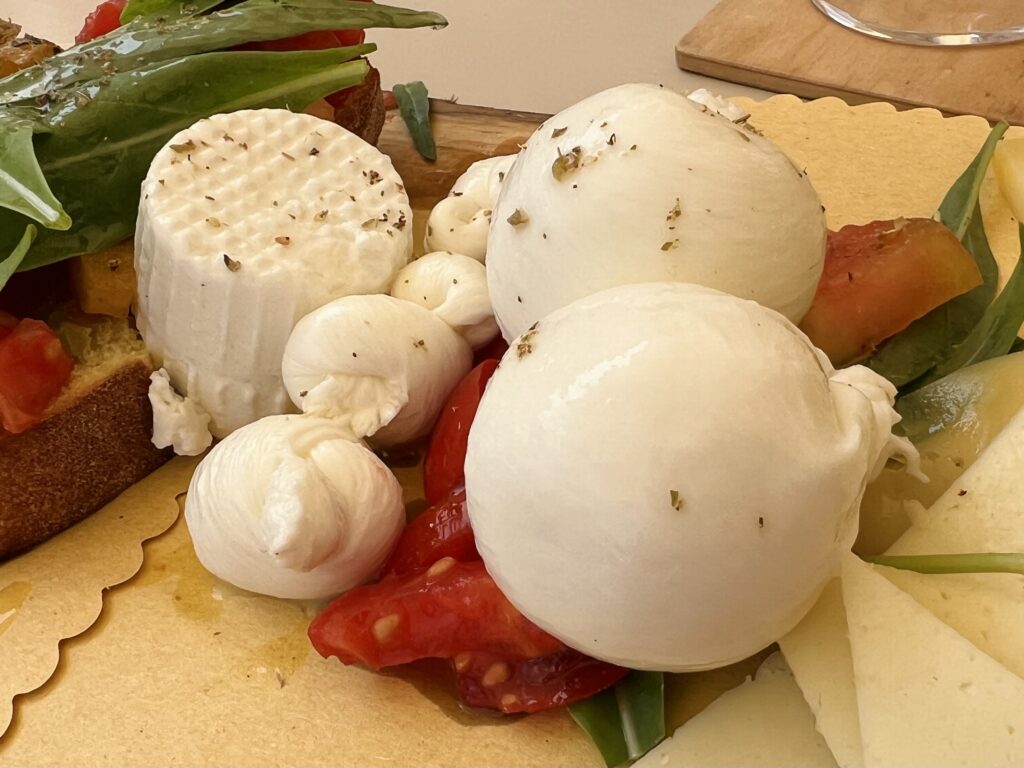
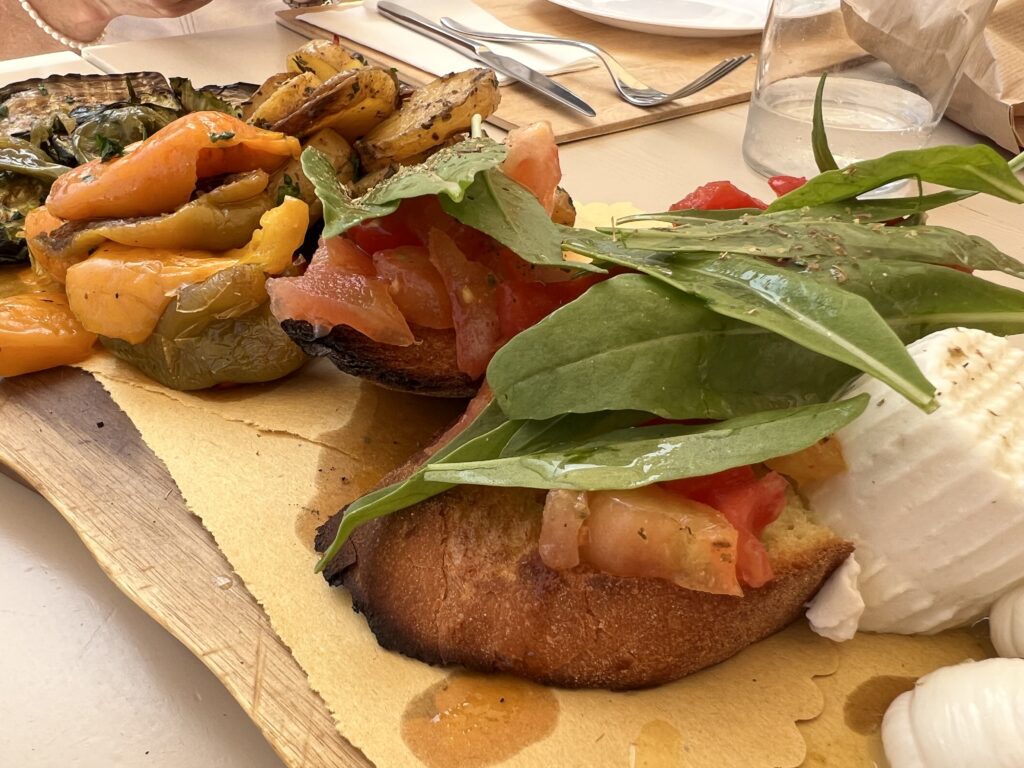
Bruschettoni | Smaller than bruschette, a crisp and light starter.
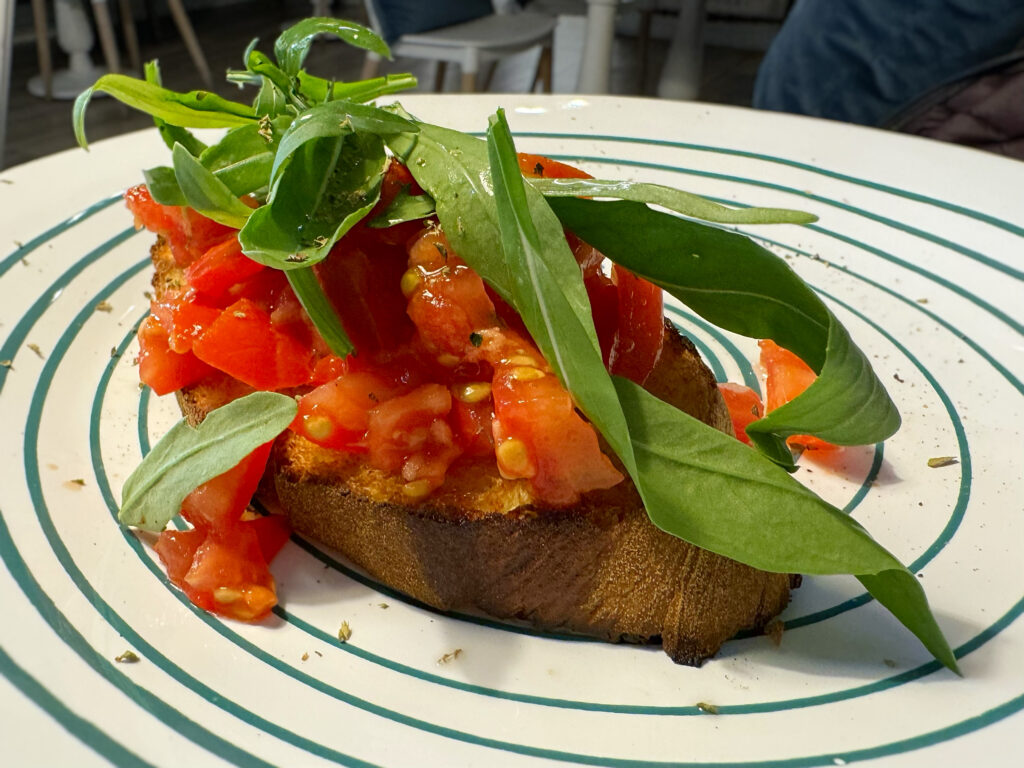
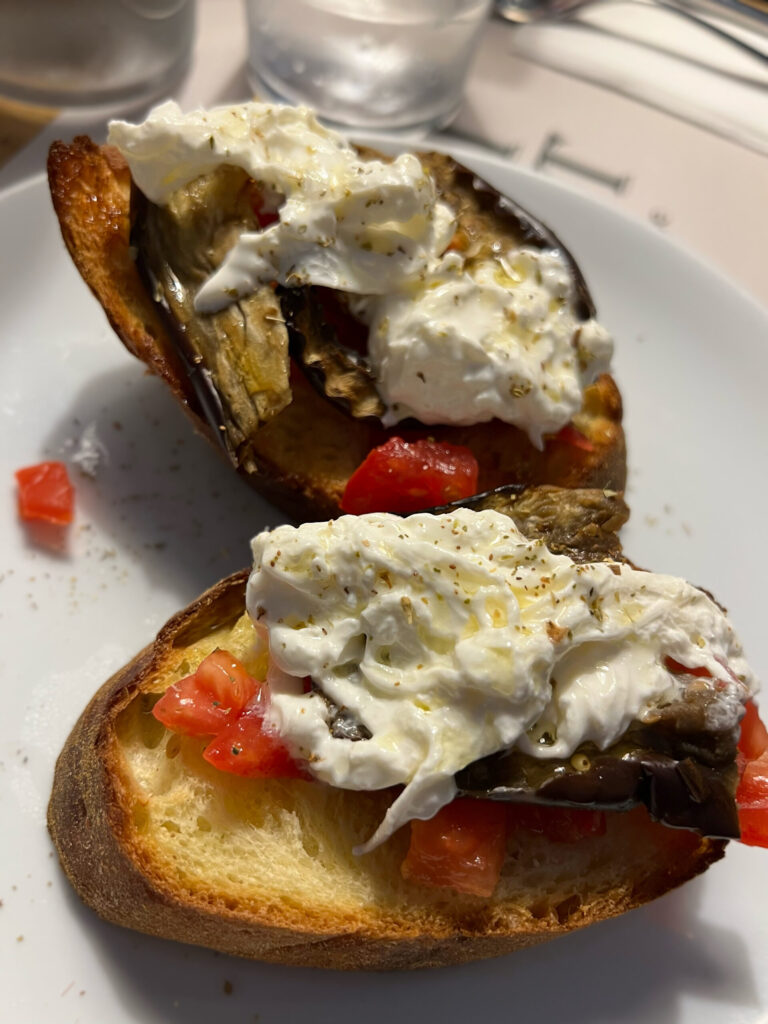
Insalata | Polpo and patate (potato and octopus) salad.
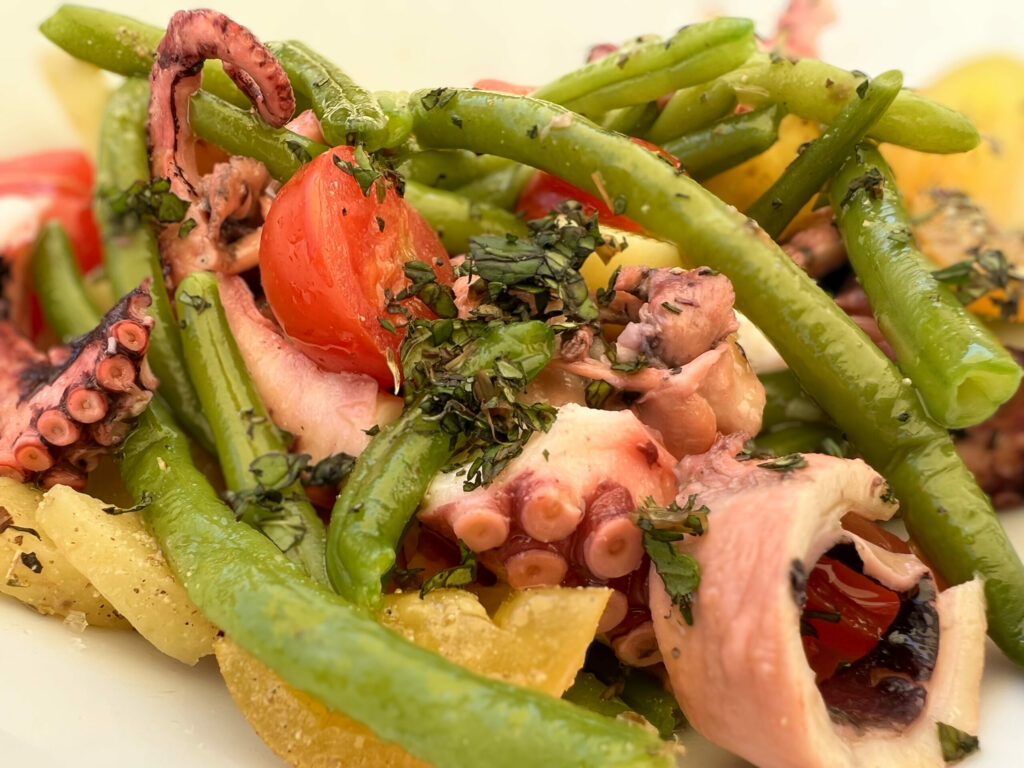
Antipasti | To nibble on we sometimes order polpette (traditional deep-fried bread and veal meatballs, light and crispy). The parmigiana is also delicious. Fave e cicoria (a fava bean puree) is not always on the menu, due to its seasonality. But you could always ask, as it is a great vegetarian option.
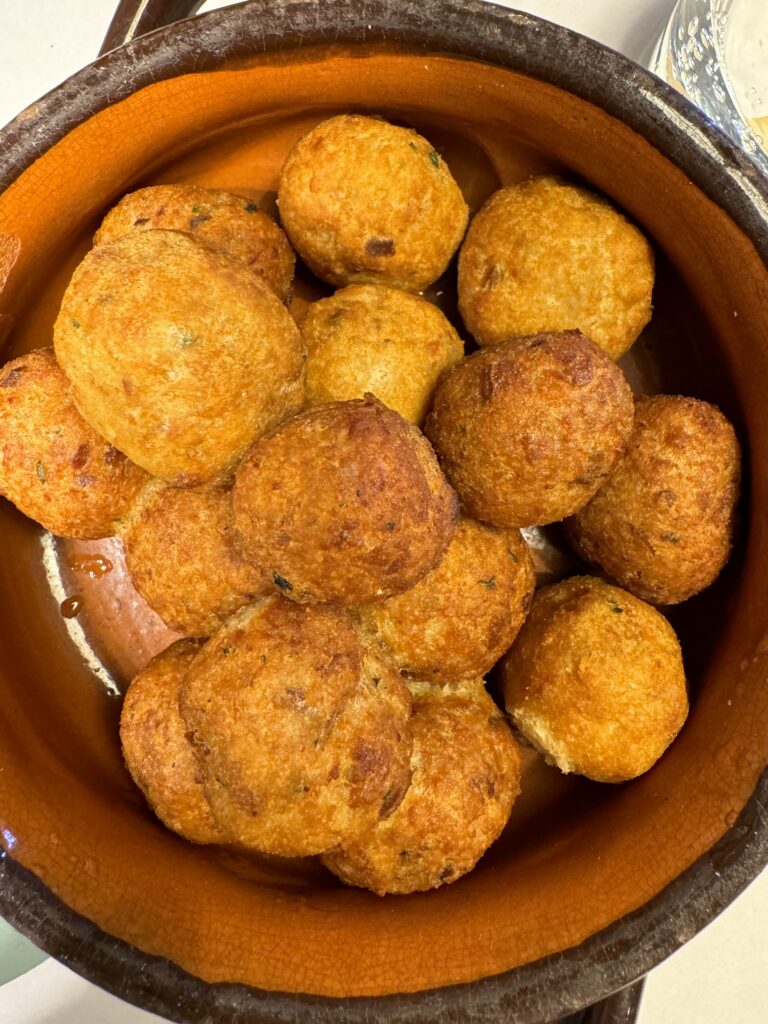
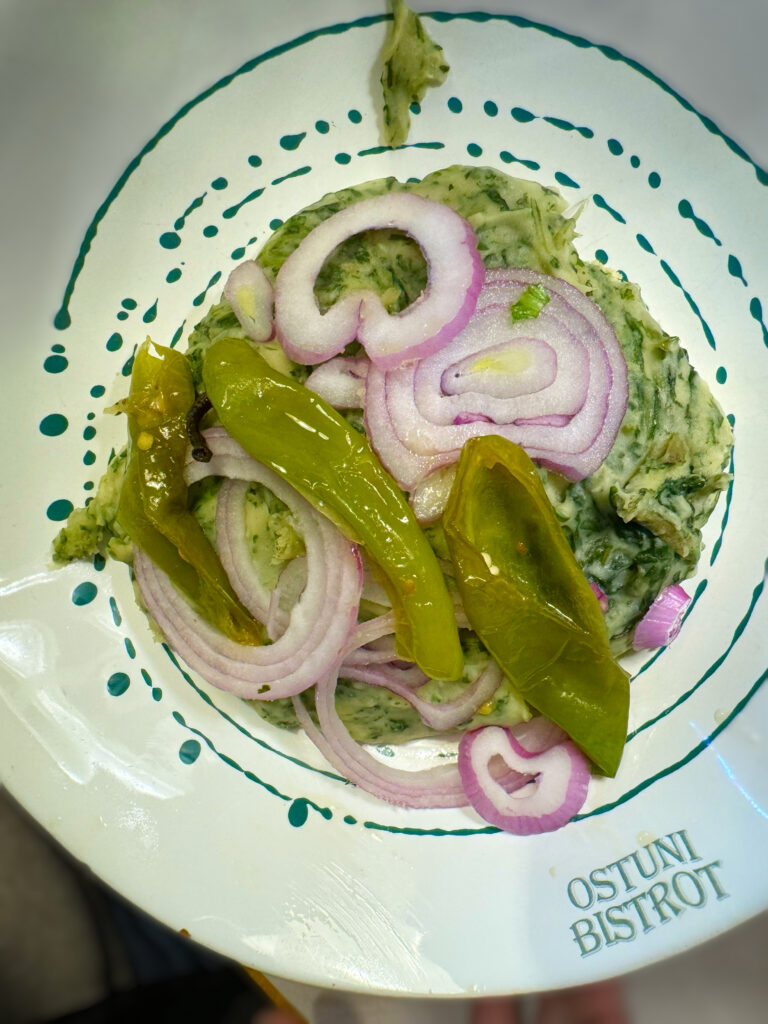
Pasta | In summer we often have the orecchiette alla crudaiola, a lighter pasta dish with fresh tomato and topped with cacioricotta cheese. Eat it inside, or outside.
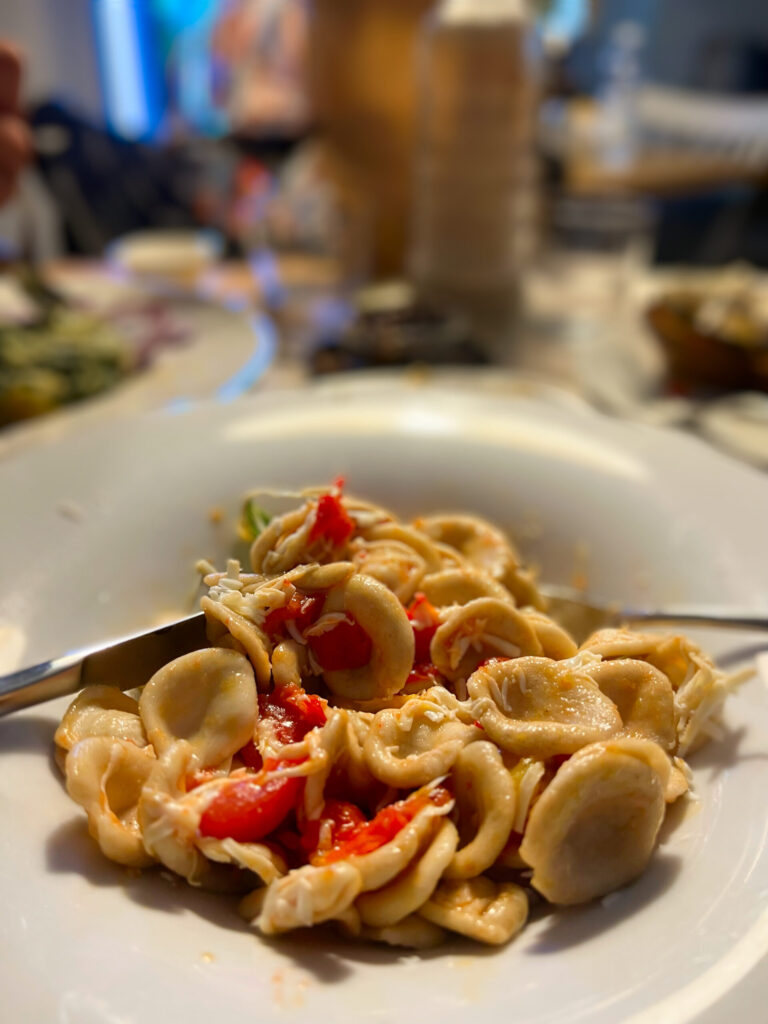
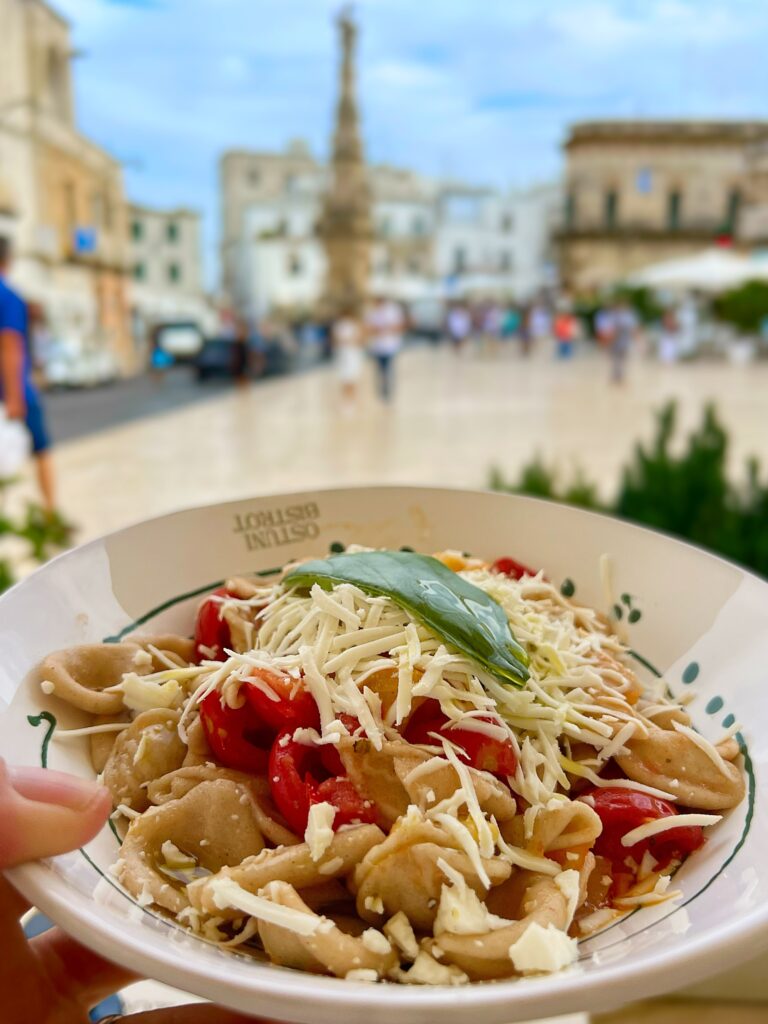
Orecchiette al pomodoro is served in a traditional tomato sauce. The orecchiette alle cime di rape is perhaps Puglia’s most traditional dish. Cime di rape (often translated as turnip tops, though in fact they more closely resemble tenderstem broccoli albeit bitter and with a softer texture) is a bitter green. The Ostuni Bistrot version is not as bitter as some we have tasted.
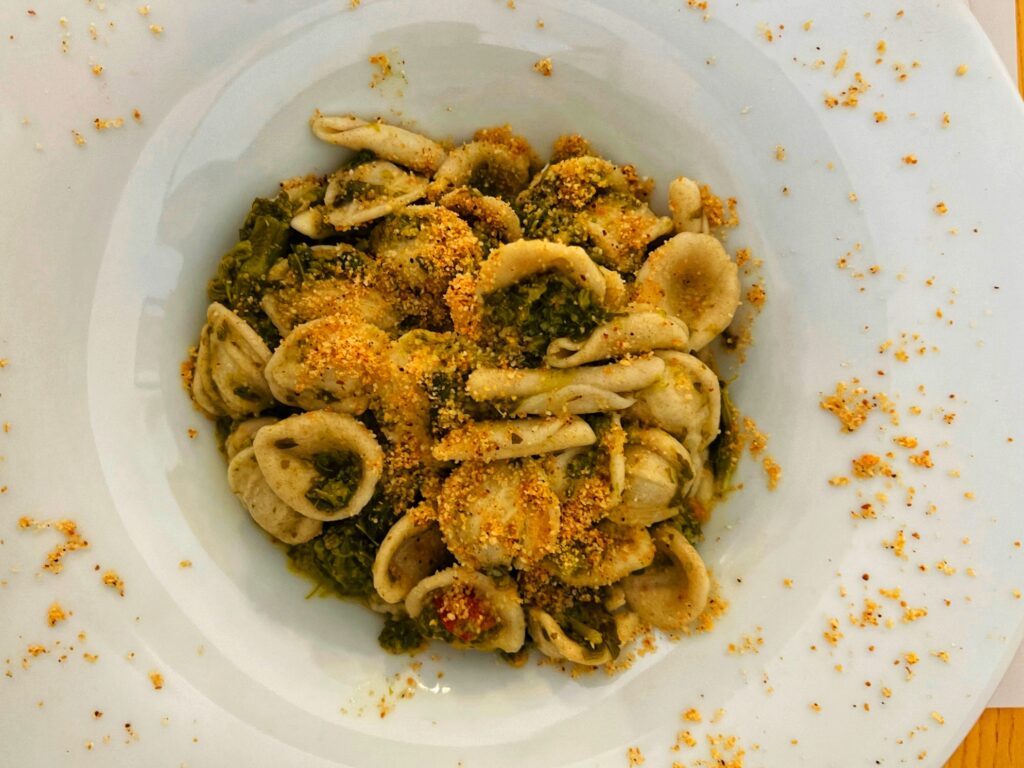
Spaghettoni and cozze (mussels) is another dish we visit often. Don’t ask for Parmesan with it – you will be politely told that the cheese overpowers the delicate seafood! Riso, patate e cozze is a traditional Bari dish with a comforting double carb hit of layered potato and rice, with mussels.
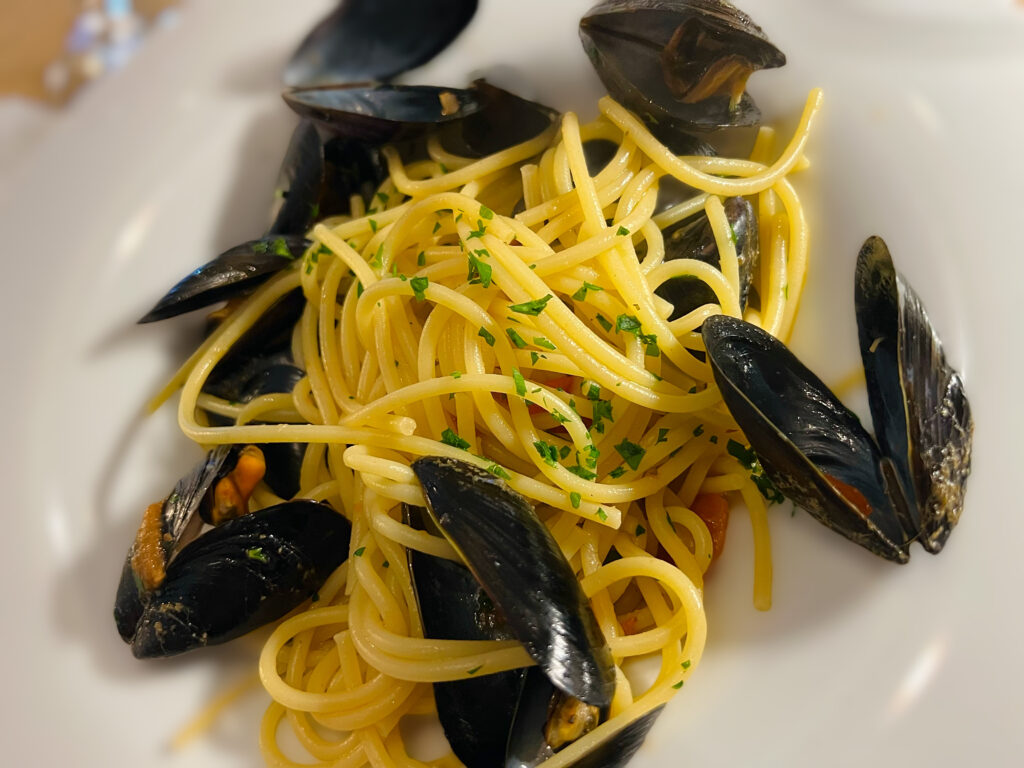
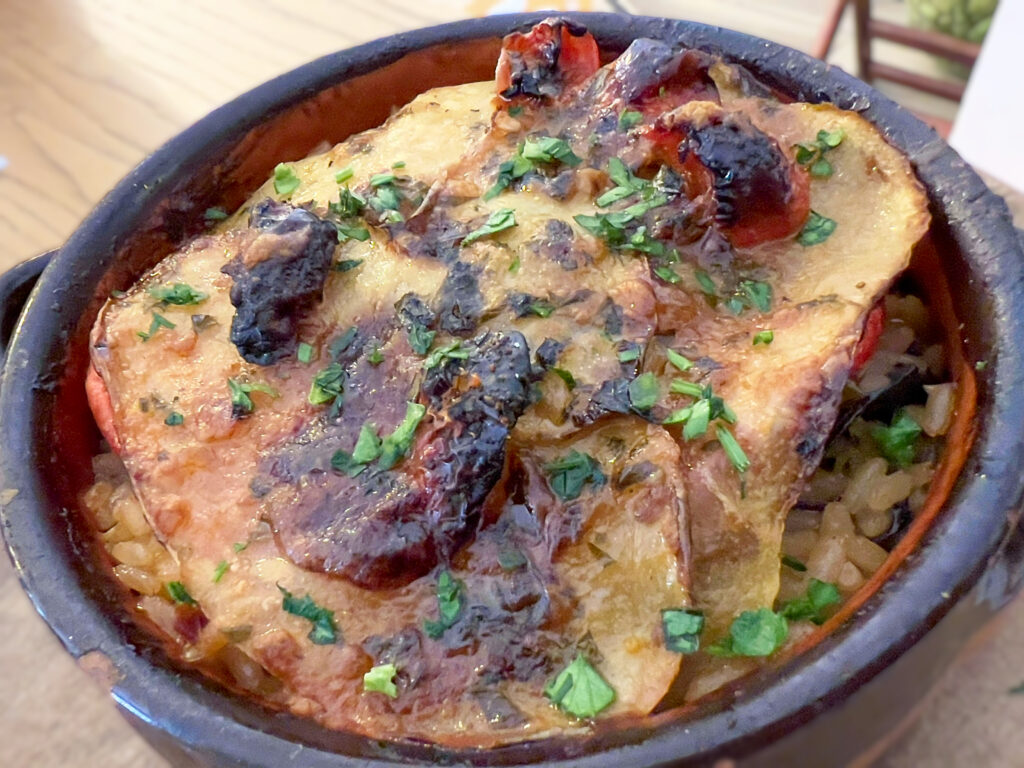
The lasagne is firm. ‘Maritato piatto unico’ is orecchiette pasta with polpette (meatballs) and braciole (thin slices of beef stuffed with prosciutto, pecorino, garlic, and herbs) slow cooked in a tomato sauce. It always blows us away.
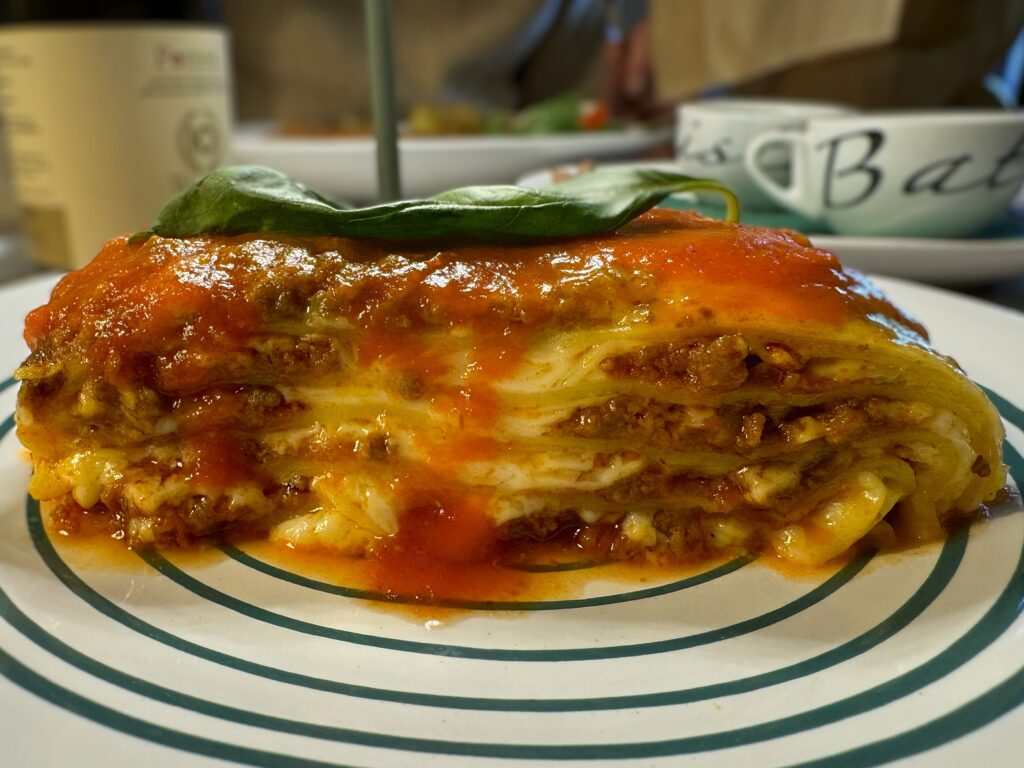
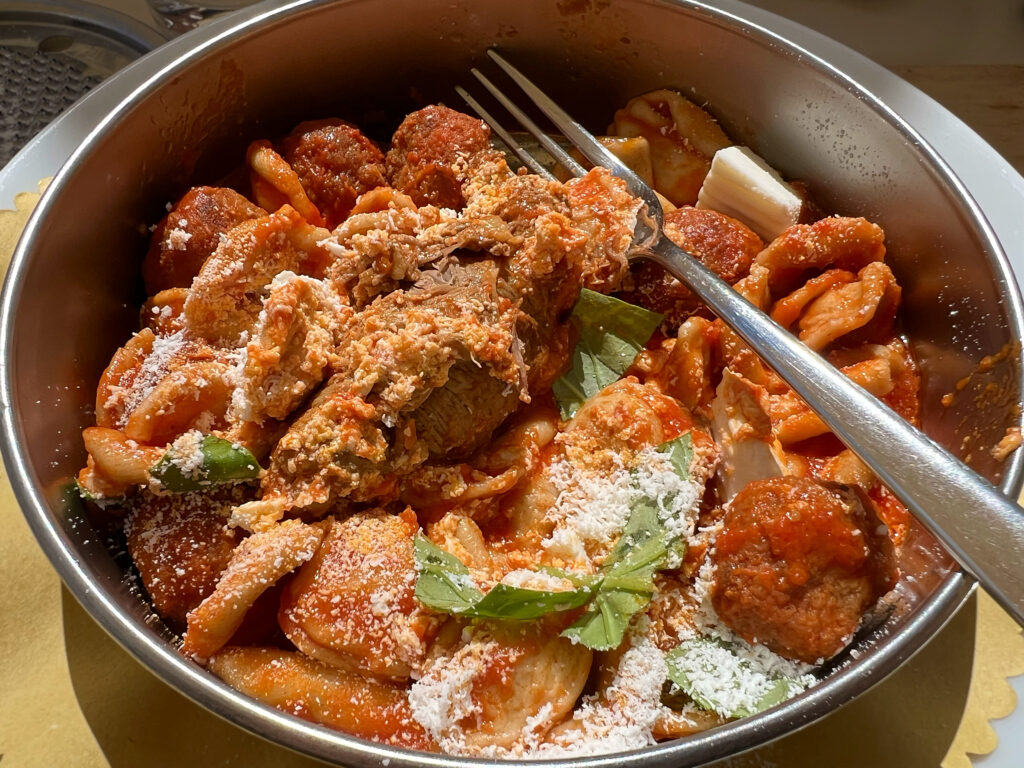
Paccheri al tonno rosso is a lighter pasta dish especially good in the summer.
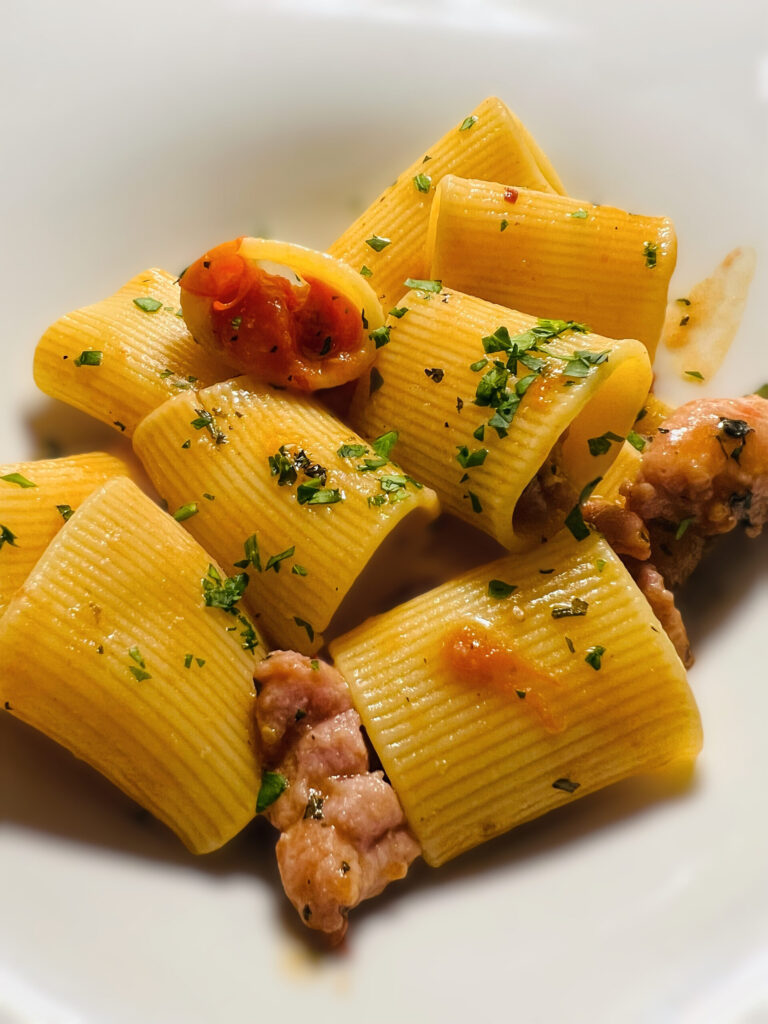
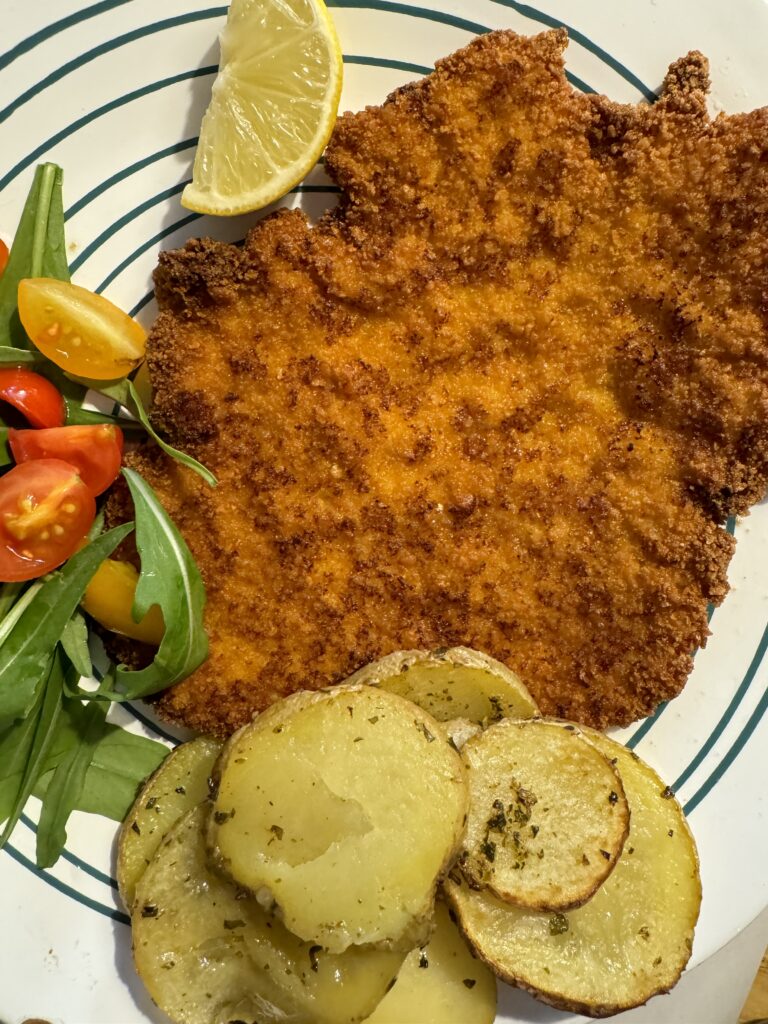
Secondi | The cotoletta al patate beats any cotoletta we have had in Milan. Fritto dell’Adriatico has prawn and calamari from the Adriatic, fried light and crisp.
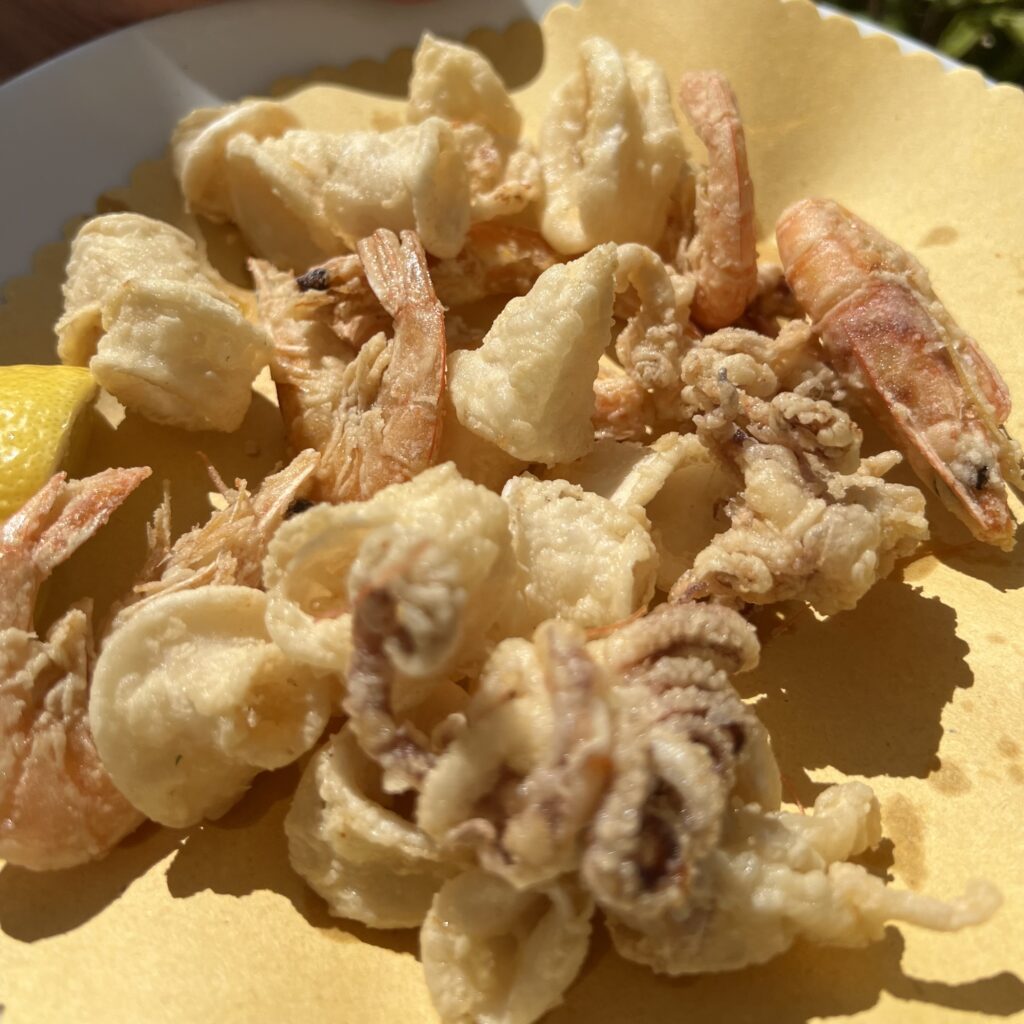
The grilled octopus is equally delicious. We usually finish our meal with the panna cotta – al caramello is our favourite topping.
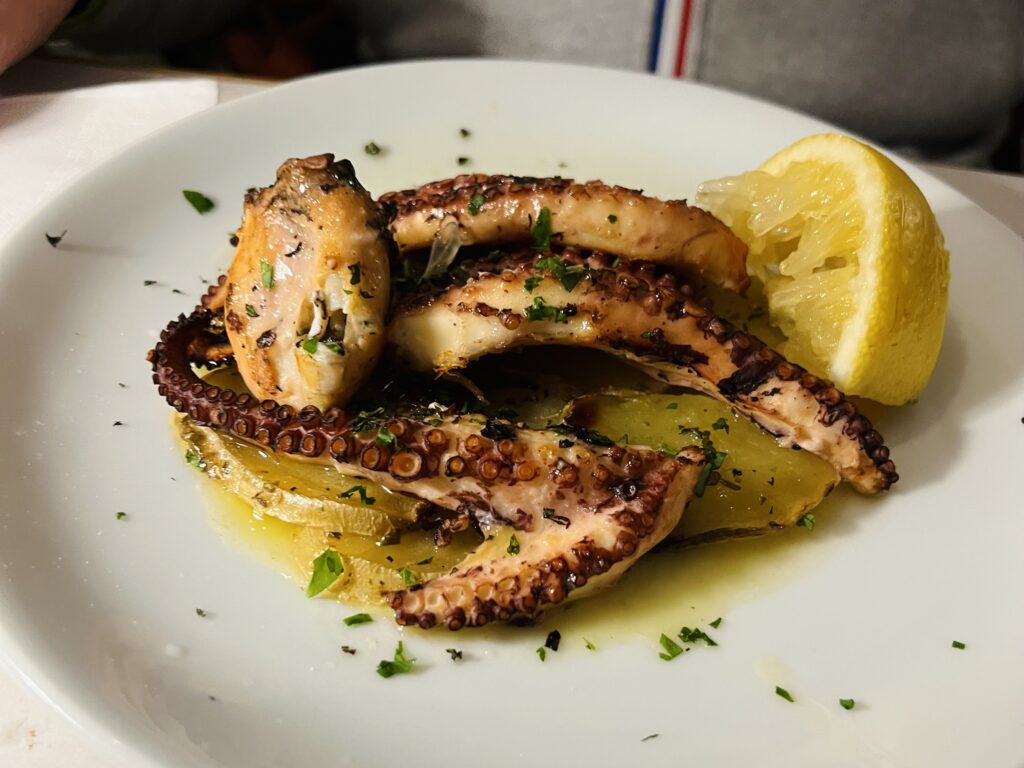
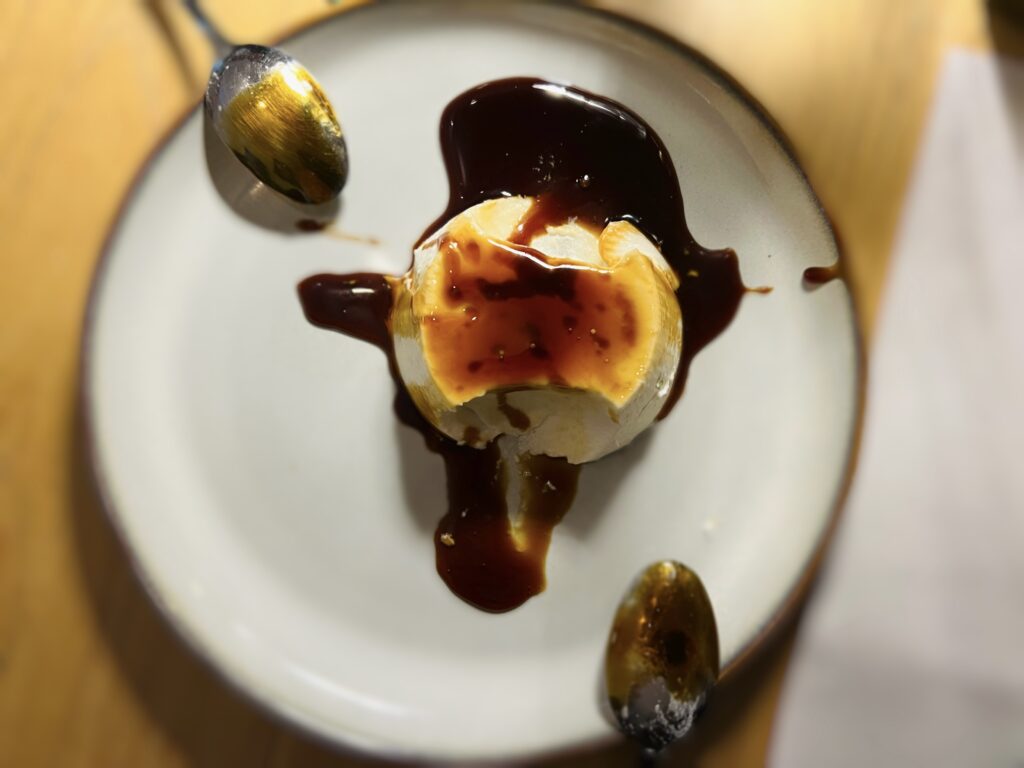
Al Solito Posto – Ristorante Pizzeria
Ostuni’s best pizza. Highly rated by locals, many of whom will tell you that it’s not only the best pizze but also the best desserts. Andre thought the pizza base was the best he had ever had (anywhere). We also shared some great starters.

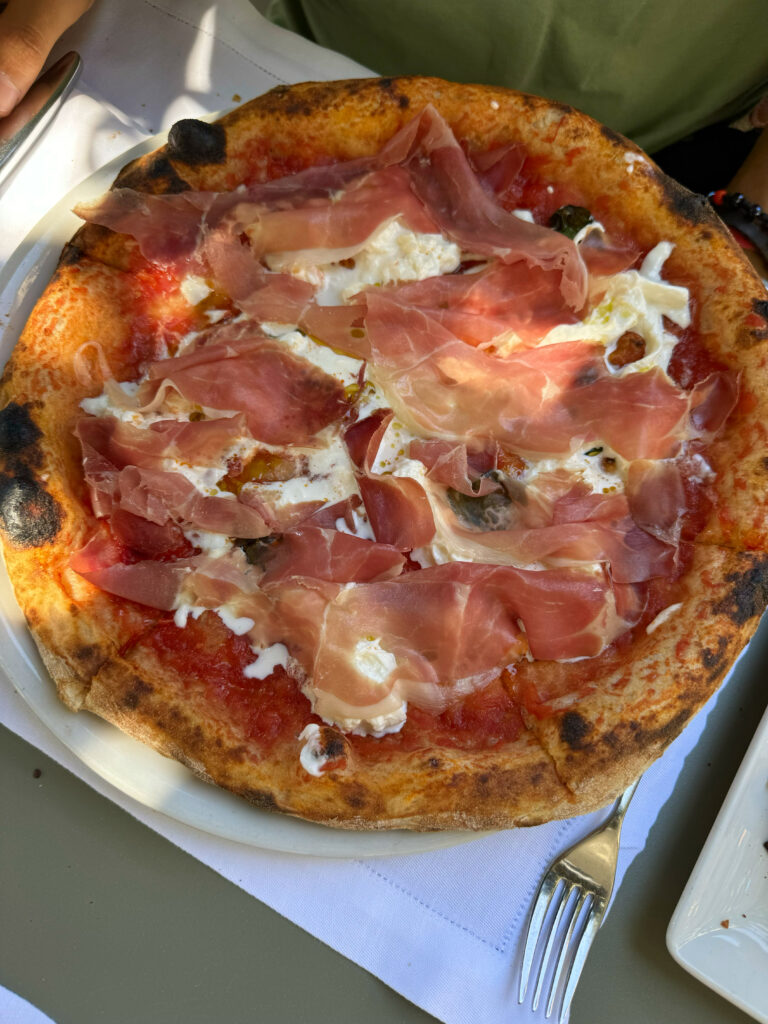
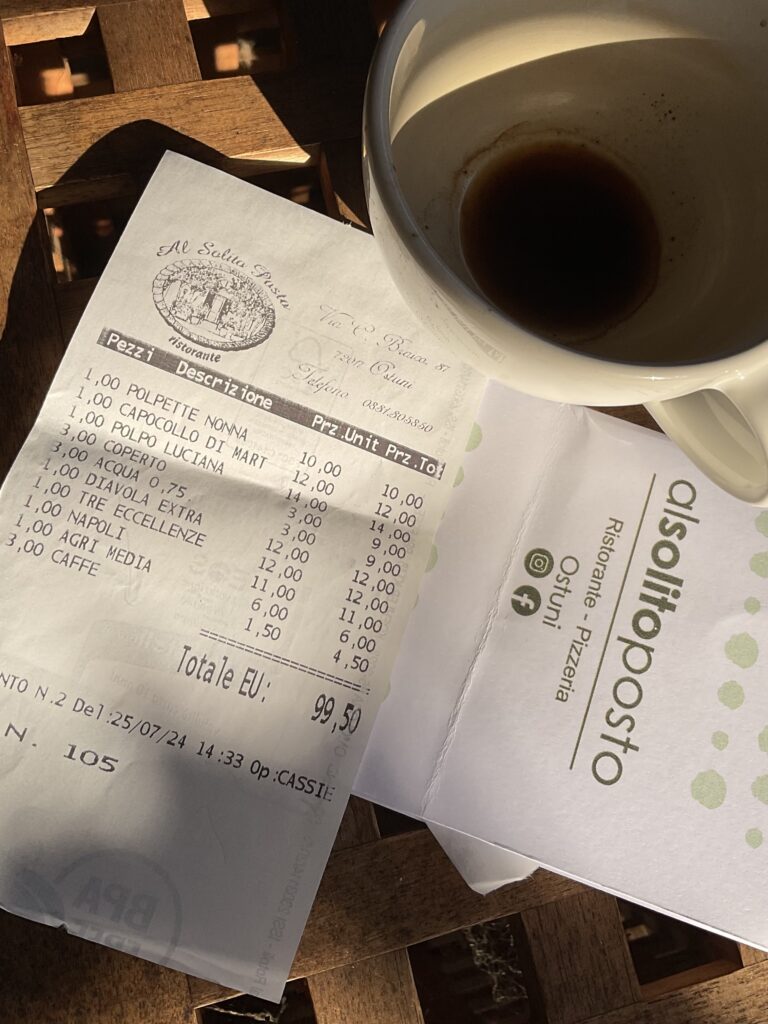
The pasta dishes are equally impressive. And the desserts are just as special. Al Solito Posto offers fantastic food at great value, and should definitely be on your #EatOstuni list.
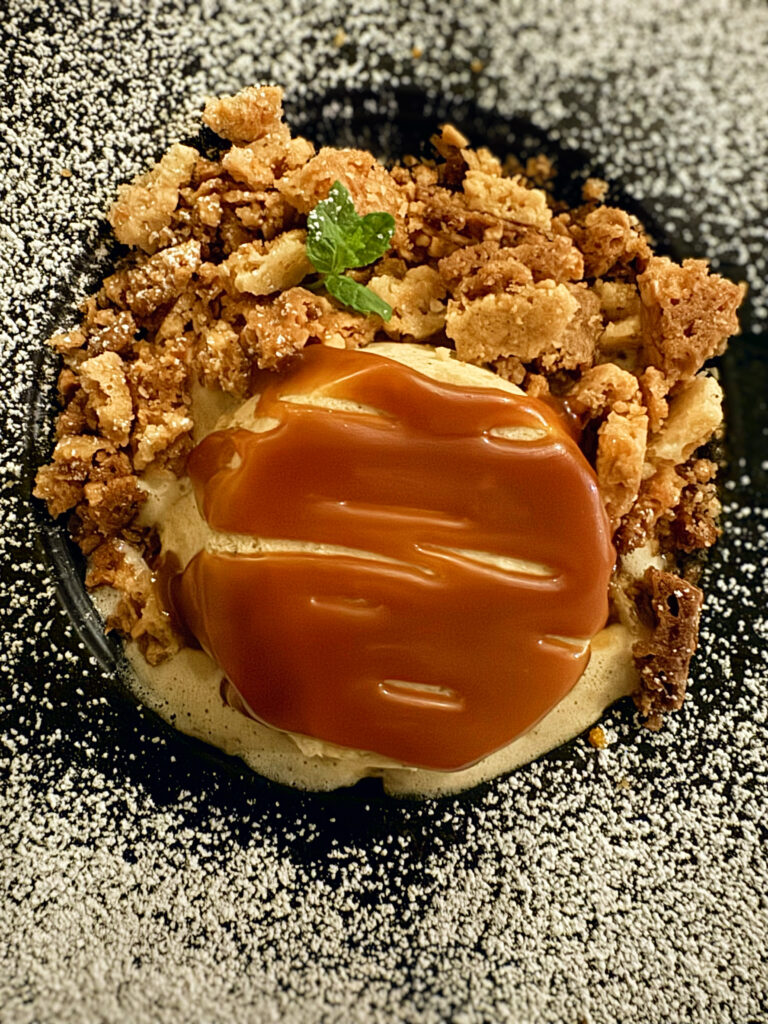
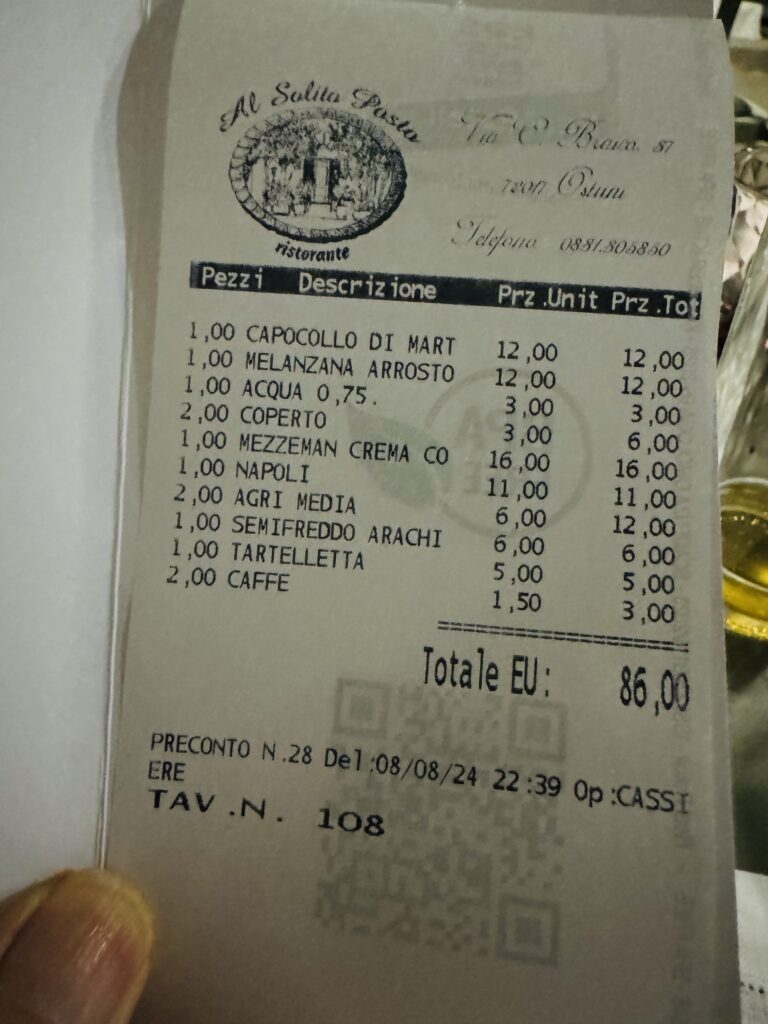
Via Cesare Braico, 37 | Al Solito Posto website
Casa San Giacomo | restaurant
Located in the heart of the centro storico, just off the main road to the duomo, about half-way up. Traditional home cooking in a typical Ostuni cellar setting with vaulted ceilings. For us it’s a dinner rather than lunch spot. Last visit: April 2025.
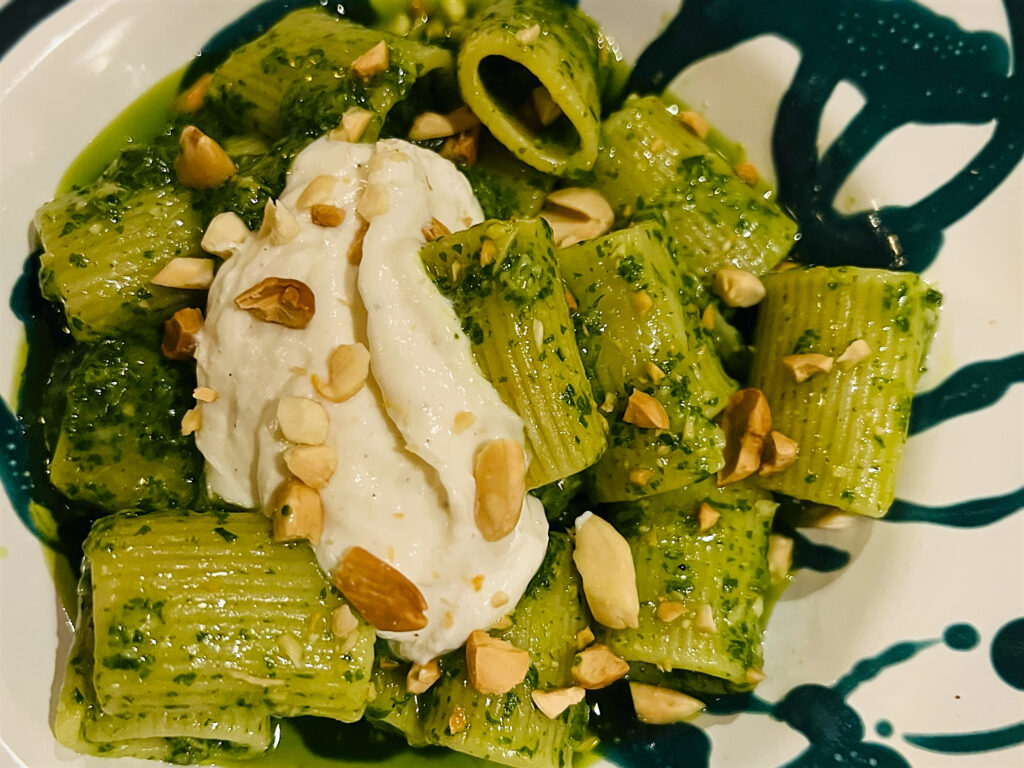
Be sure to book. We used to recommend booking was essential from June – September but on our last visit, 8 April 2025 with still a full week to go before Easter, the restaurant was packed. We reserved a table for 8.30pm and had to wait 20 minutes in the restaurant to be seated. (To put it in context, even though it was the start of the Easter holidays in Europe, many of the old town restaurants have still to open for the 2025 season so there were fewer eating out options).
Serving the recipes of Nonna Rosetta (Rosa) who used to cook in the kitchen with her sister. But sadly she passed a few years ago. The restaurant is now run by her grandson. Although the front of house and kitchen team looked completely different from previous visits, and there was a completely new menu from our last visits, we were assured the restaurant was still in the same ownership.
The good news is that the food was still excellent. There were three of us. We had polpette and brasciola (a starter, though the portion size felt like a main), orecchiette with cime di rapa (still translated as on most local menus as the rather off-putting “turnip tops”, though it’s a type of bitter broccoli rabe), and the maritati pasta with brasciola, plus a side of delicious fennel and onion gratin.
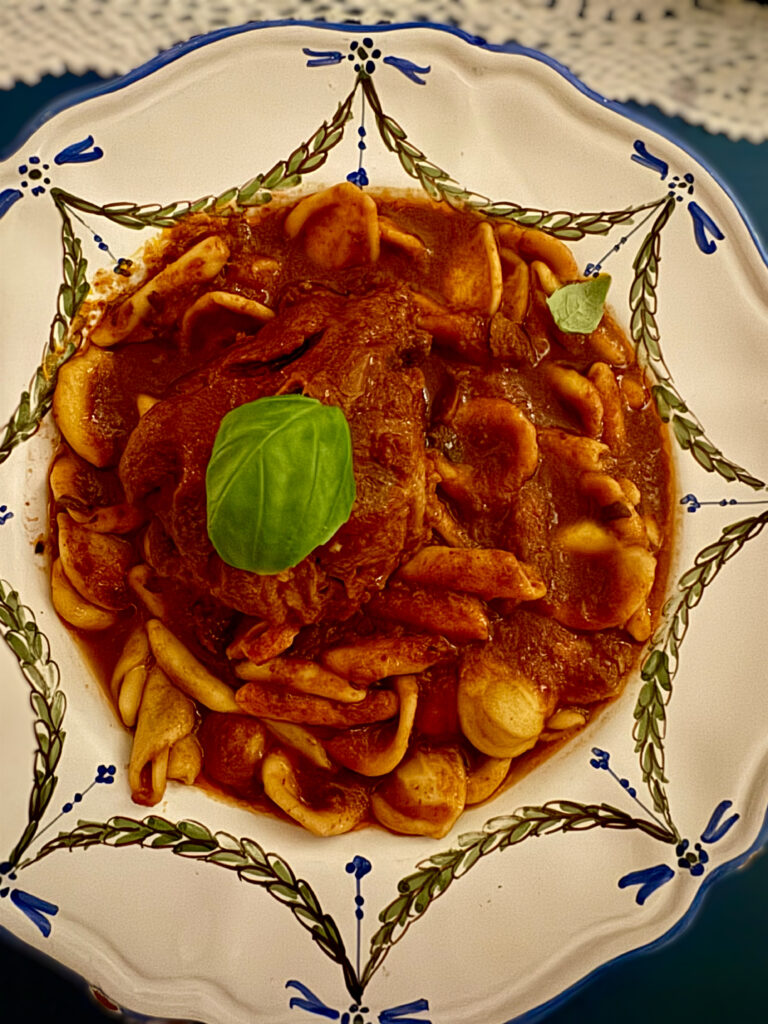
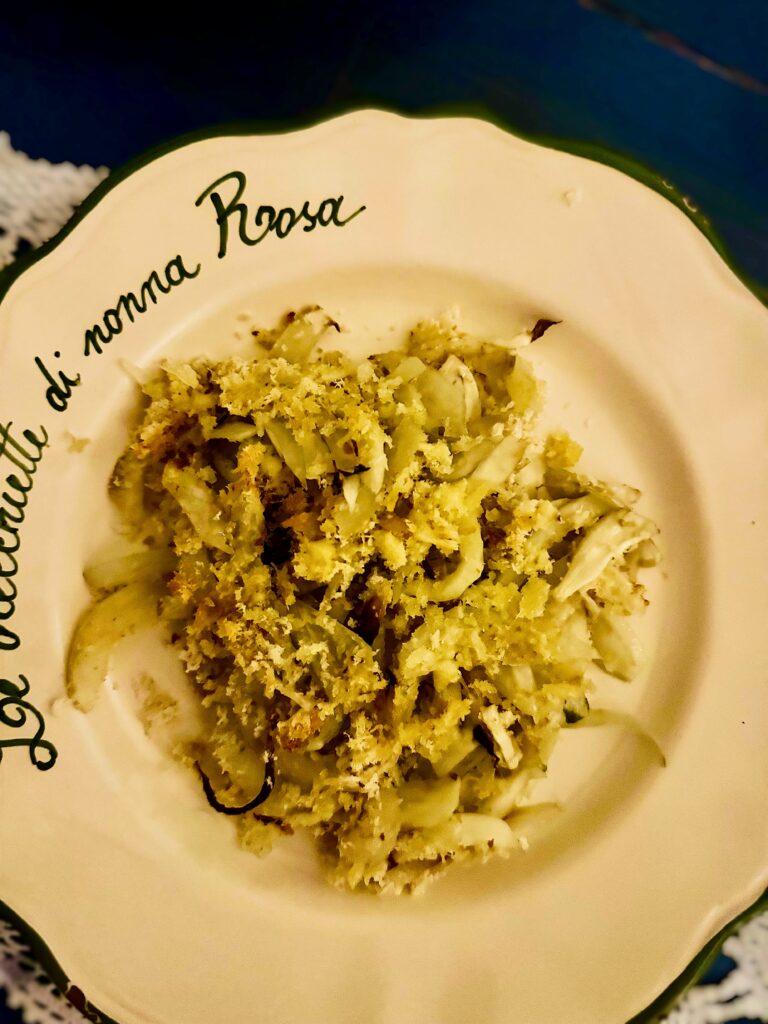
The restaurant was busy, though this did not impact on service time nor quality of food. We were sat in the back room, which was a noisy echo chamber, deafening at times with children from a nearby table playing in the corner. We came into contact with three servers, two of whom were supremely nice. The waiter who took our order may have been having a slightly off night and, perhaps understandably a little tired of the very noisy environment in the back room, was on the grumpier side. We asked if the negroamaro rose was a dry rosé. He replied, a little unhelpfully, telling us it was the only rosé they had. Yes, but was it a drier or sweeter wine? This time our waiter replied by telling us that it was a negroamaro, so it would be dry.
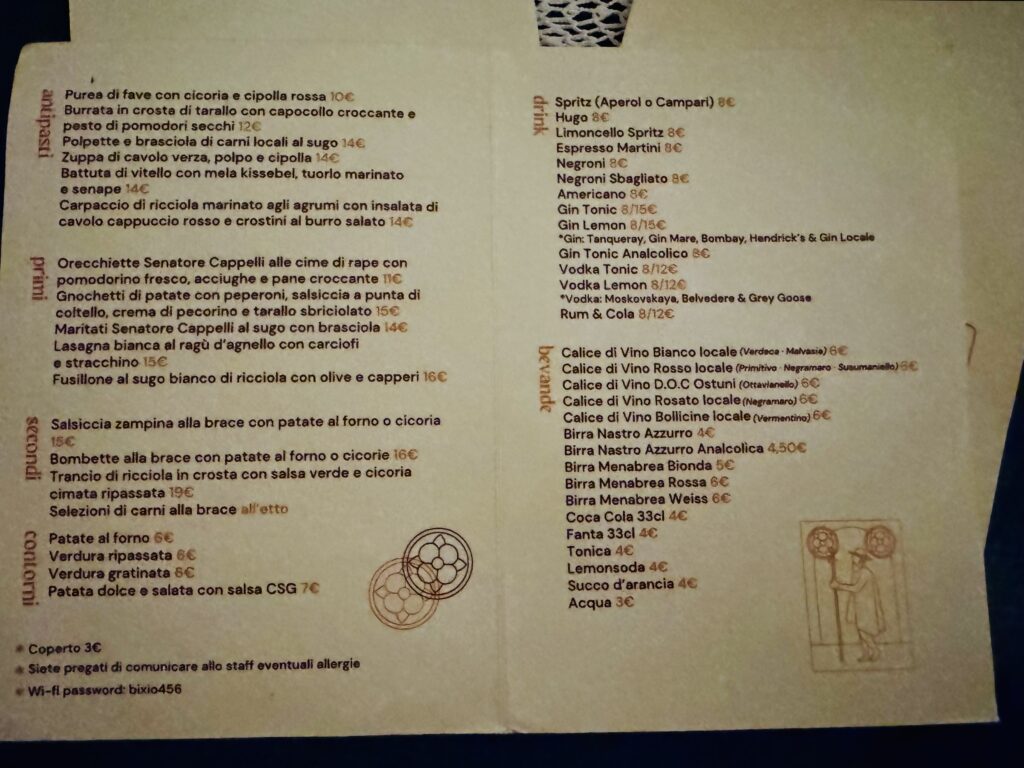
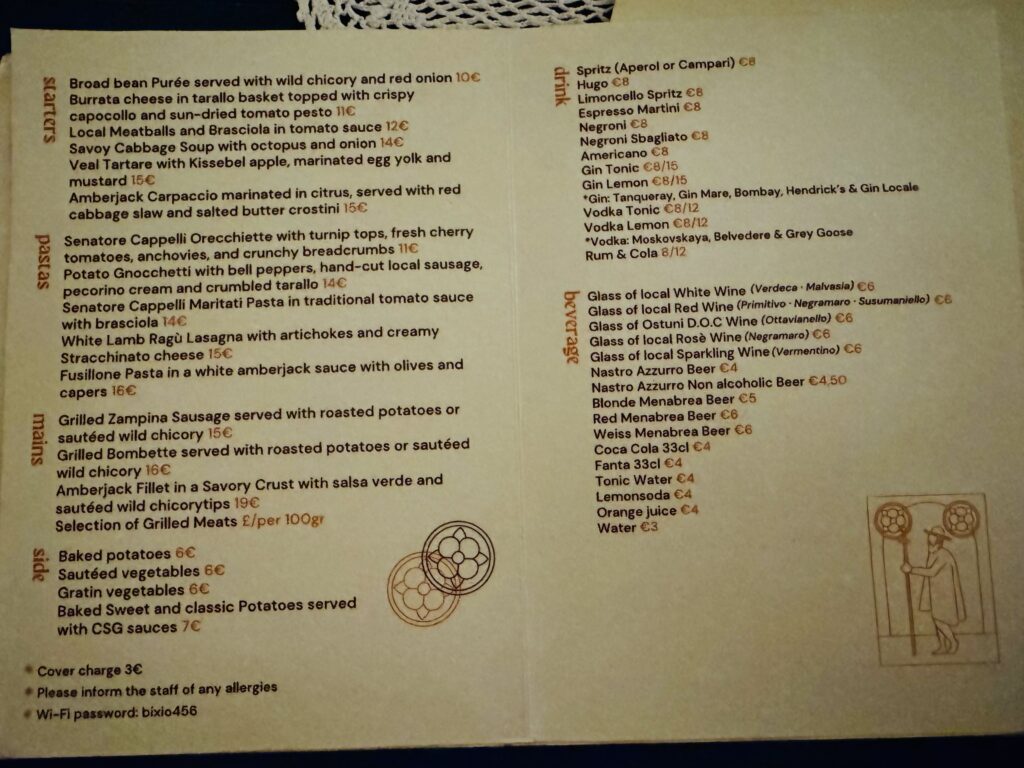
The maritati with brasciola was utterly delicious. Brasciole, known as involtini in other parts of Italy, are a traditional dish (from other culinary traditions think beef olive). The sugo was deeply rich, the brasciola was one of the most tender we have eaten. And it was served without the toothpicks that usually hold them together!
We had one starter, two pasta dishes and a side, two bottles of water and two glasses of wine. We shared a dessert. The coperto (cover charge) was 3€ each. Total bill 79€.
From previous visits:
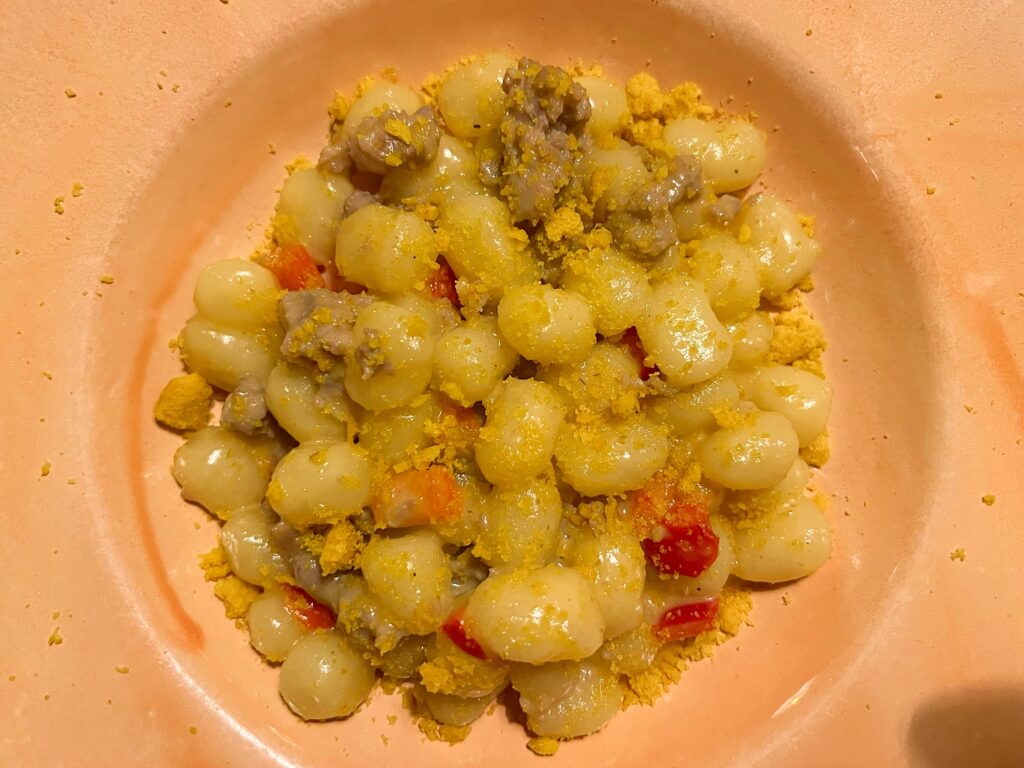
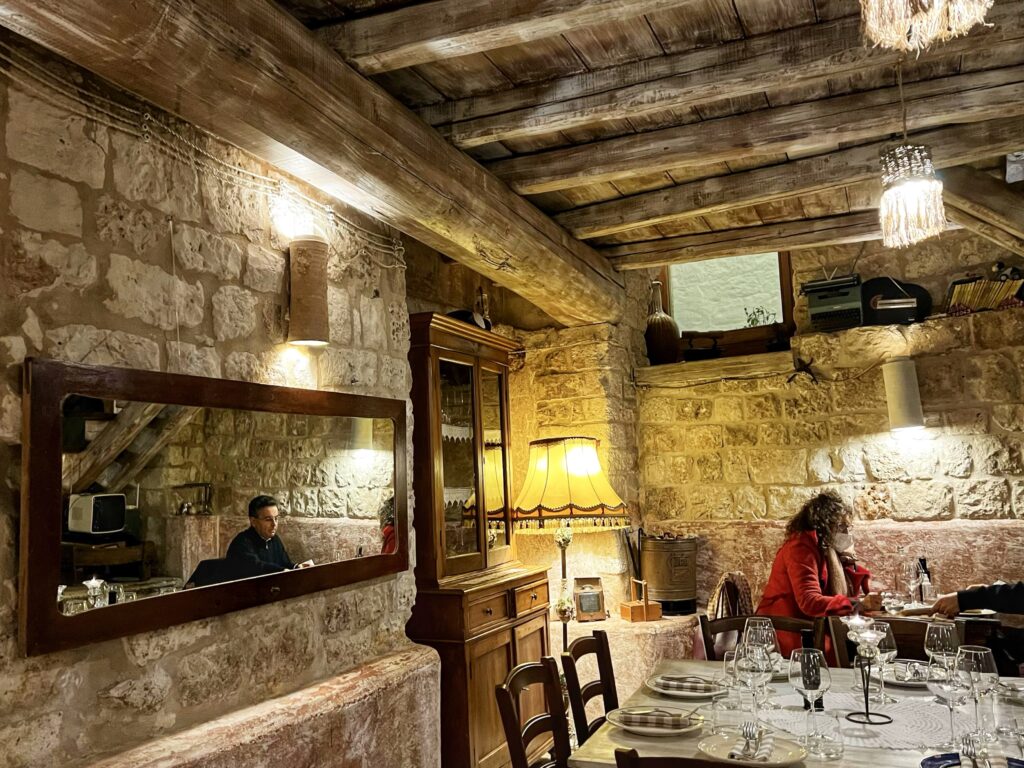
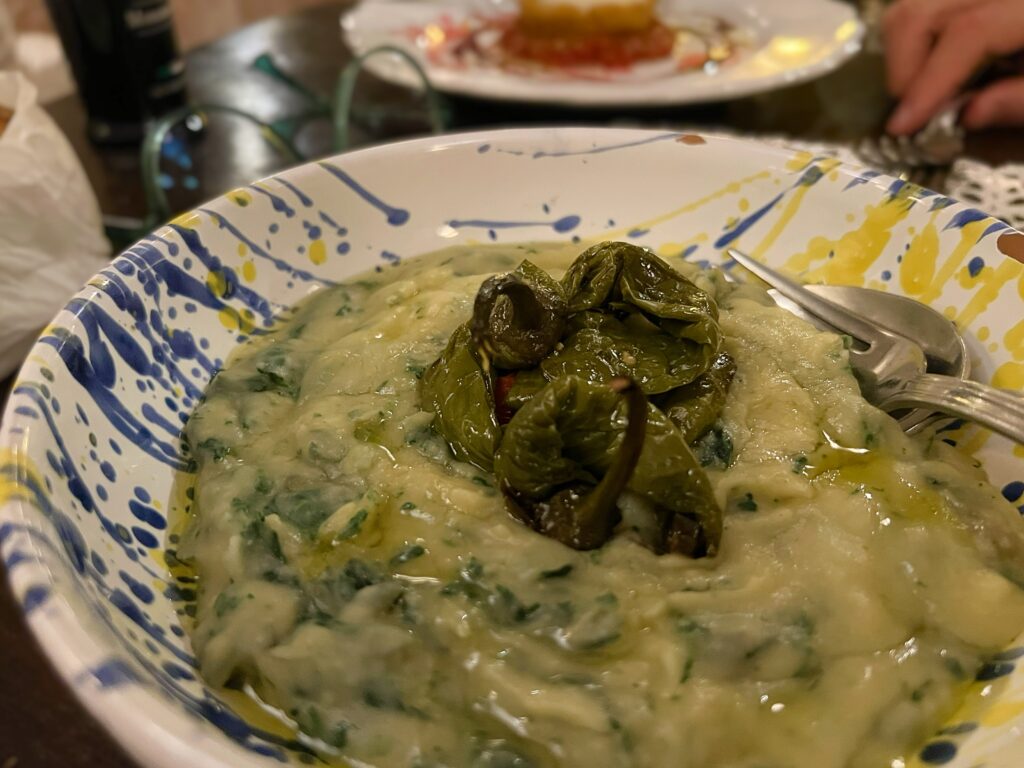
Dinner for three, including the coperto cover charge, three starters, mains and coffees, two bottles of water and two bottles of a moderately expensive wine cost us €153.
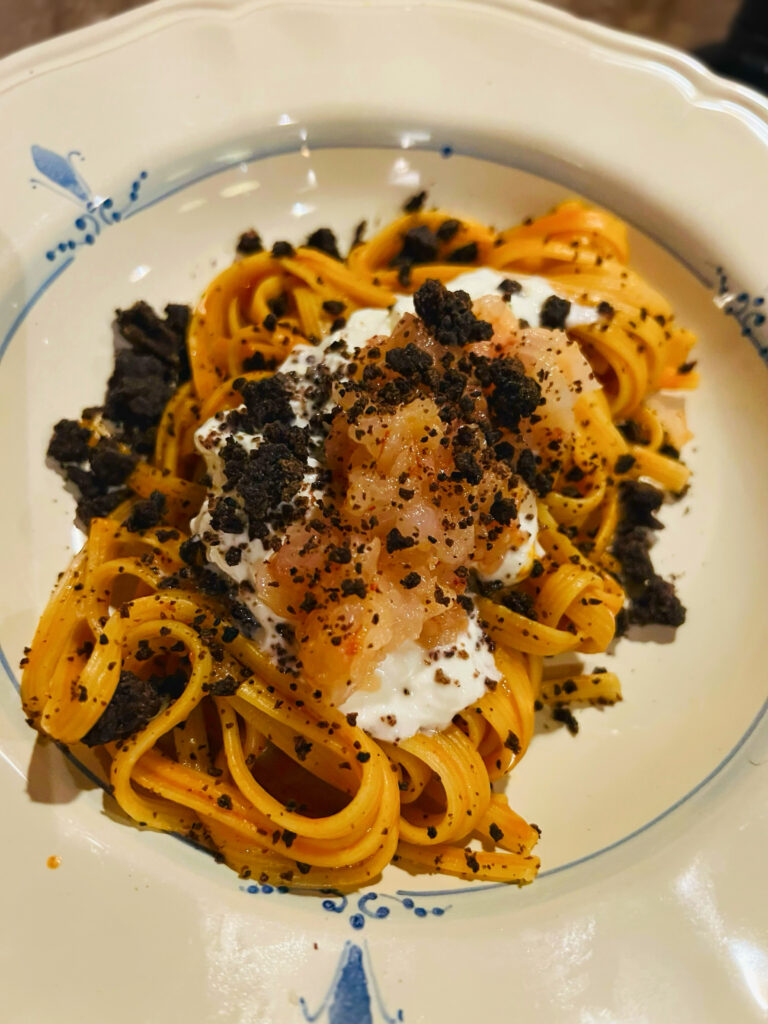
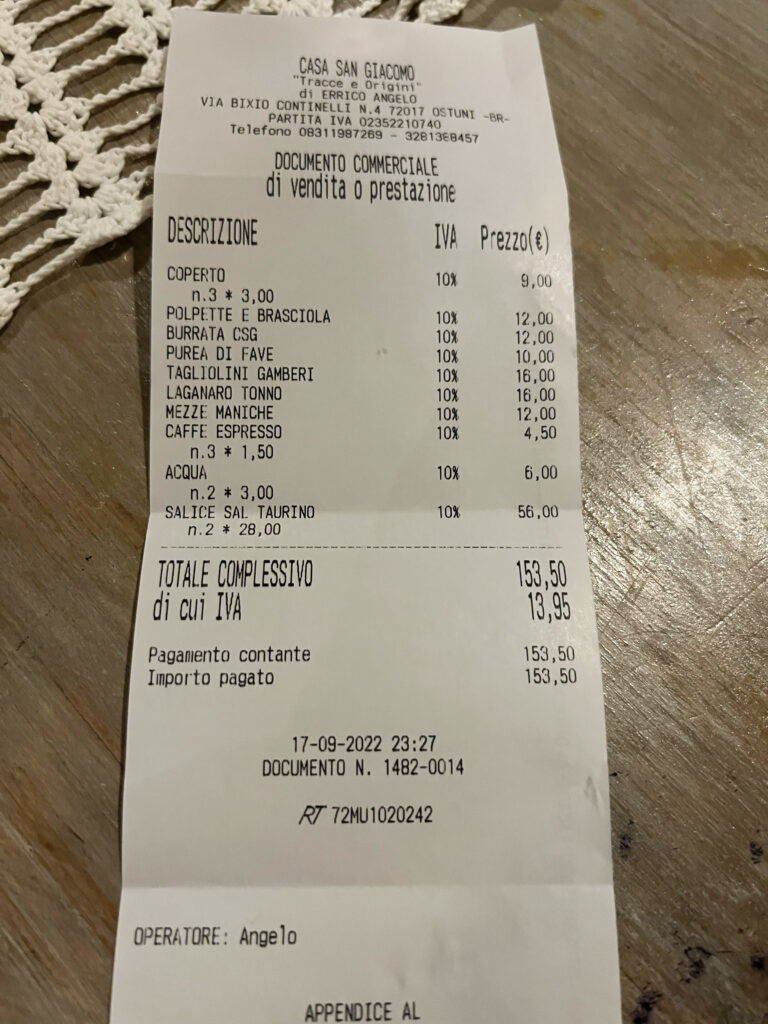
And yes, Madonna booked the whole restaurant to celebrate her 63rd birthday.
€€ – €€€
📍Via Nino Bixico, 4
+39 328 138 8457
Ristorante Trattoria Fave e Fogghje
Top quality authentic cuisine with very generous proportioned polpette (probably the best polpette we have had for sometime), this is a charming trattoria with attention to detail. The cosy interior is an unlikely mix of traditional southern Italy meets 1950s Americana (sometimes with music to match, and better with the Italian music selection). Come for the friendly service and quality of food. It’s excellent. Frequented by locals and Italian visitors who know their food. We always take visiting friends here.
Located off a small lane of the road down to Saint Oronzo’s column, you’ll certainly regret passing it by! Just marvellous!!
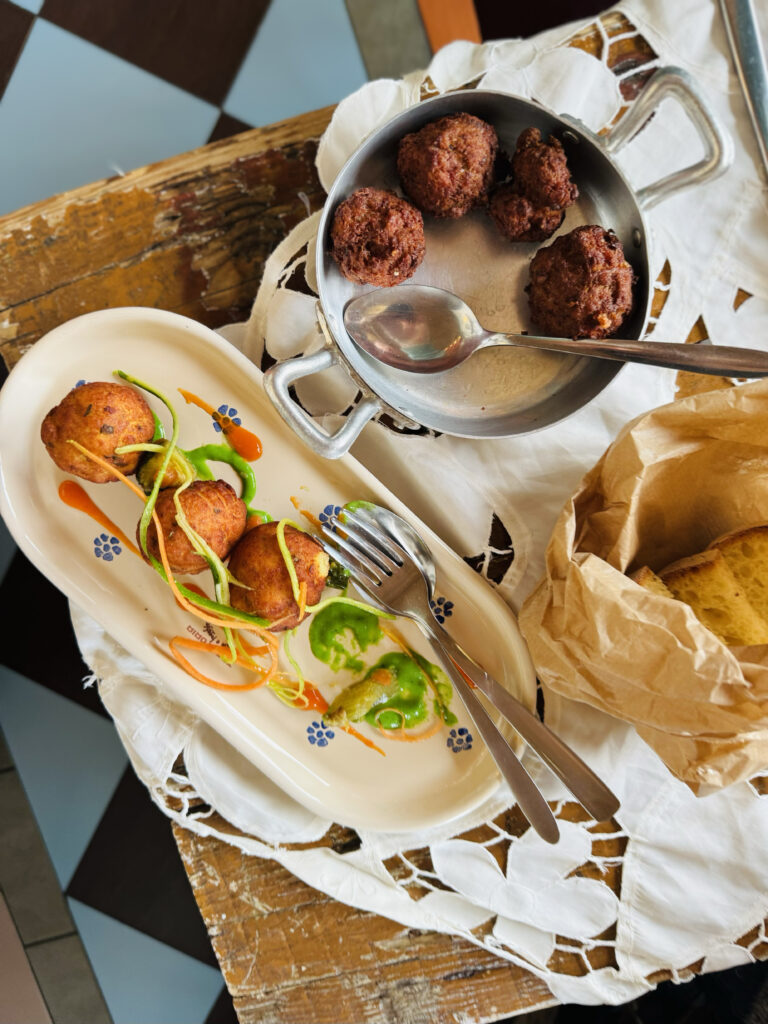
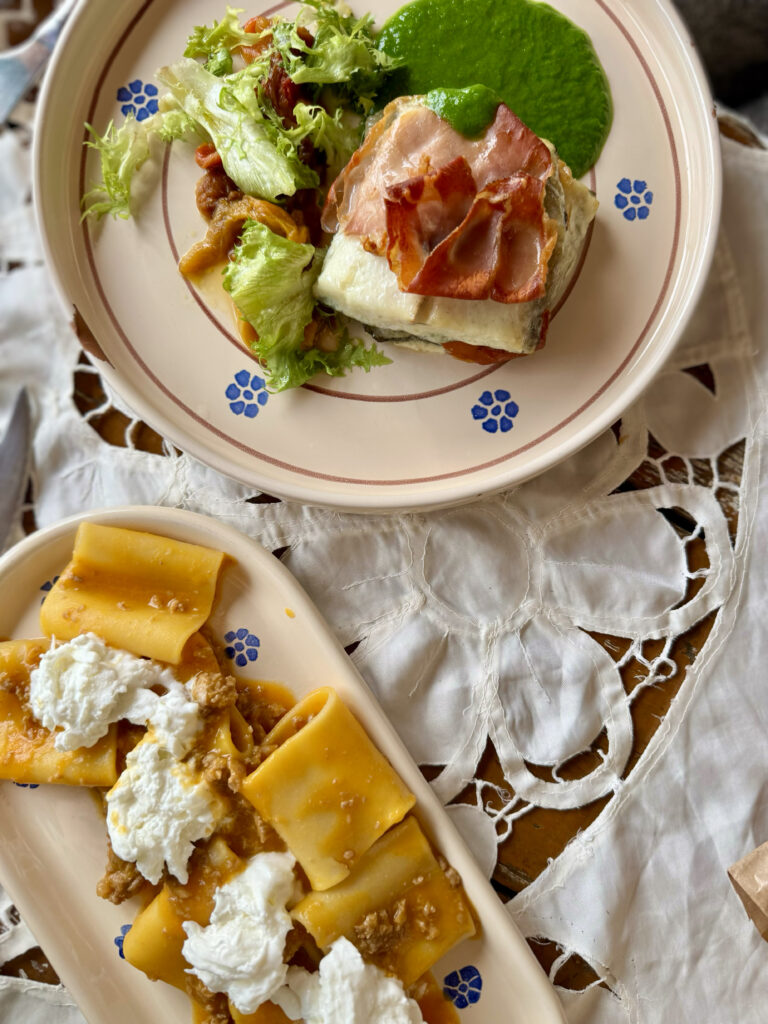
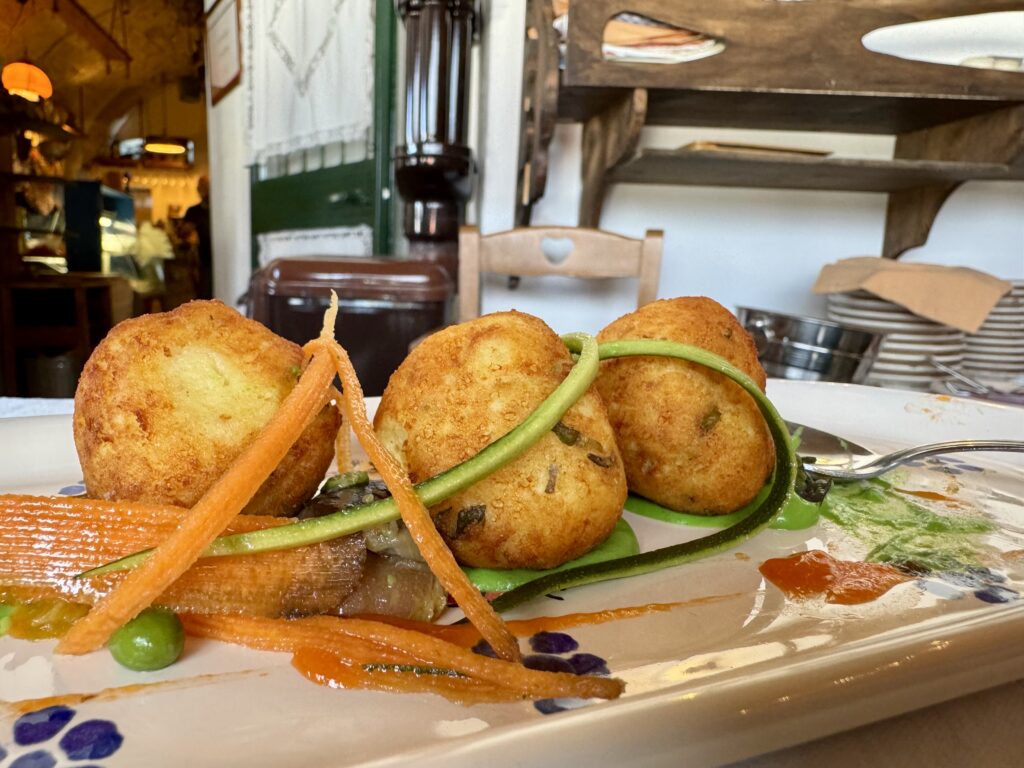
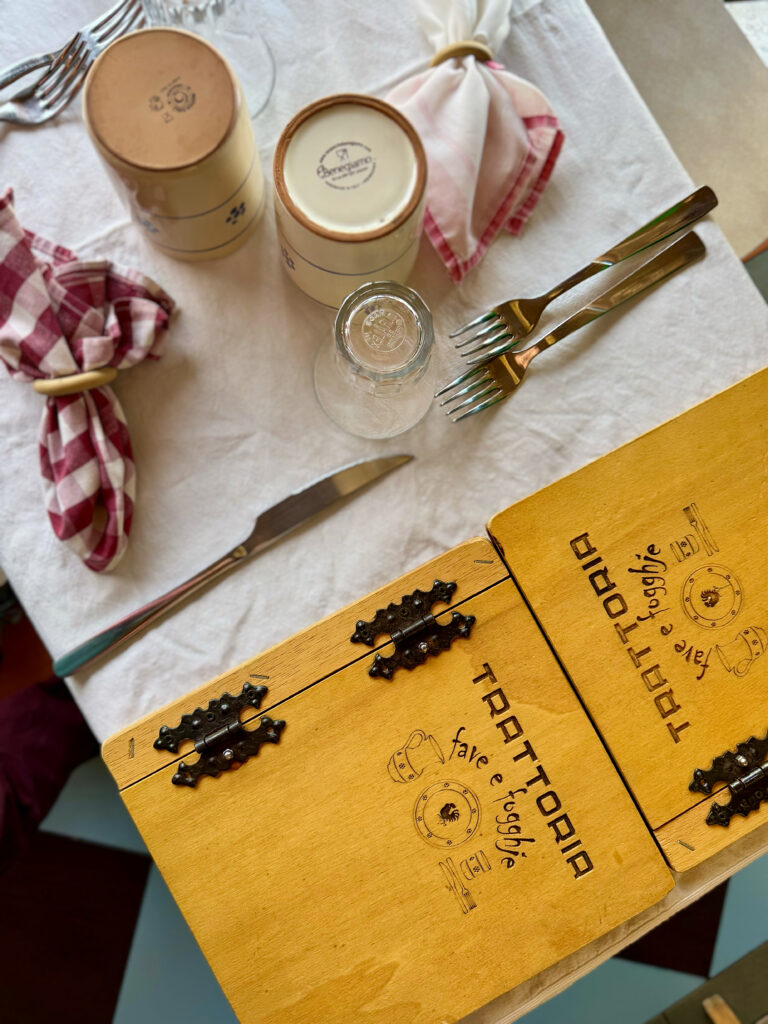
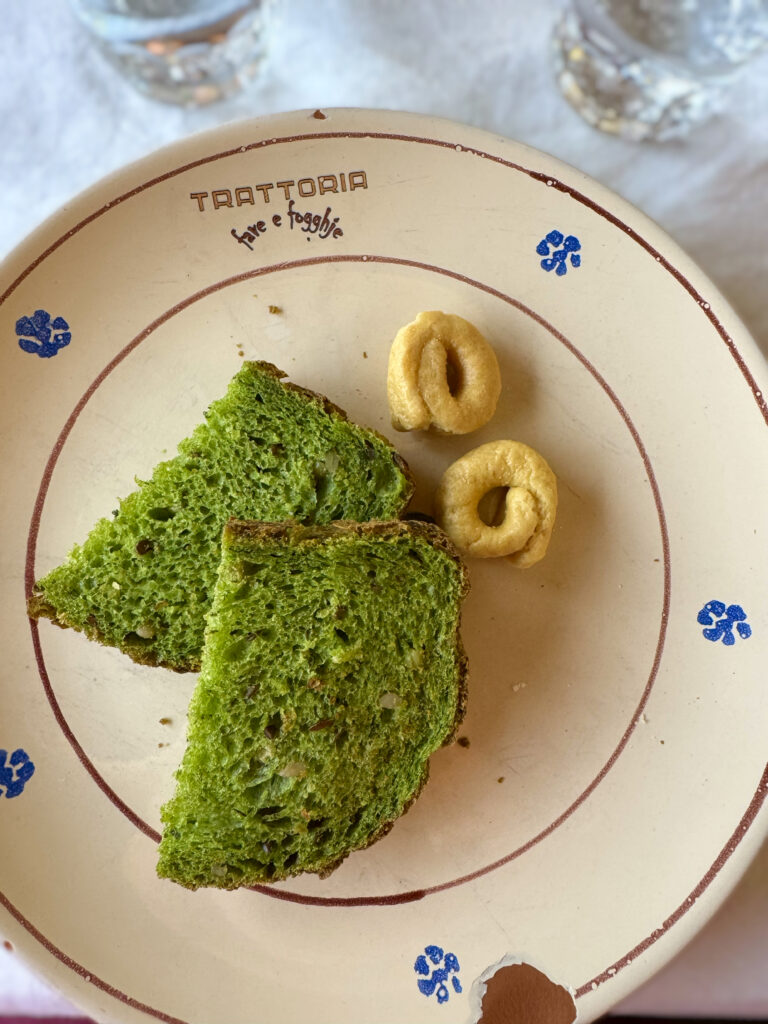
The trattoria has a wonderfully rustic setting, exactly as you would imagine. The ever present Puglia green, cime di rape, finds its way into their bread – and the homemade taralli a comforting touch (included in the 2,50€ per person coperto charge).
The pasta is delicious, of course. The spaghetti with mussels came without shells, a bonus for those of us who don’t like to eat with our fingers, and a decorative flourish of foam (ask for it without the foam – senza schiuma – if you find foam on your plate unappetising).
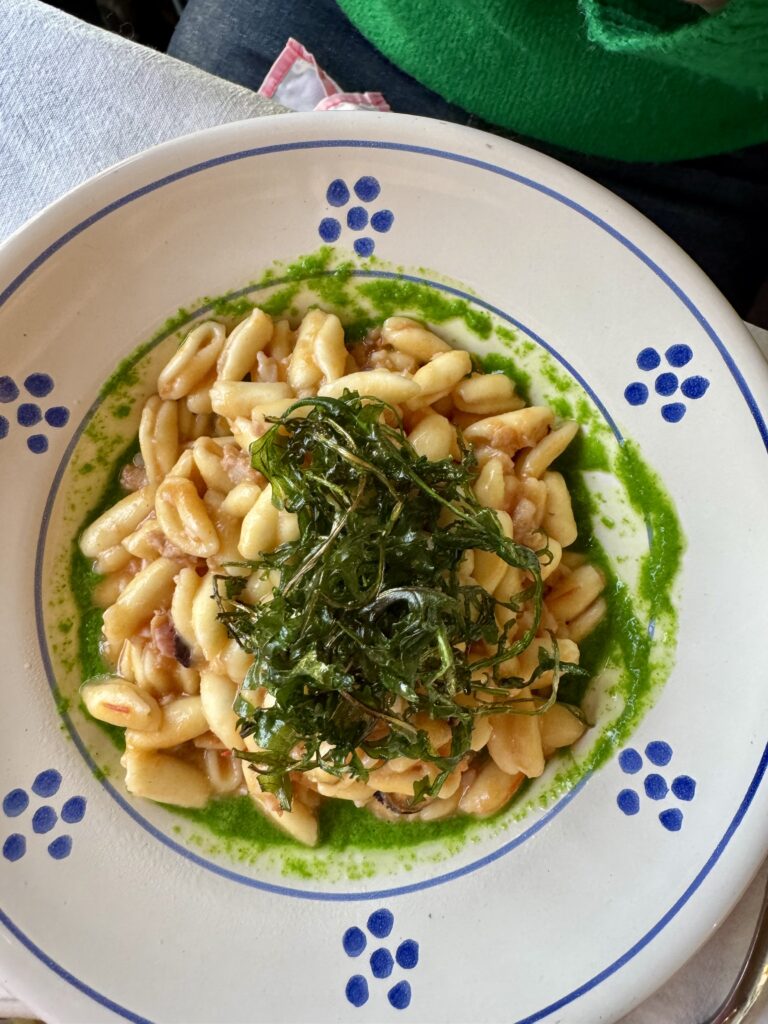
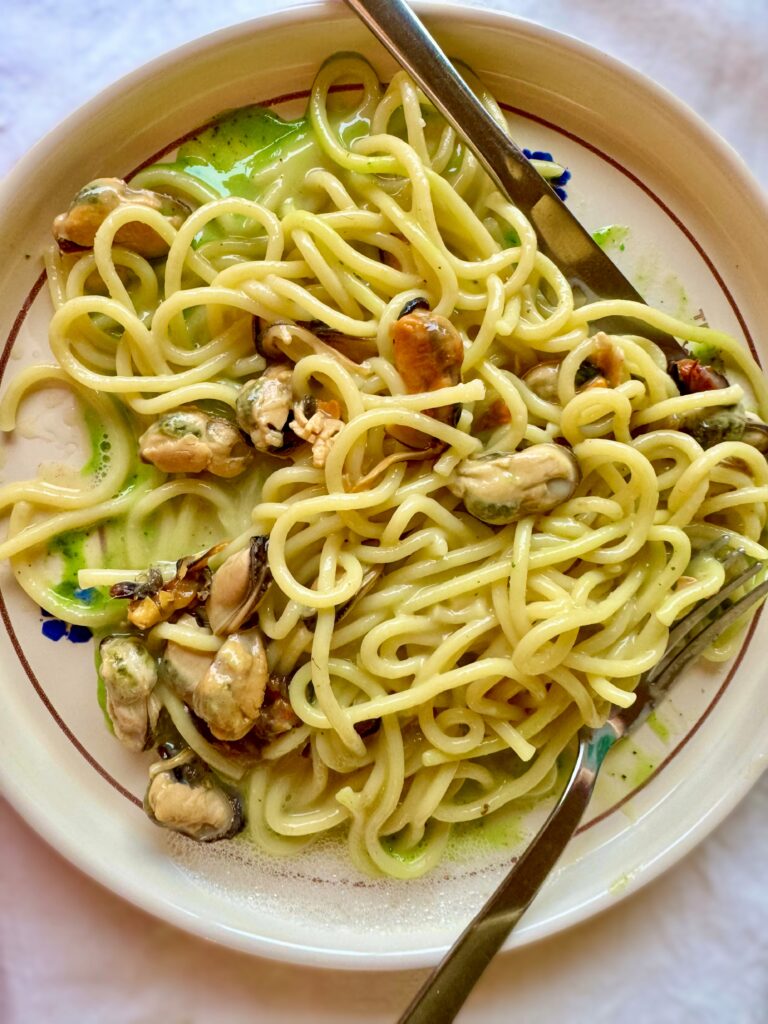
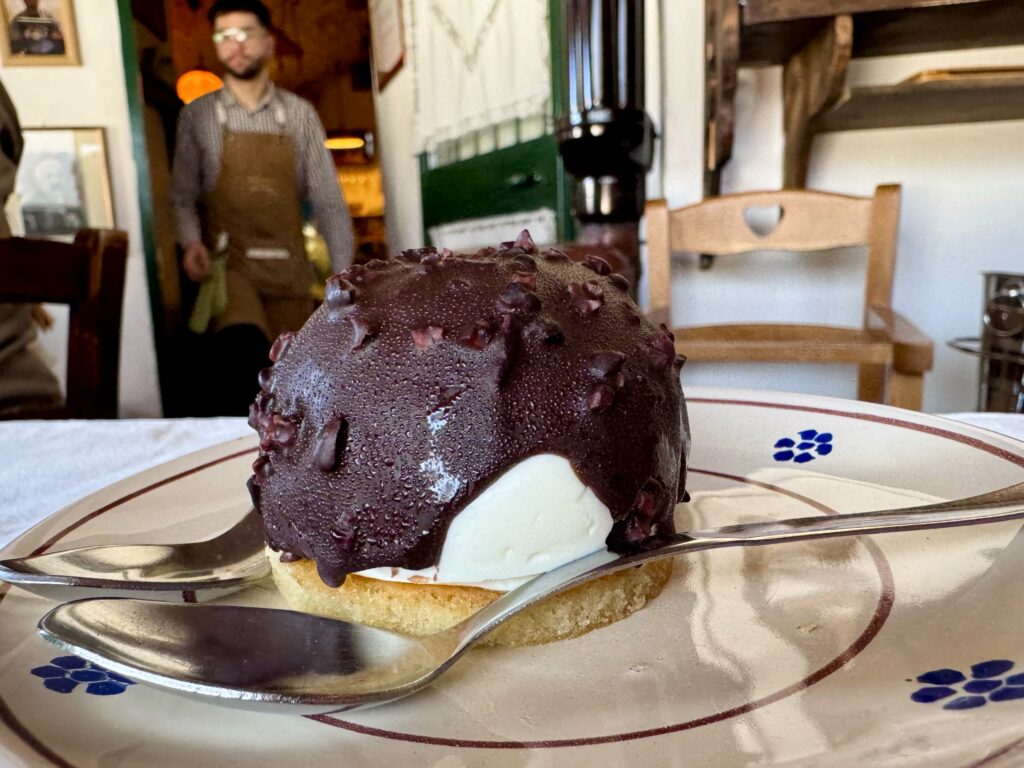
📍Corso Cavour, Vico Antonio Fratti, 25b
+39 366 706 6700
Gabó | restaurant, lounge bar
Although it isn’t for locals (the price is relatively on the higher side, especially the coperto (cover) at 5€ per person and drinks – 5€ for 0.75l water, 7€ for 0.40cl beer, 5€ for Coke Zero, 9€ for a glass of wine), the food is very good (some generous portion sizes), the service friendly and the setting one of the nicest. Choose a seat in the cool, garden shade. On one of the panoramic terraces or inside.
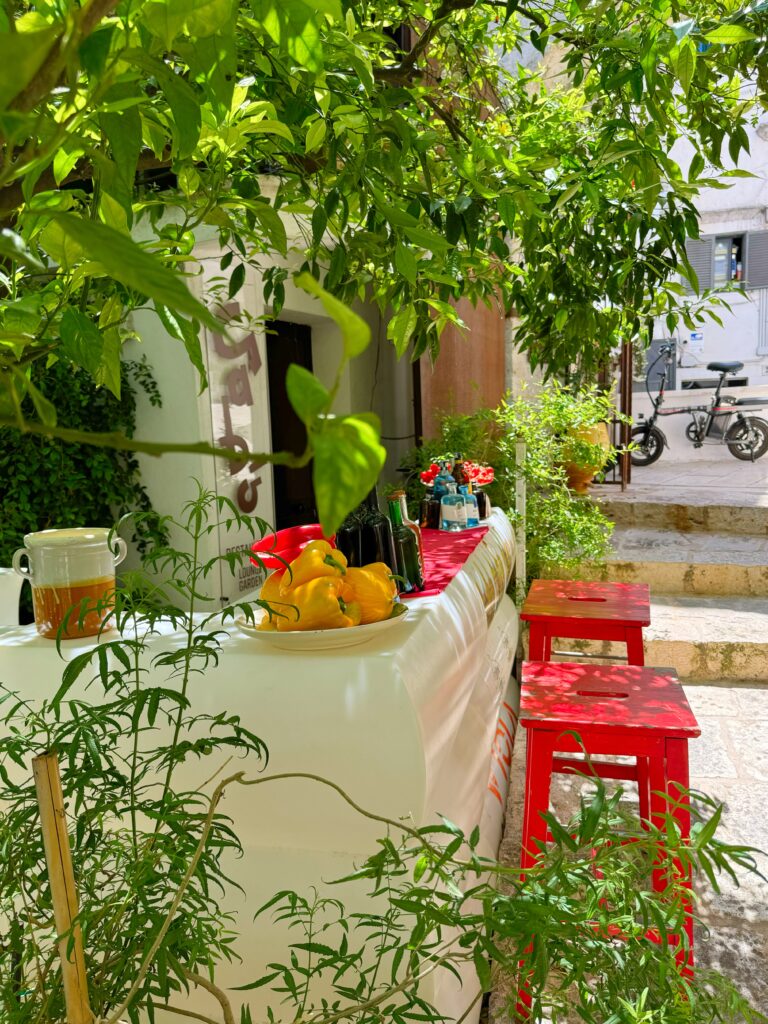
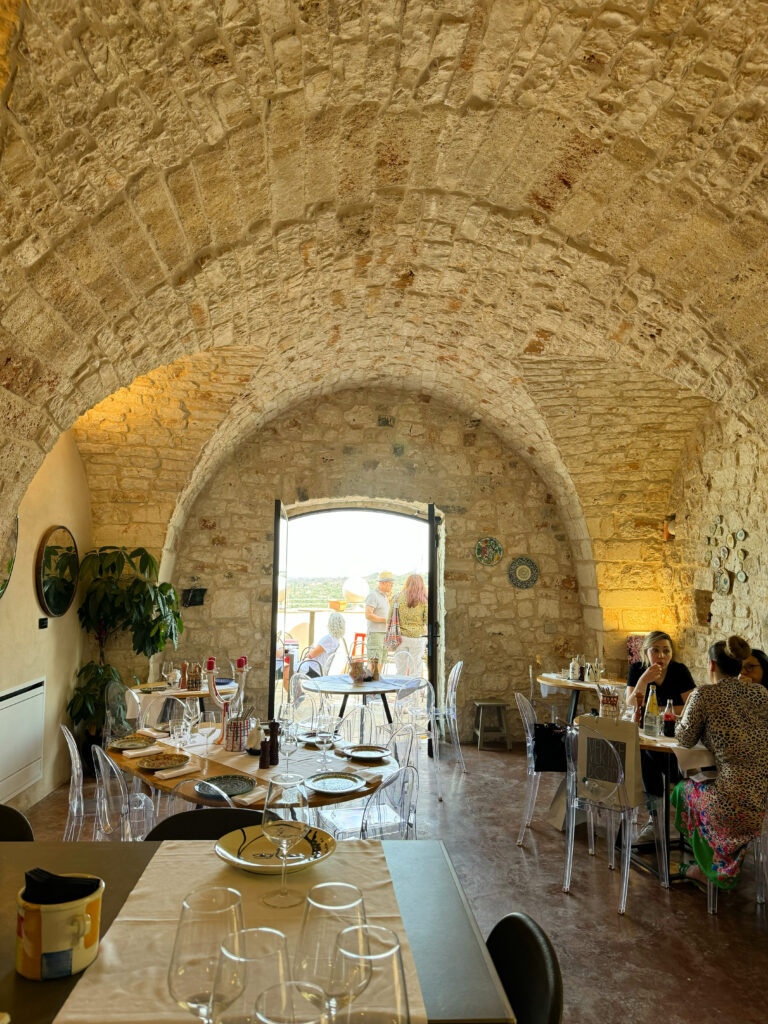
Tastefully decorated and accented with Nicola Fasano ceramics from Grottaglie (the “Coffee & More” English language branding on plates seems at odds with the location, but this is the trading name of the restaurant and the plates were commissioned).
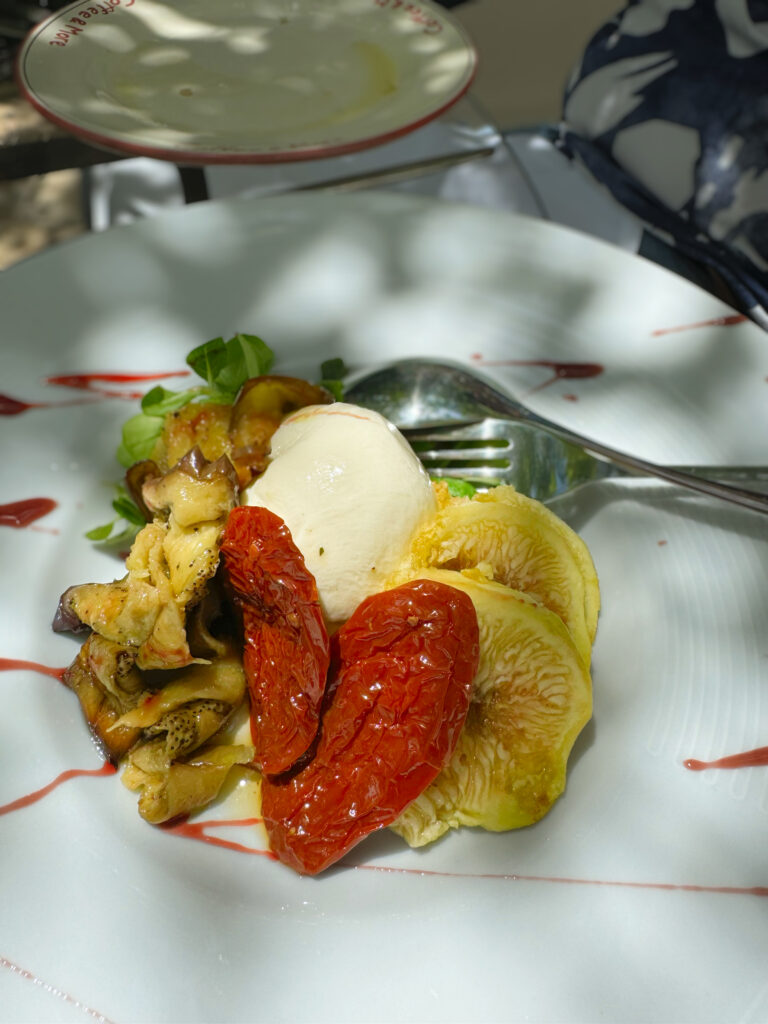
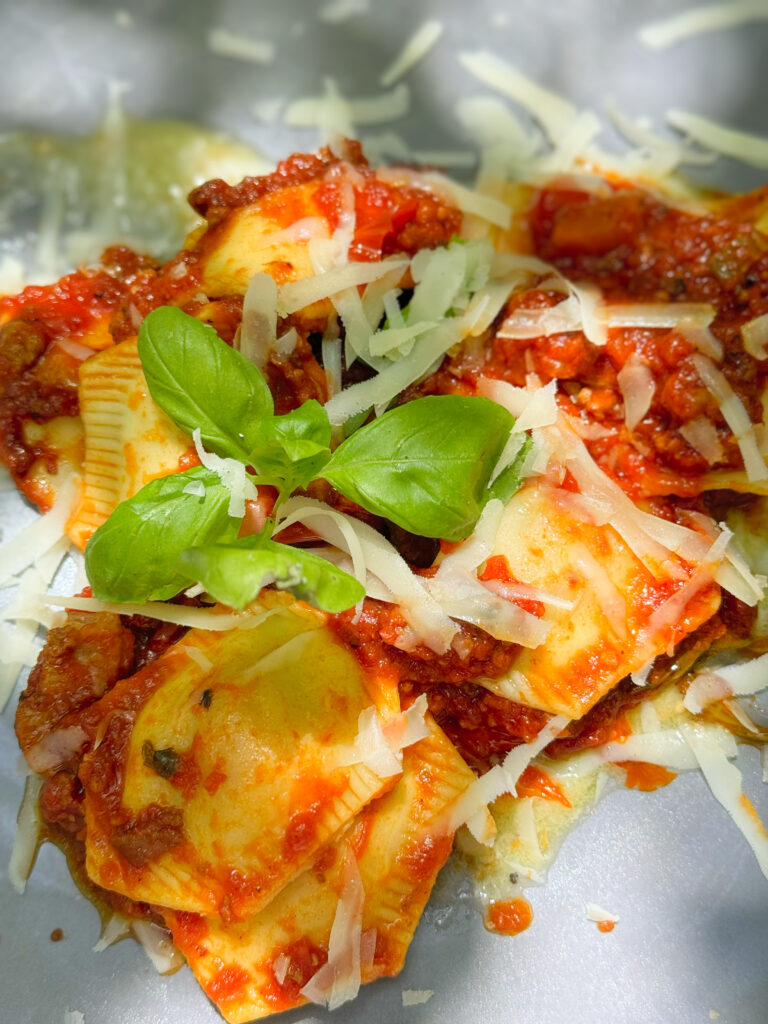
They have an excellent policy of not allowing smoking at the tables on the terrace outside, so your meal isn’t spoiled by smoke coming from a neighbouring table. There is a smoking area by the main entrance.
The food is a little more expensive that we usually pay, but the food is excellent and the portions are generous, so we consider Gabó good value when it comes to the food. The coperto is one of the most expensive in Ostuni at 5€ per person, but the olive bread we were served was freshly baked, warm and delicious. The service was unhurried and relaxed.
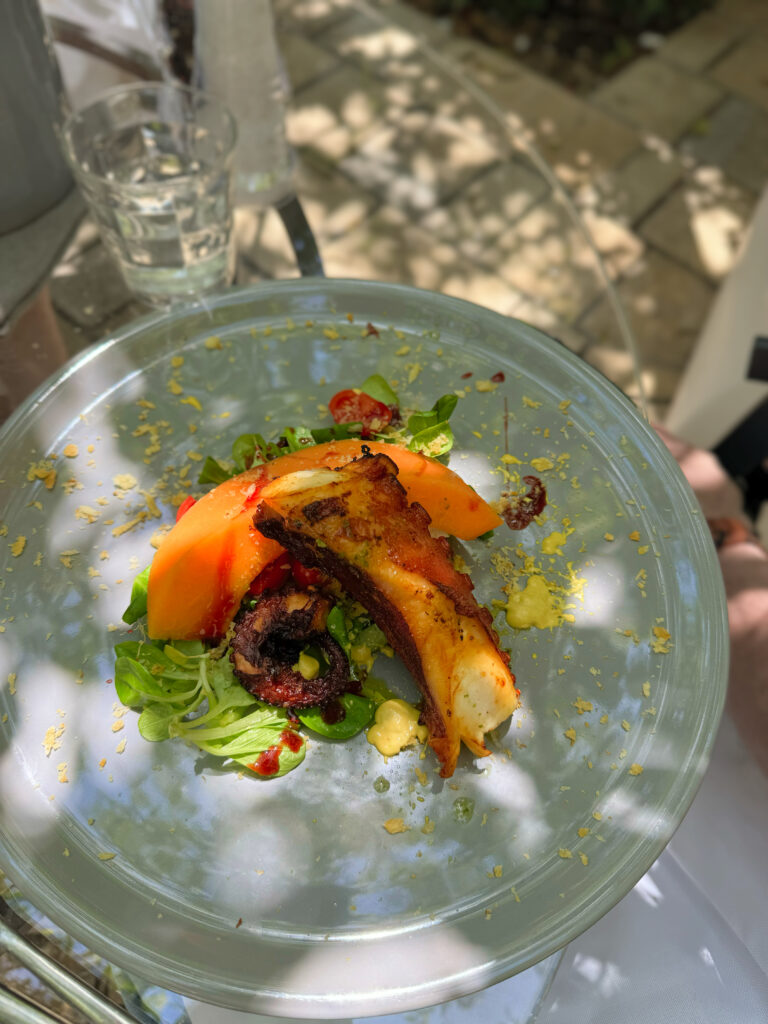
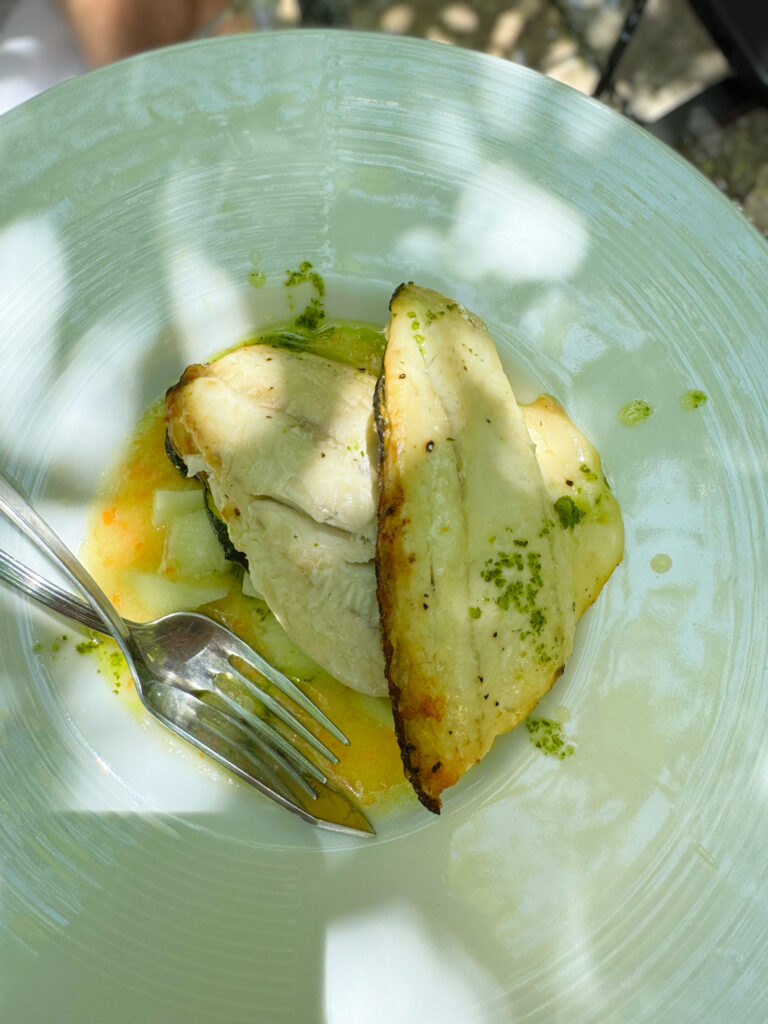
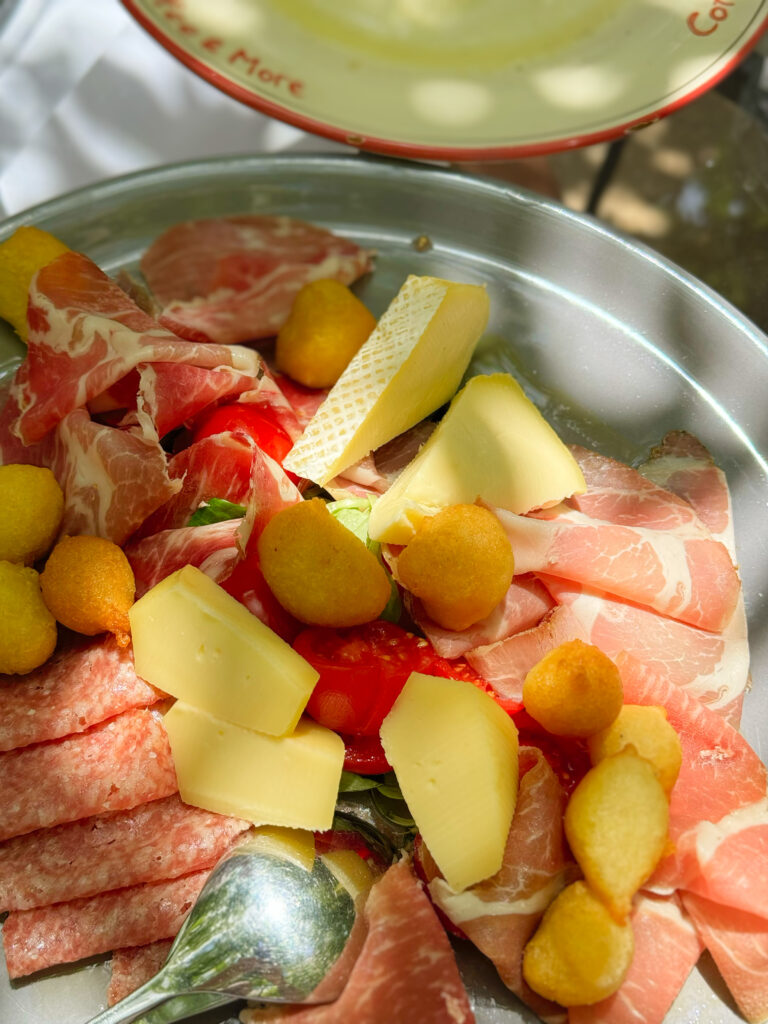
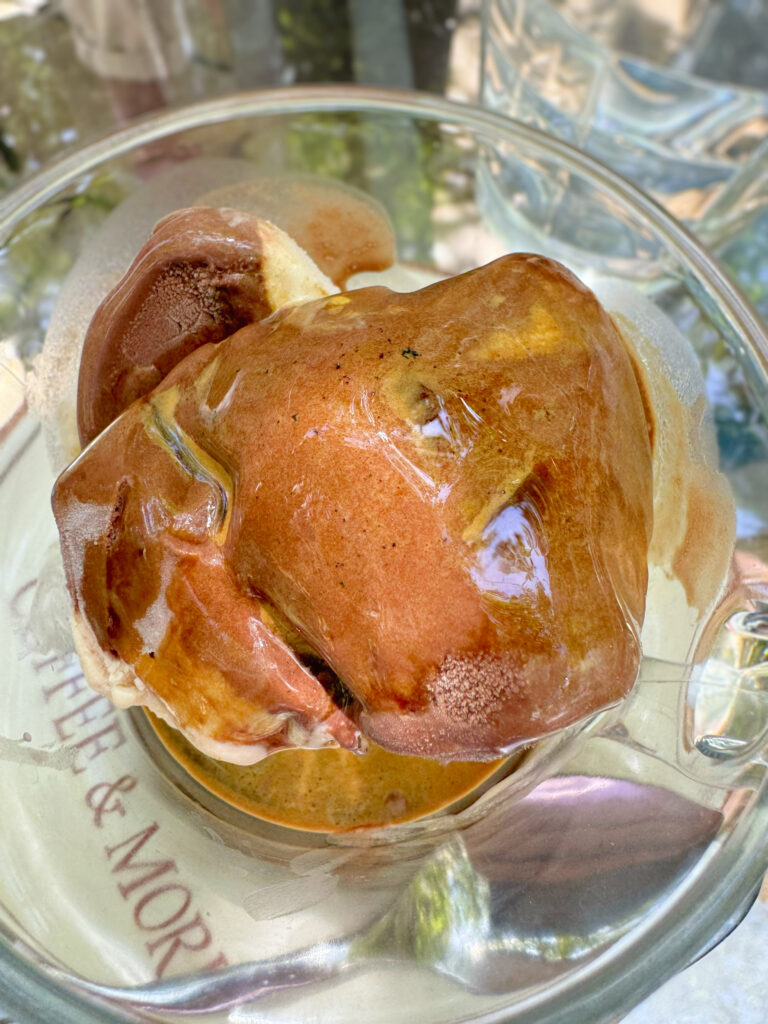
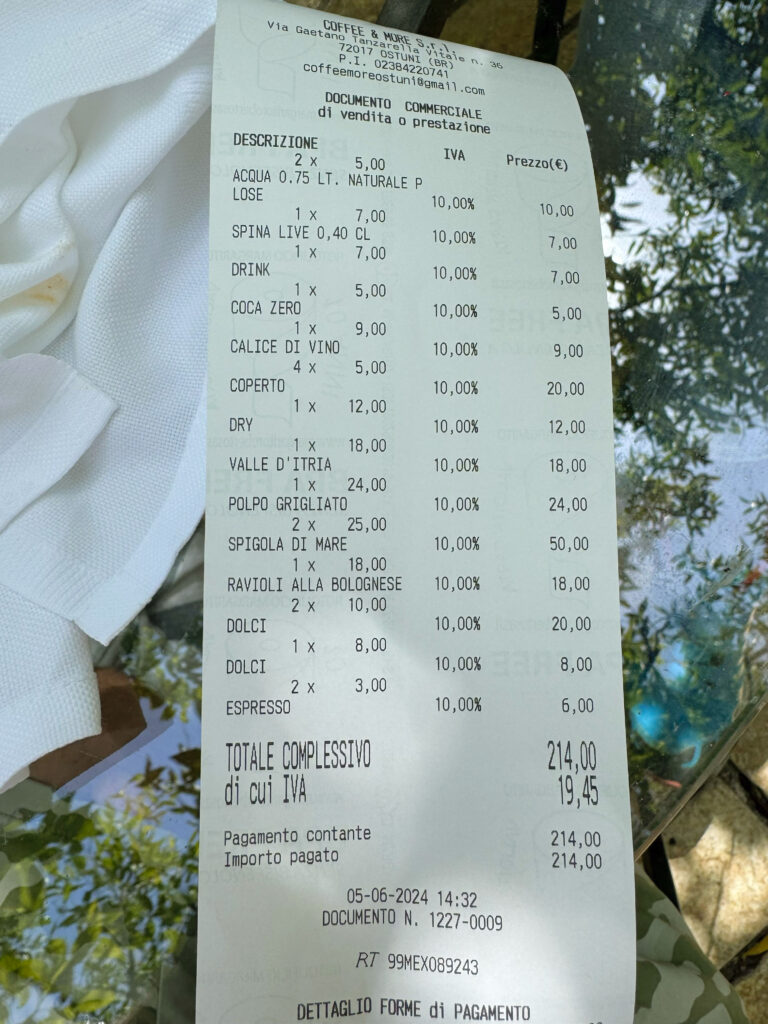
Booking for lunch, dinner or even cocktails recommended.
€€ – €€€€
📍Via Gaetano Tanzarella Vitale, 36
+39 328 271 1189
Osteria Monacelle | restaurant
Good local food in the heart of Ostuni’s old town.
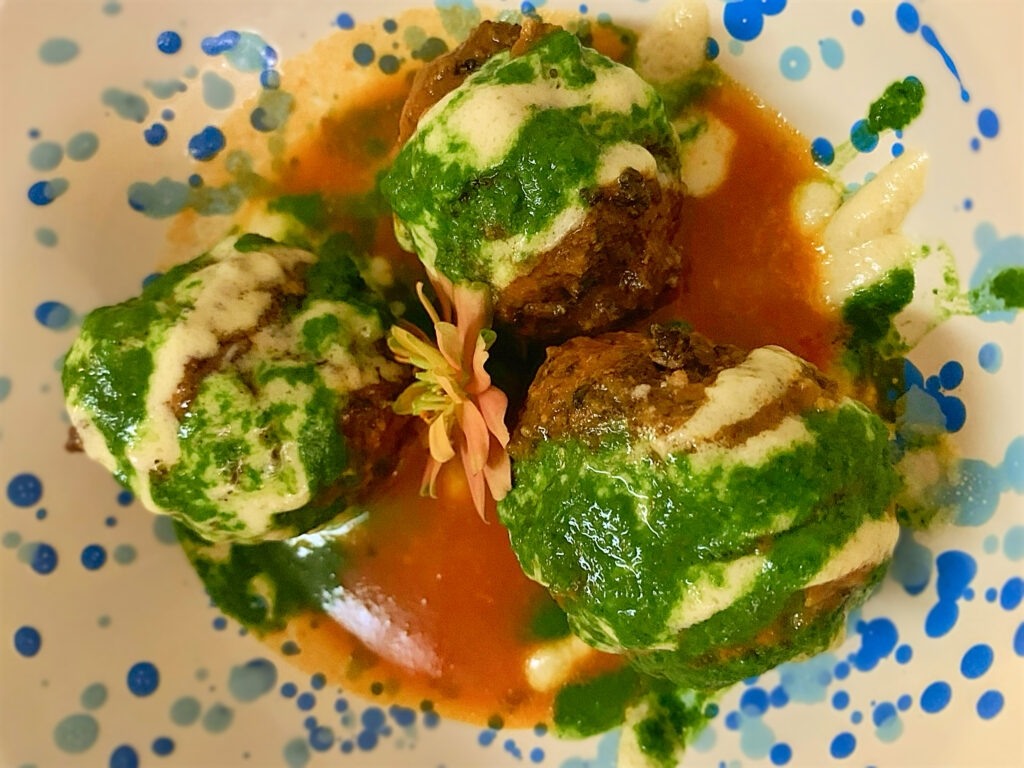
Osteria Monacelle is one of our dependable dinner choices when we eat out in Ostuni. They serve typical regional dishes consistently well.
If fave with cicoria and octopus are on the menu the chances are that they will be appearing on our table.
Monacelle has three eating areas. The narrow alleyway outside the restaurant, the main dining space which is the second door up, at street level where the outside menu is located, and the upstairs area which the first door that you come to walking up the hill.
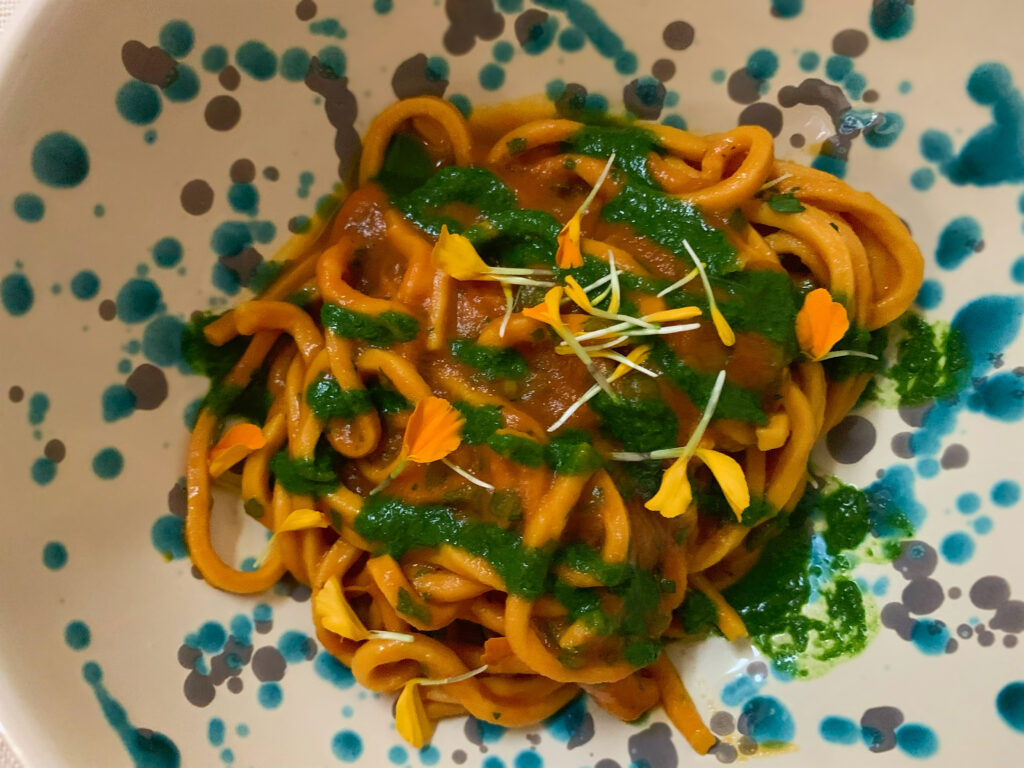
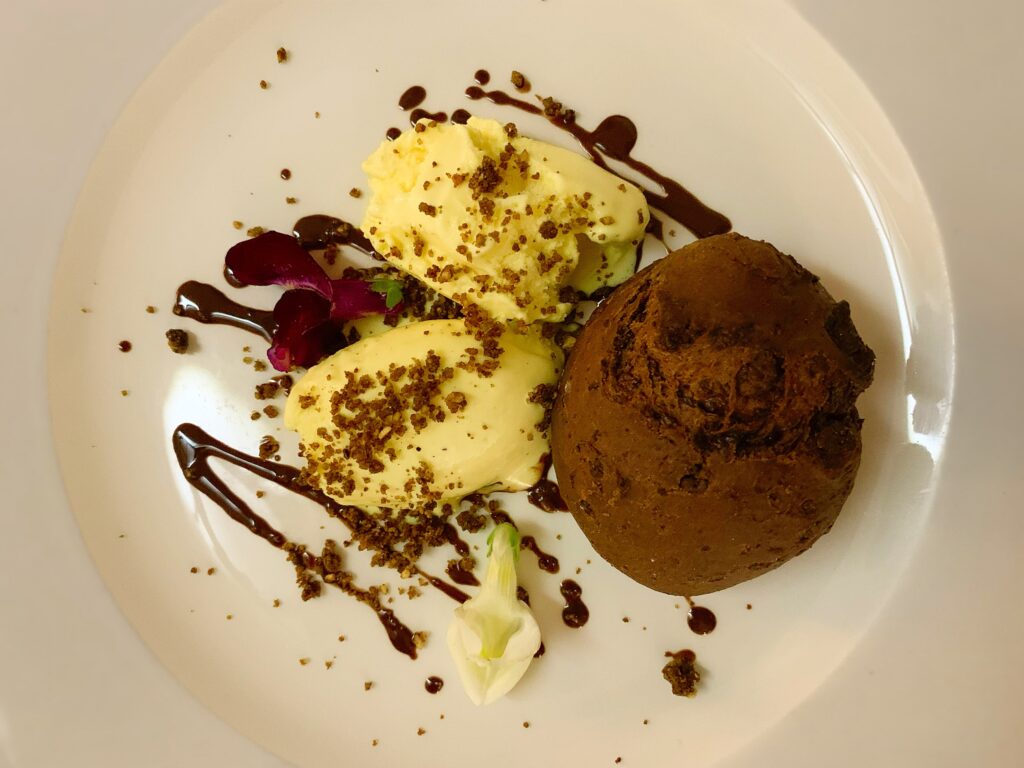
The main dining space is adjacent to the main kitchen, too hot in summer. The upstairs area is (slightly) cooler, with fewer tables. You won’t find yourself near the bathroom which sometimes happens with a table for two downstairs. We find the alleyway seating area too narrow for privacy, with many passers by on a summers evening.
From June – September booking is recommended to avoid a long wait, or being turned away.
€€ – €€€
📍Via P. Vincenti
+39 083 133 4212
La Pastasciutta | pasta restaurant
Honest, decent and inexpensive pasta. No frills dining, but it really hits the spot. Select from a variety of pasta types and sauces. Order and pay inside, the pasta will be cooked to order (as it should be) and brought to your table.
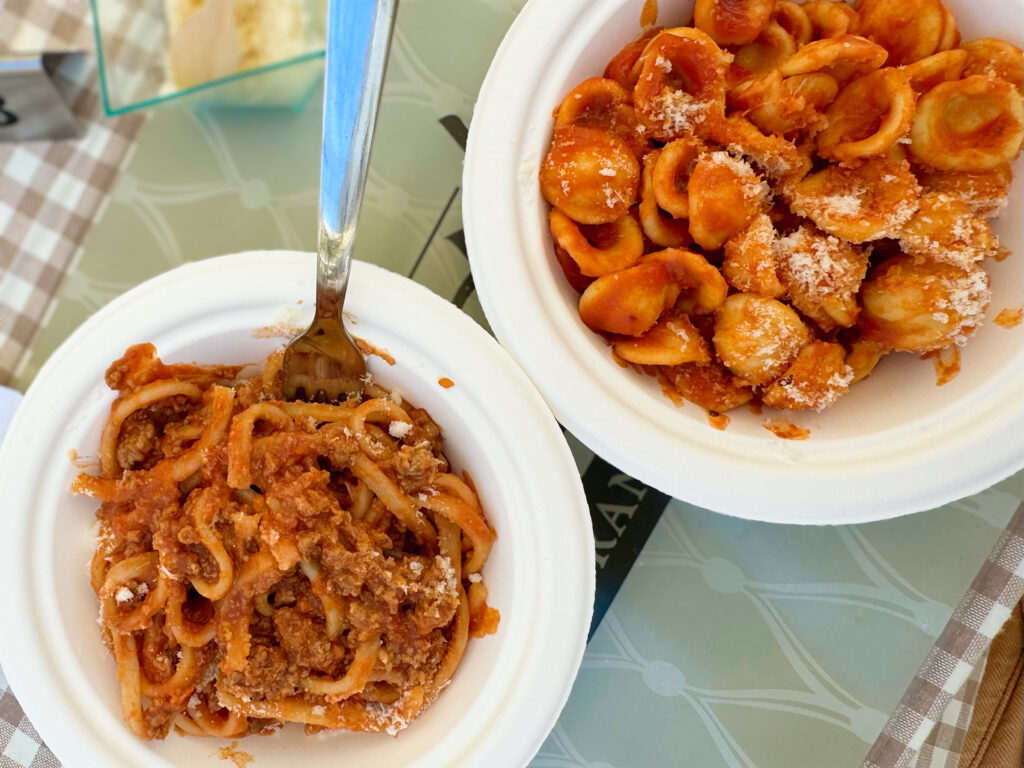
We love this concept (having eaten it in a variety of destinations). We waited for just over 25 minutes while 6 people ahead of us were served – the kitchen cooking area was limited to cooking 3 different pasta dishes at any one time. However it was well worth the wait! Absolutely delicious.
Portion sizes vary from approximately 80g – 130g of pasta. The bolognese with a more substantial sugò used approximately 80g while the orecchiette arrabbiata had more pasta. Our orecchiette was perfectly al dente to our taste.
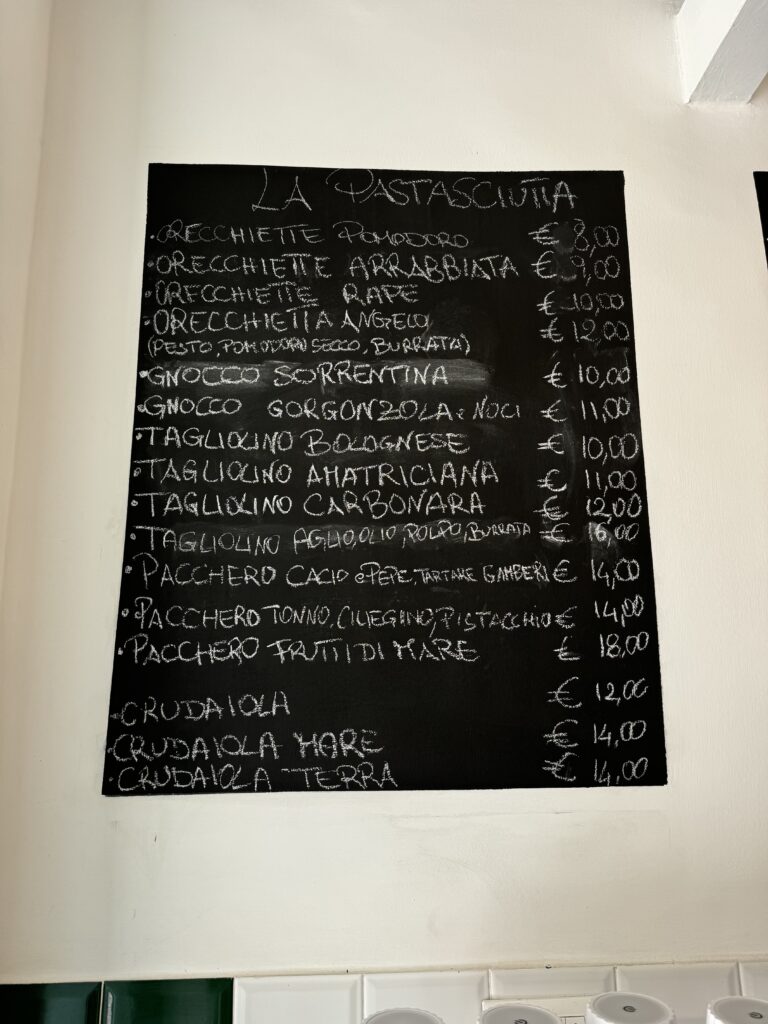
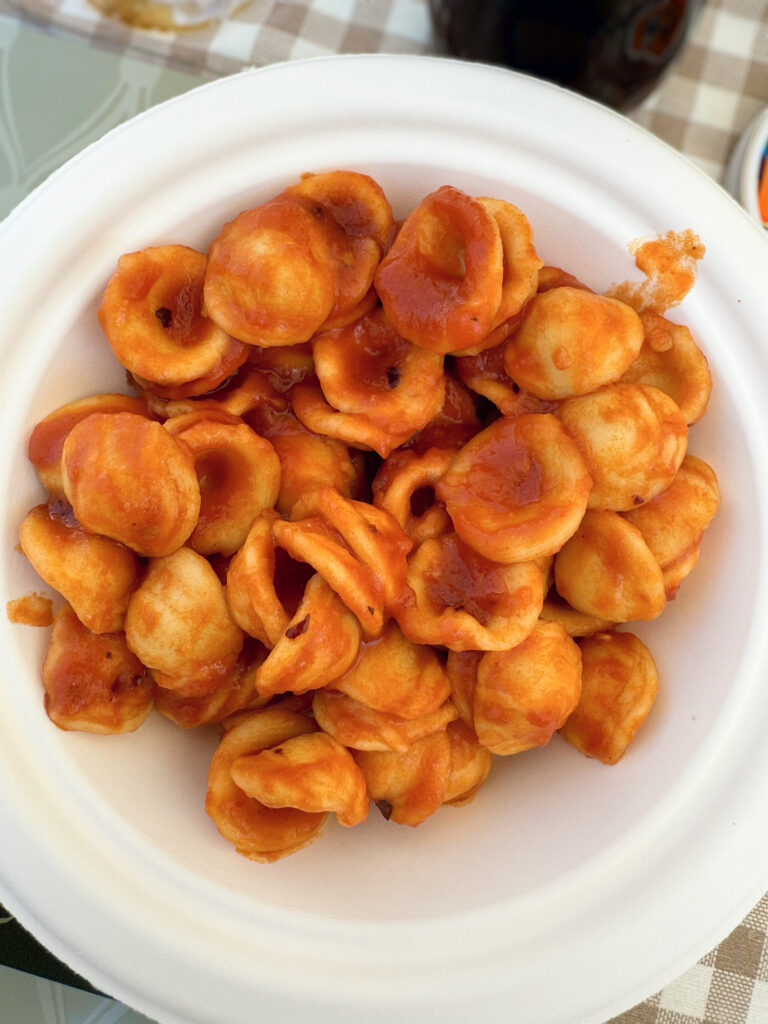
There is a 2€ coperto (cover charge) per person.
Via Vito Tamborrino, 15 | €-€€
Tito Schipa | for spaghetti all’assassina
Tito Schipa might not be an obvious destination for spaghetti all’assassina. The restaurant brands itself “Apulian Fusion Sushi“, not a cuisine we to recommend on a vacation in Puglia. For us “fusion” always rings alarm bells. It has to be done especially well. Wasabi mayonnaise simply doesn’t cut it. But new for 2025 they have a creditable spaghetti all’assassina (one of a few restaurants, if there are others, with assassina on the menu in Ostuni).
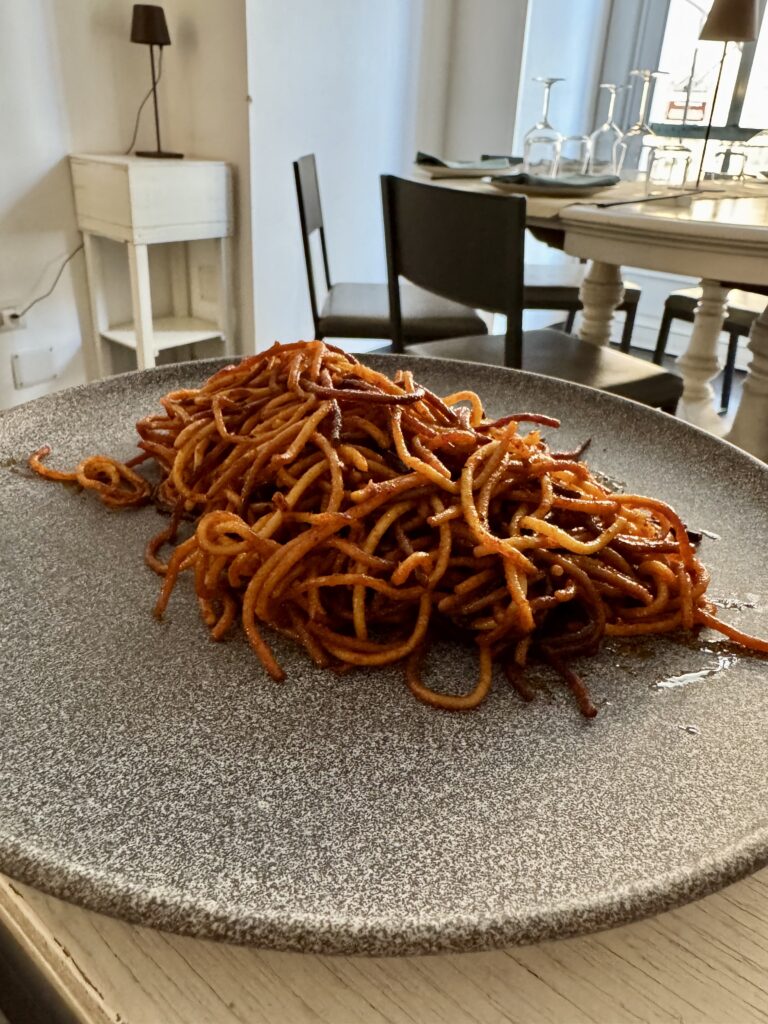
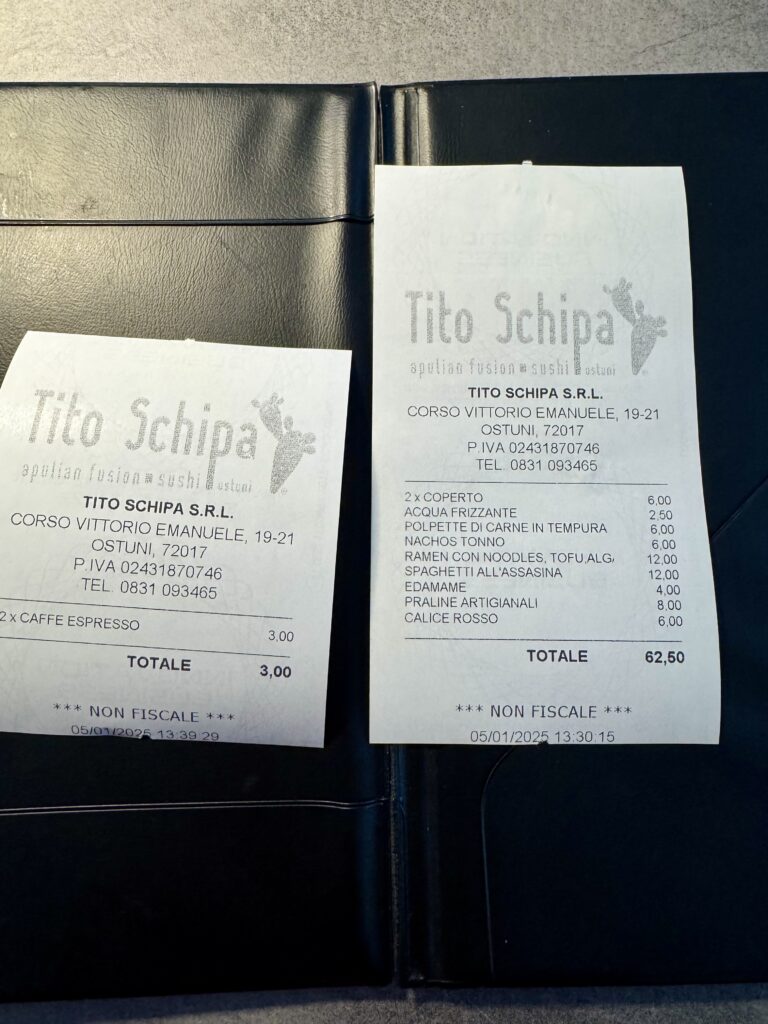
Check out the Puglia Guys’ review of Tito Schipa’s spaghetti all’assassina. Let them know we sent you for the assassina!
Corso Vittorio Emanuele II, 19-21 | €€€
Caffè Fanelli Bistrot | bar
Coffee, lunch and aperitivi. The best value Aperol Spritz on Ostuni’s main piazza.
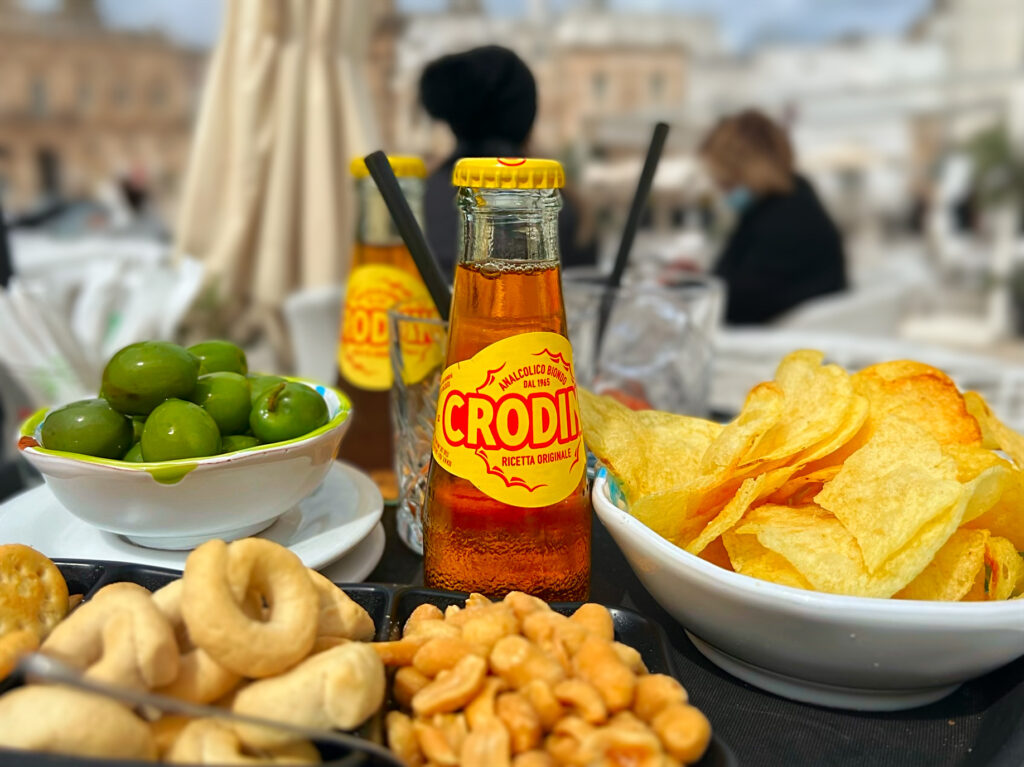
Our favourite spot for people watching, morning, anfternoon and evening. We go there for a coffee and pastry, or a later morning or afternoon/evening aperitivo. We love the crema al caffè on a summer morning.
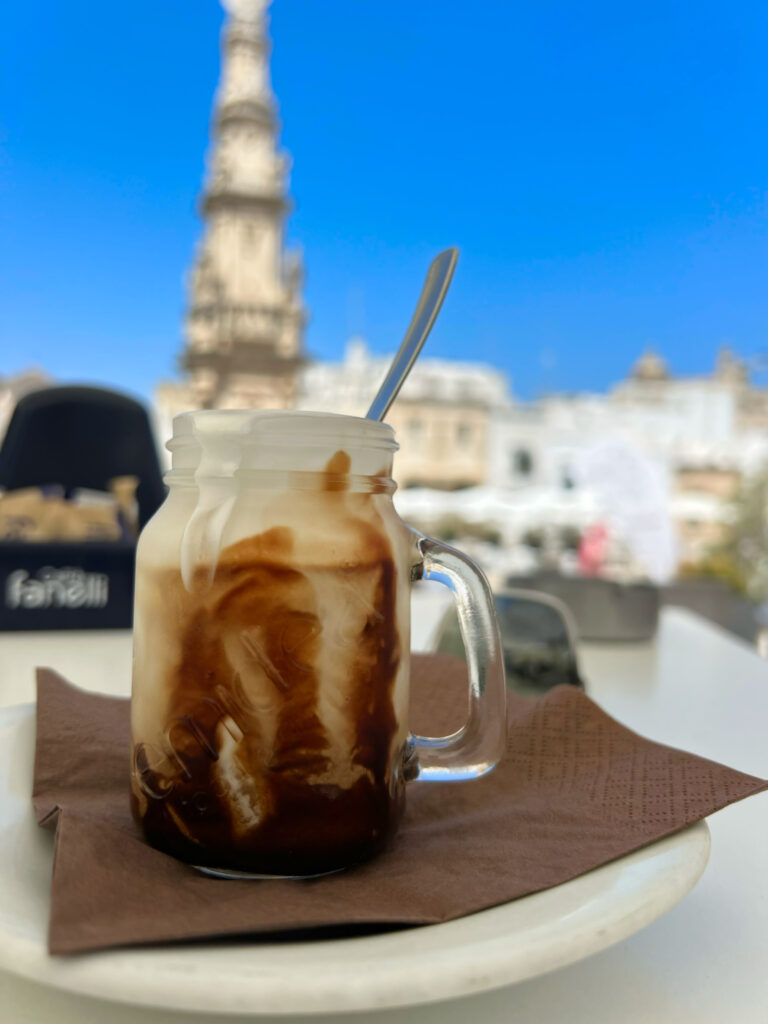
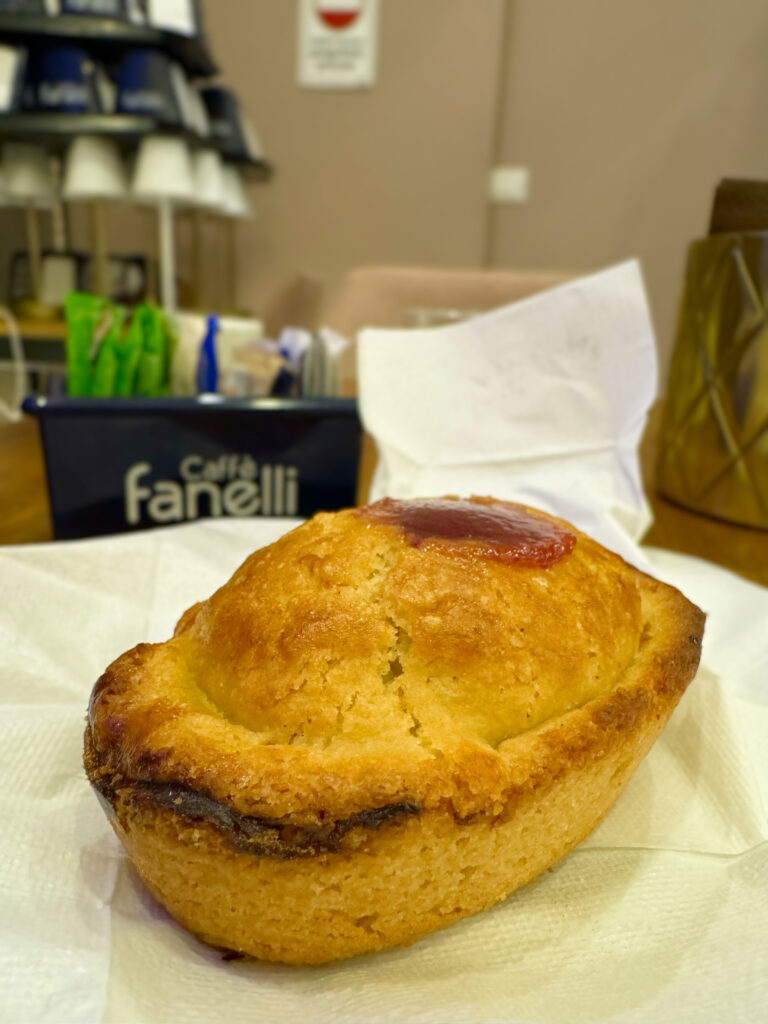
We are big fans of their home made lasagne – a must if you like your lasagne on the wet side, with plenty of sauce.
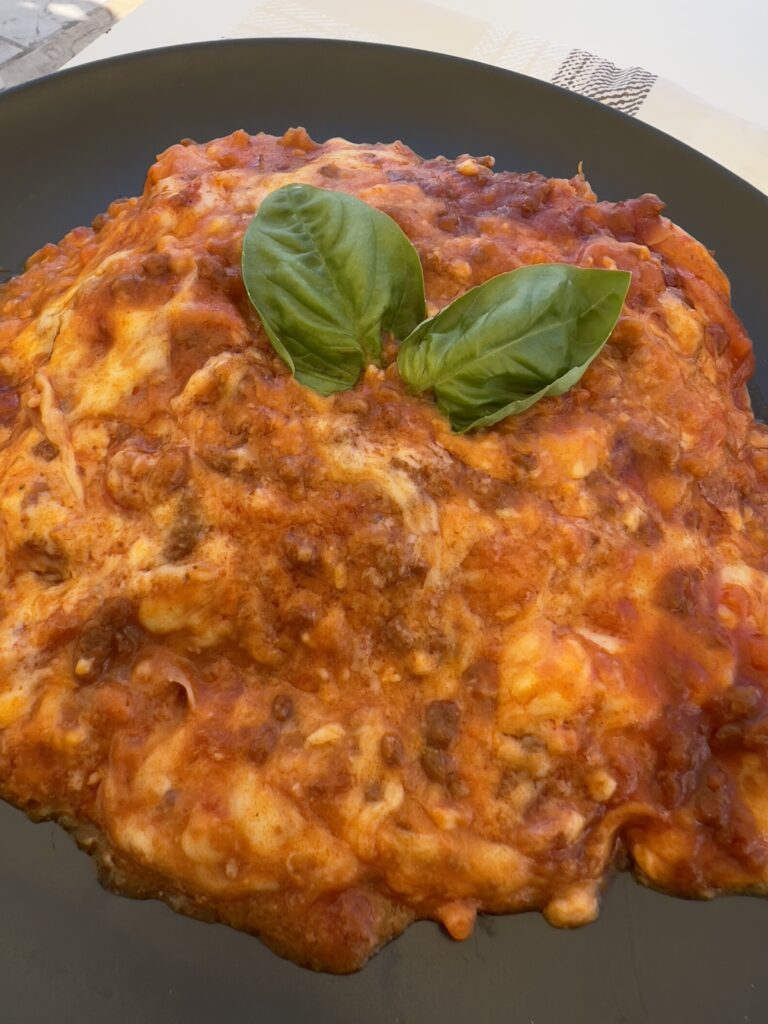
Fanelli cook their lasagne like we do – with prosciutto layered between the sheets of pasta and ragù.
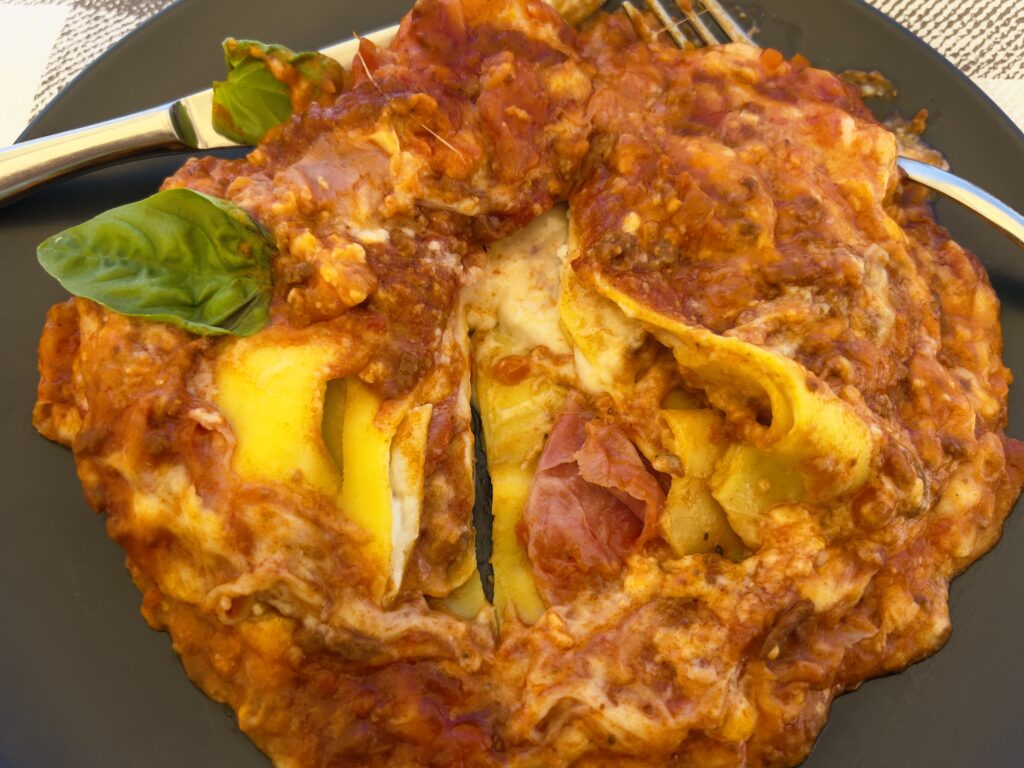
They also have a nice plate of orecchiette alla crudaiola. A lighter pasta dish with fresh tomato topped with grated cacioricotta cheese from Puglia, perfect in summer.
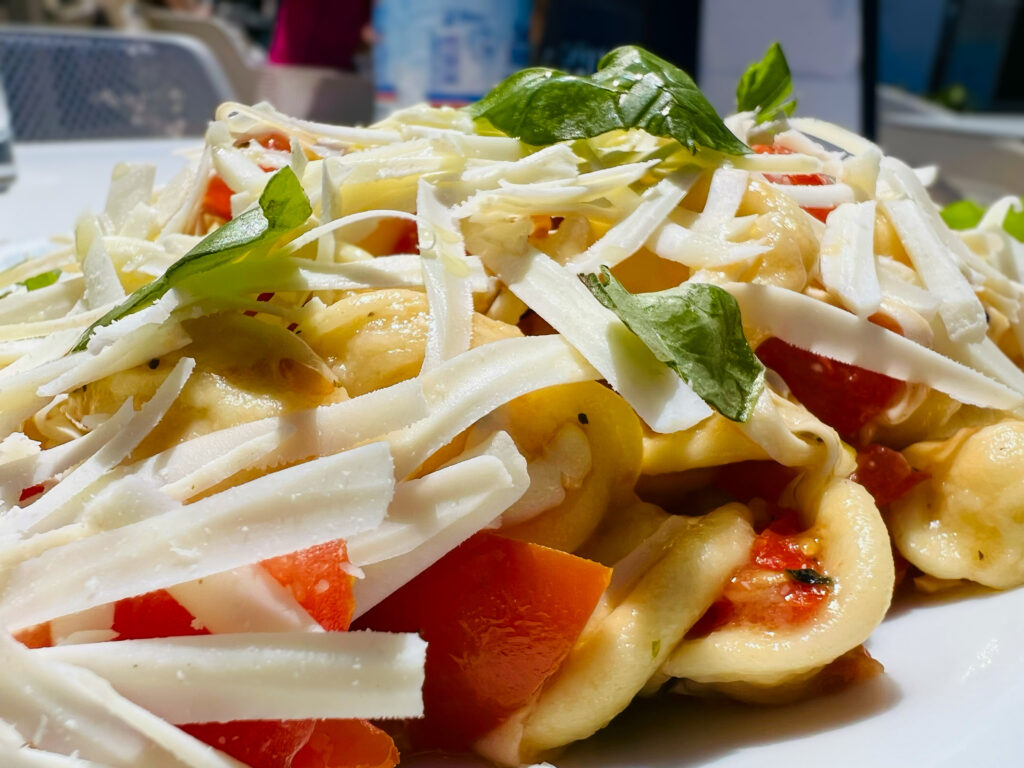
Fanelli is our preferred aperitivo spot. Their Aperol Spritz is served with a tris, a typical snack on the side. All for €5,90. The best value Aperol Spritz on Ostuni’s main piazza.
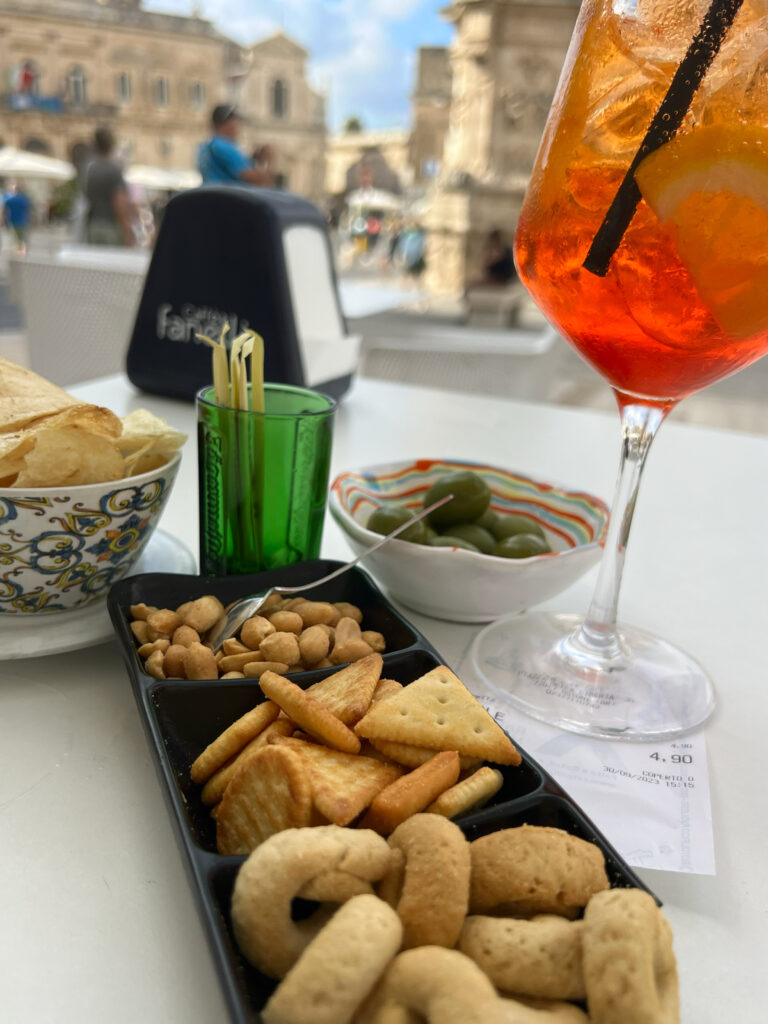
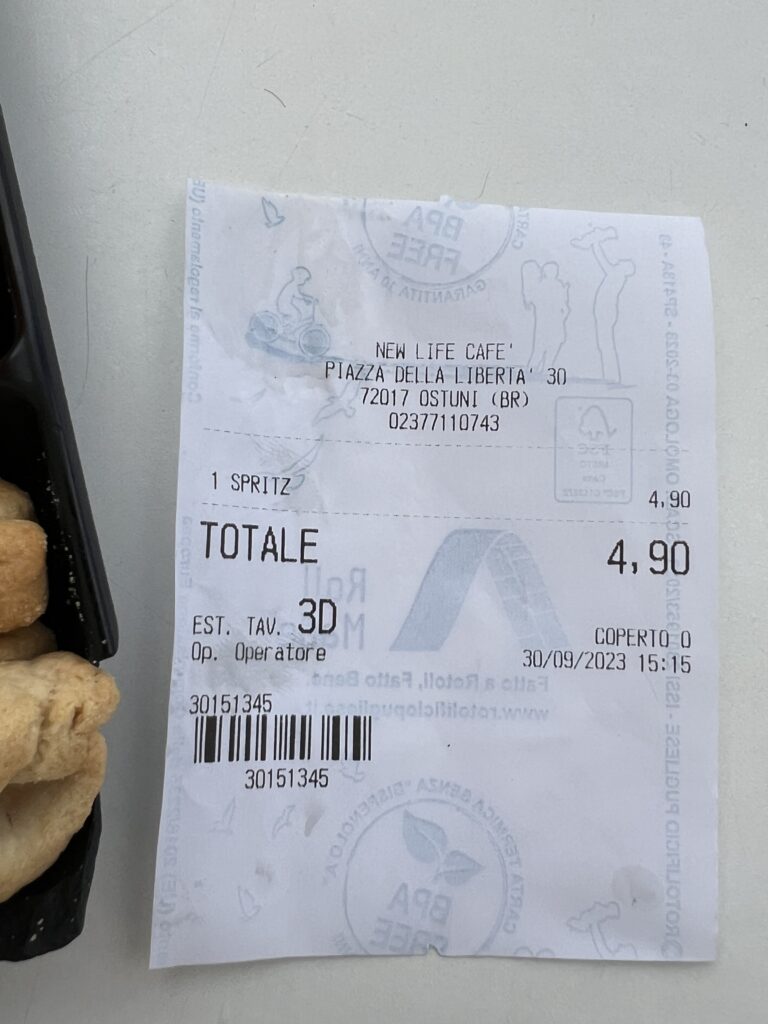
On the other side of the Sant’Oronzo column, only 10 metres away at Casbah expect to pay 15€ for the same. The only difference in price we can ascertain is for Casbah’s chic lounge bar surroundings.
📍Piazza della Libertà, (2 Corso Cavour) | €-€€
Borgo Antico Bistrot | bar
For aperitivo. Spectacular views over the olive groves to the Adriatic and a reasonably priced Aperol Spritz.
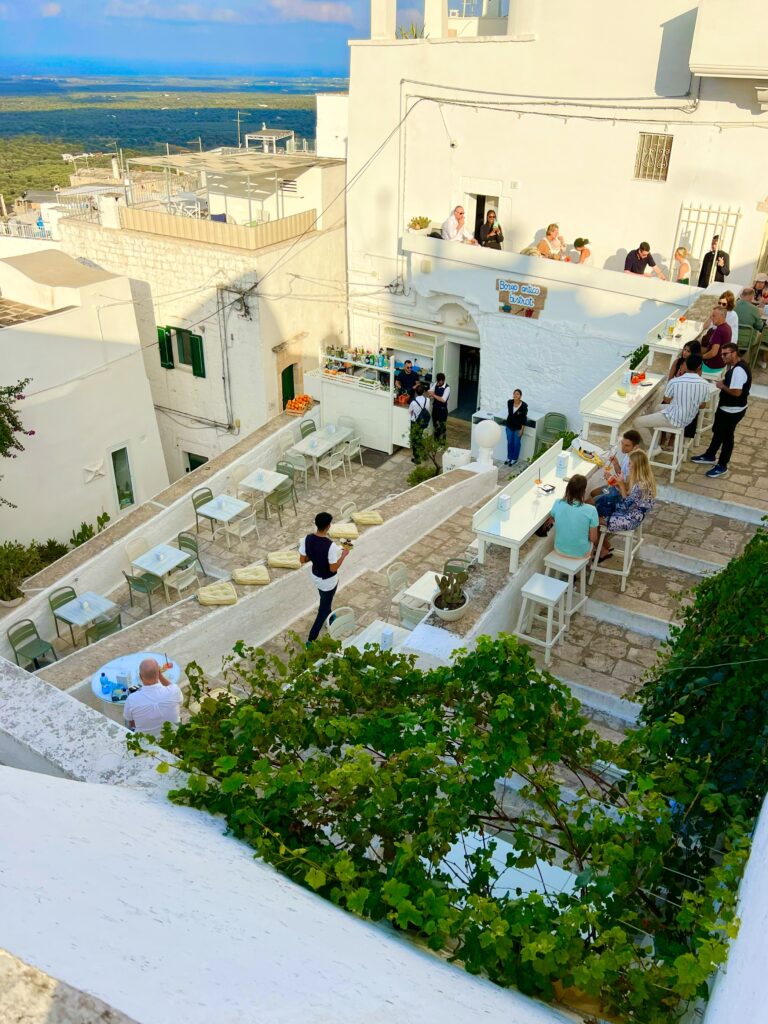
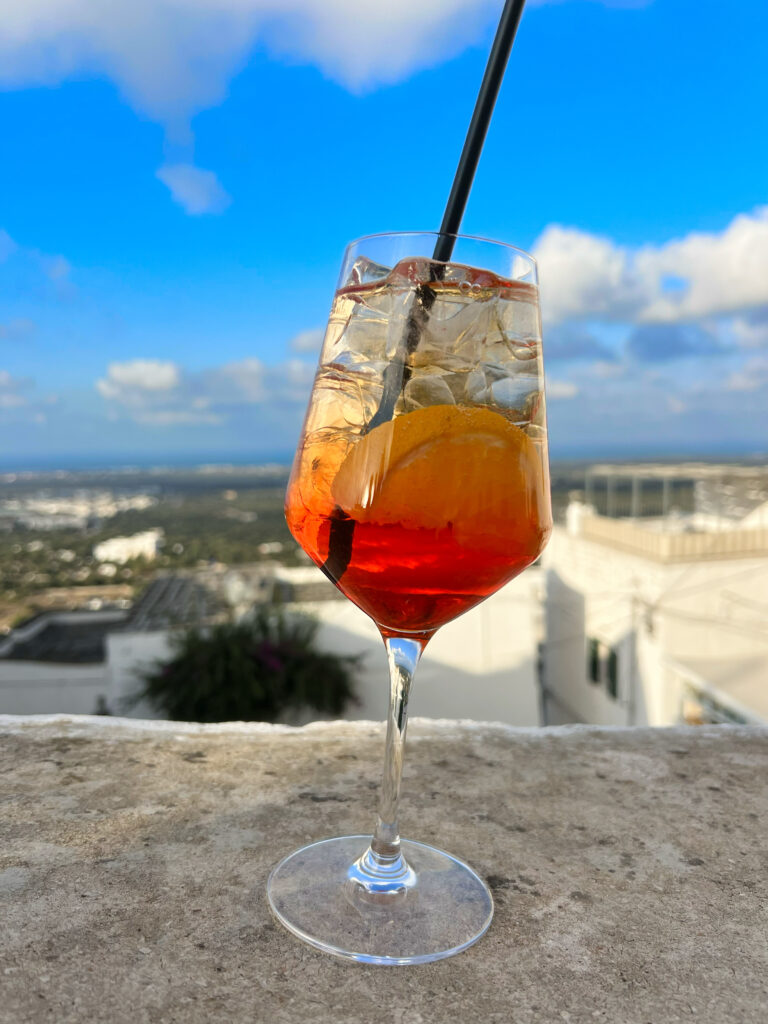
You might think given its prime location this would be an overpriced tourist trap, but fortunately not. A wonderful spot to pause after walking to the top of the old town, on the eastern side of Ostuni.
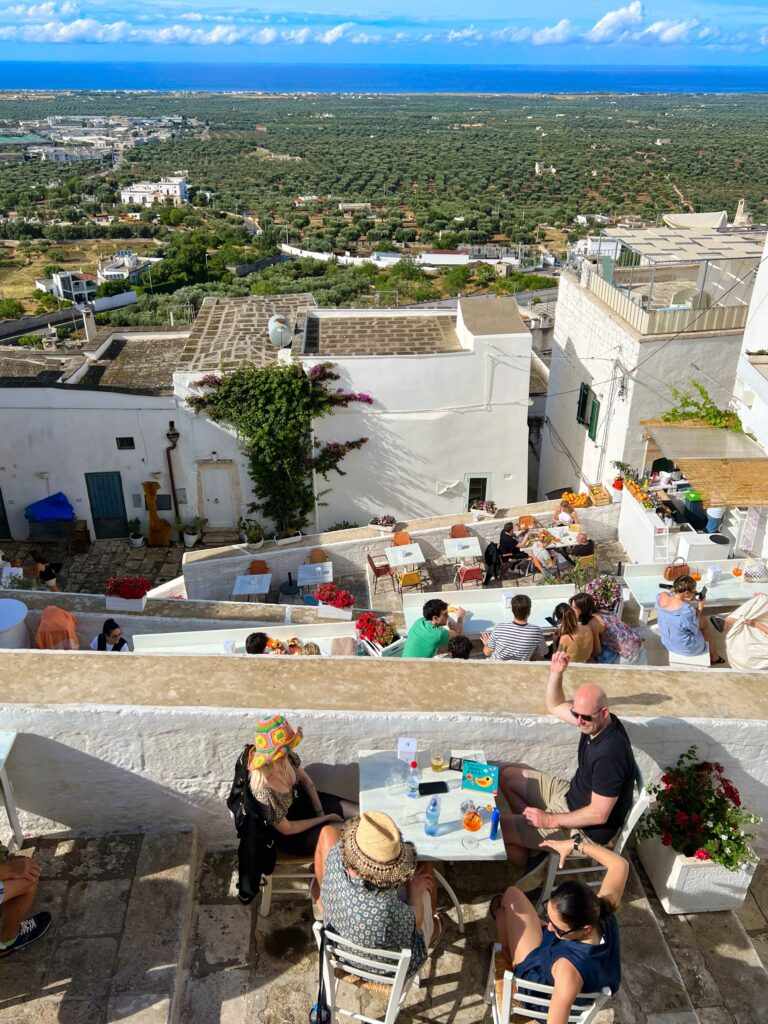
📍Via Fina, 8 | € – €€
Les cre’ fantastique | panzerotti eat in
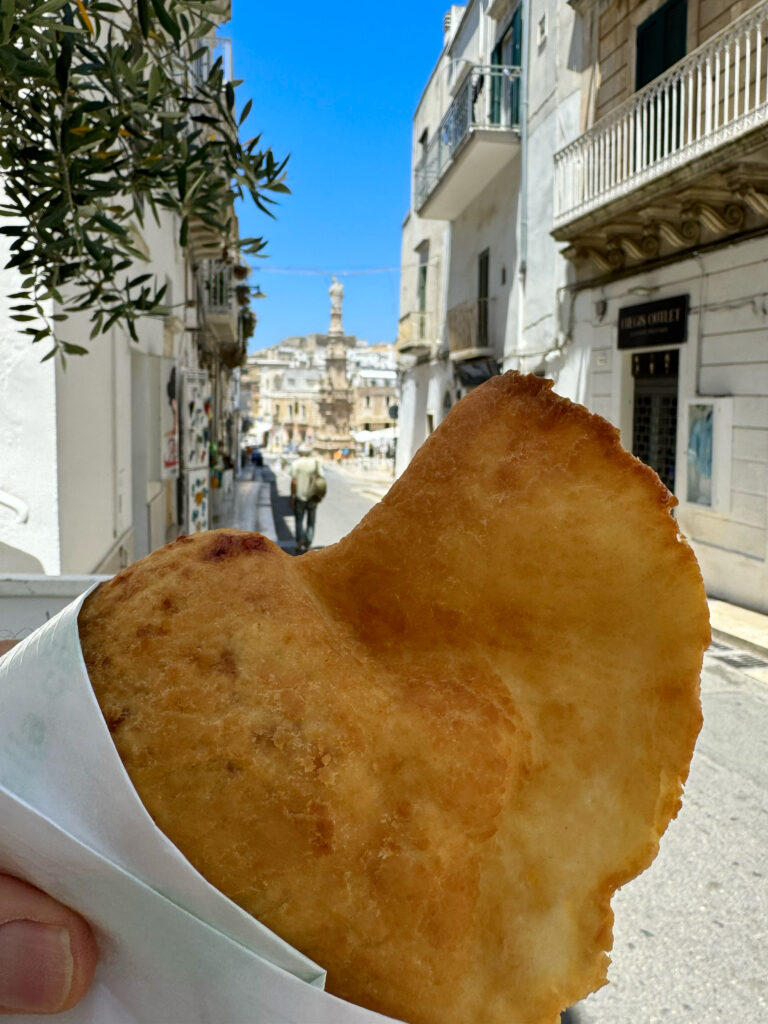
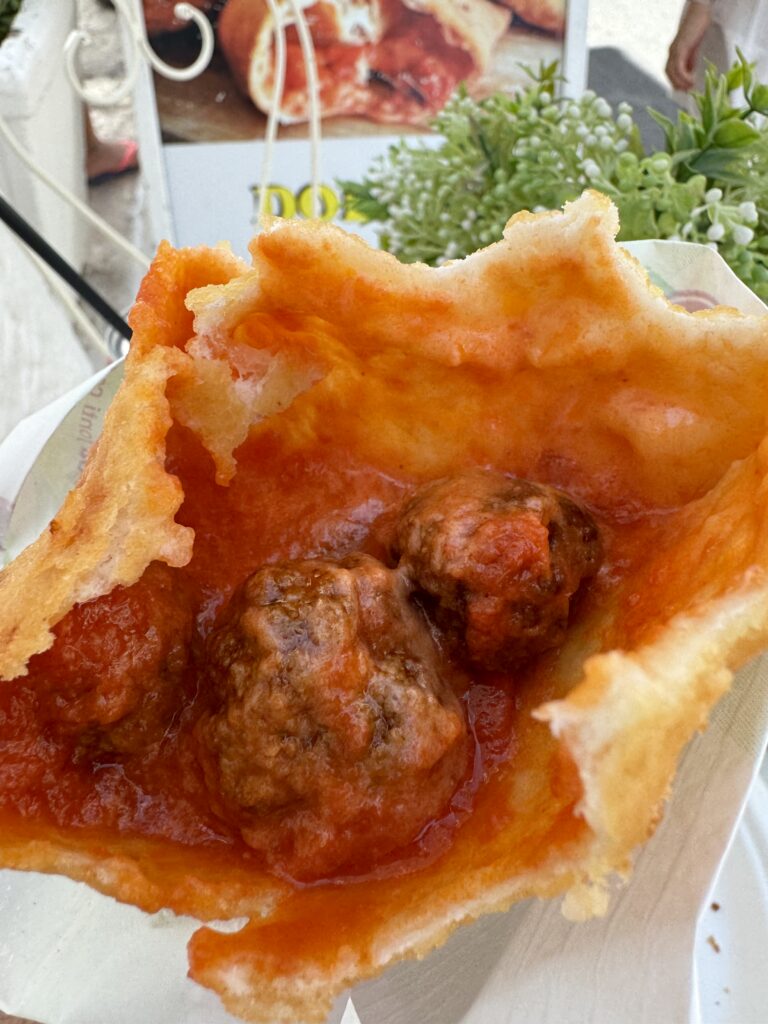
Panzerotti are one of Puglia’s epic street foods. Like a calzone pizza, only better! Les cre’ fantastique are tasty, filling and very inexpensive (classic €2,50). Watch them being made and fried in front of your eyes. Our favourites include the piccante panzerotto (with spicy salami, plus mozzarella and tomato), and the super tasty panzerotto with polpette della nonna.
📍Corso Camillo Benso Cavour, 22 | eat in, take-away | €
Asso di Spade | panzerotti to go
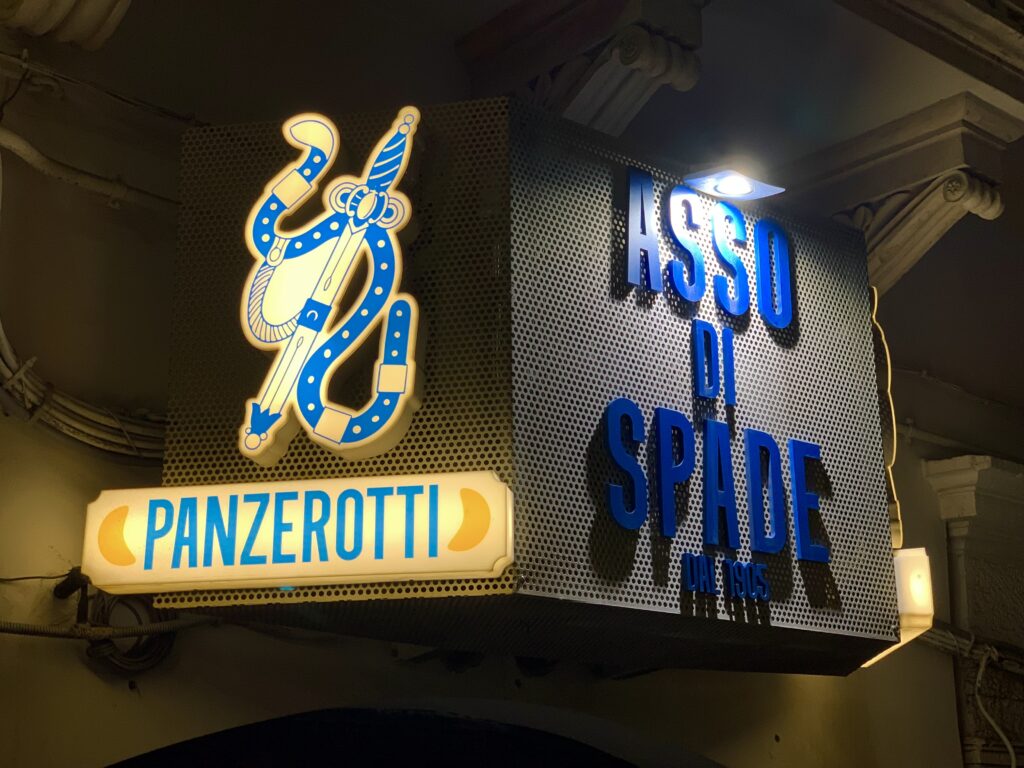
Asso di Spade has some great daily panzerotti specials including nduja, gorgonzola and guanciale as well as classic tomato and mozzarella. Hits the spot!
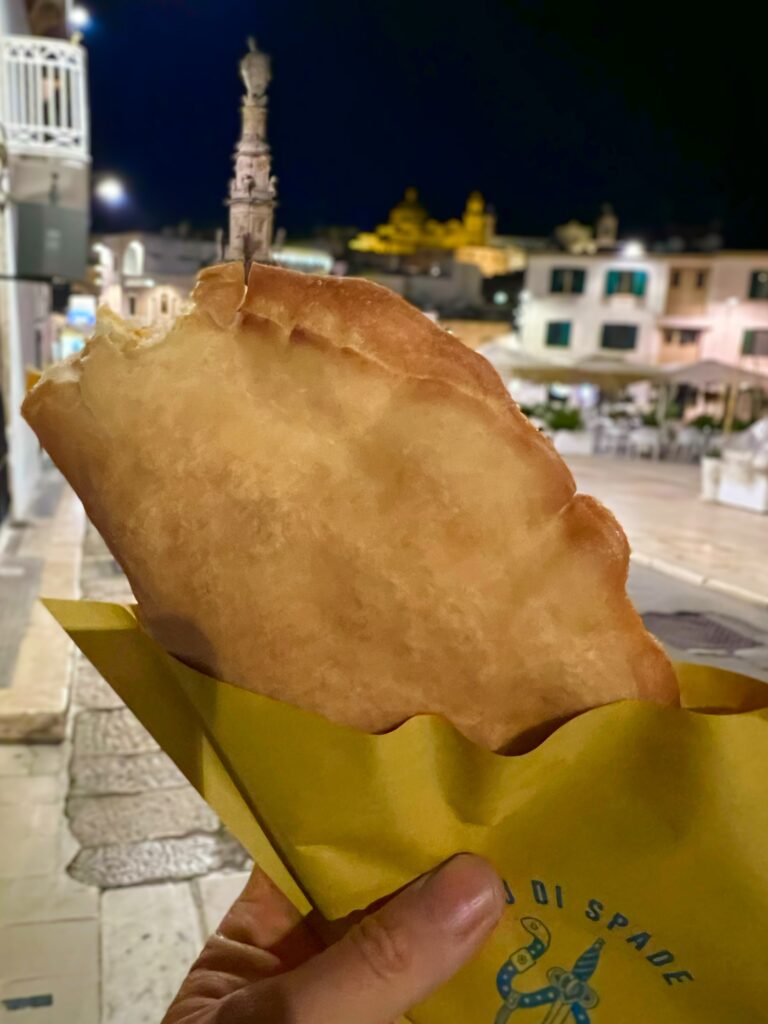
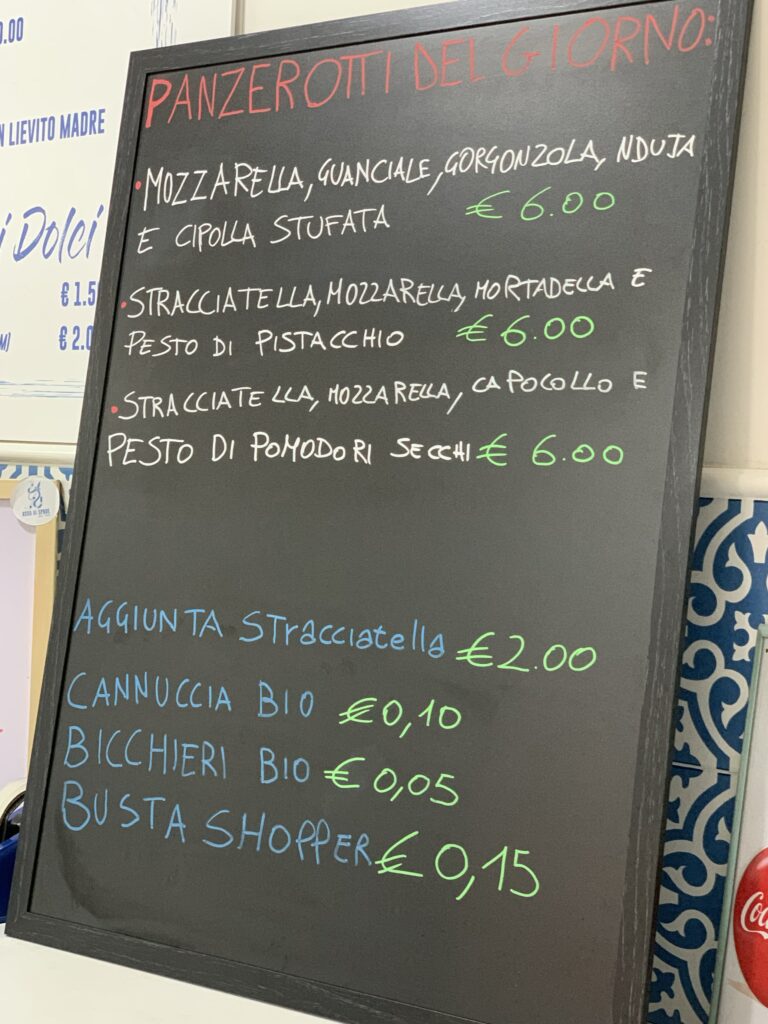
📍Via Benedetto Cairoli, 1 | take away | €
Gelaterie | for gelato artigianale
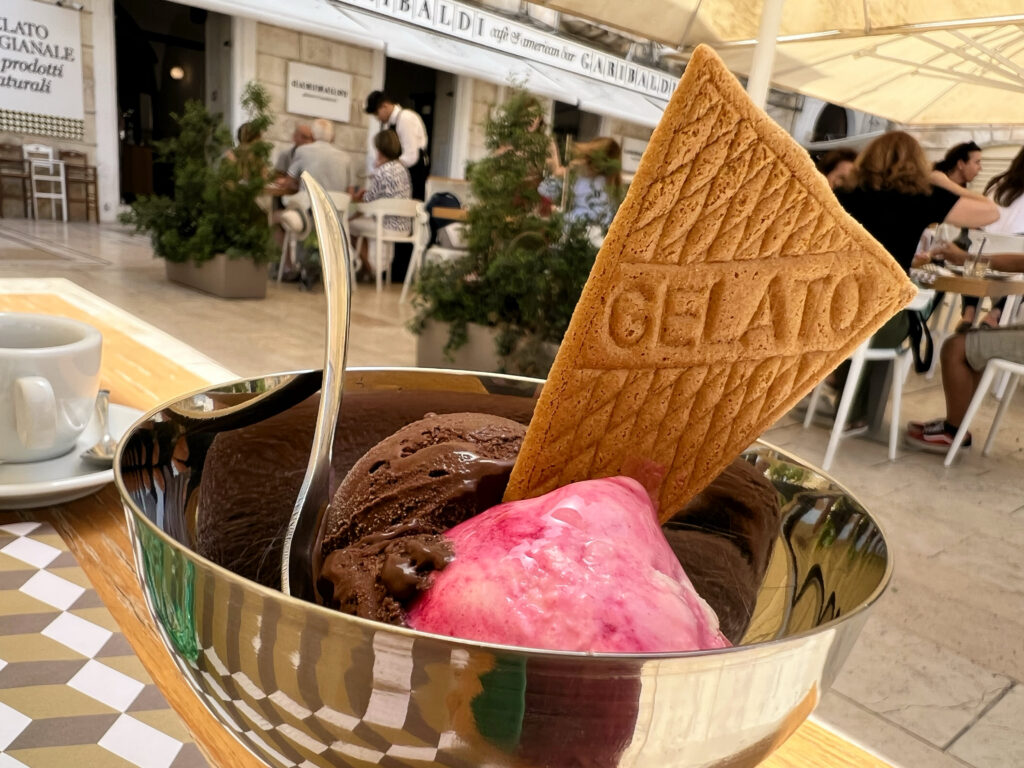
Bar Biancofiore (📍Corso Giuseppe Mazzini, 79) is a local favourite, known for its gelato. Flavours are limited to between 10-16 but that’s hardly a compromise! On the few times we have passed by and popped in, we found the gelato not to be as smooth as we usually find. There were many ice crystals as if it had part defrosted and frozen again.
However, we were in no doubt about the excellent gelato at Ciccio in Piazza Ciccio Pastigel Ostuni (📍Via Armando Diaz, 66). It’s just a little out of the way for visitors focussed on the old town. But it is certainly worth a visit, not just for the great gelato, but also its pastries.
Just down the steps from Sant’Oronzo’s column (conveniently next door to the cheap and cheerful but highly recommended La Pastaciutta) is the wonderful Cremeria alla Scala. It’s convenient and the gelato was smooth and creamy the fragola, in our combo of strawberry and dark chocolate, very subtle (📍Via Vito Tamborrino, 17).
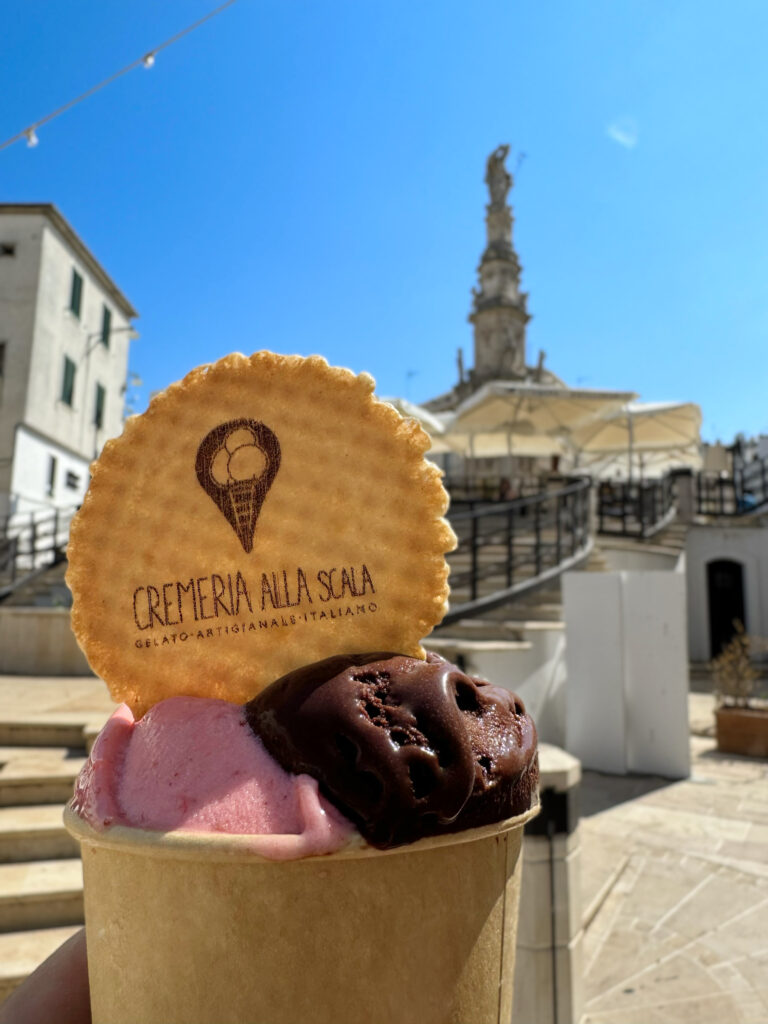
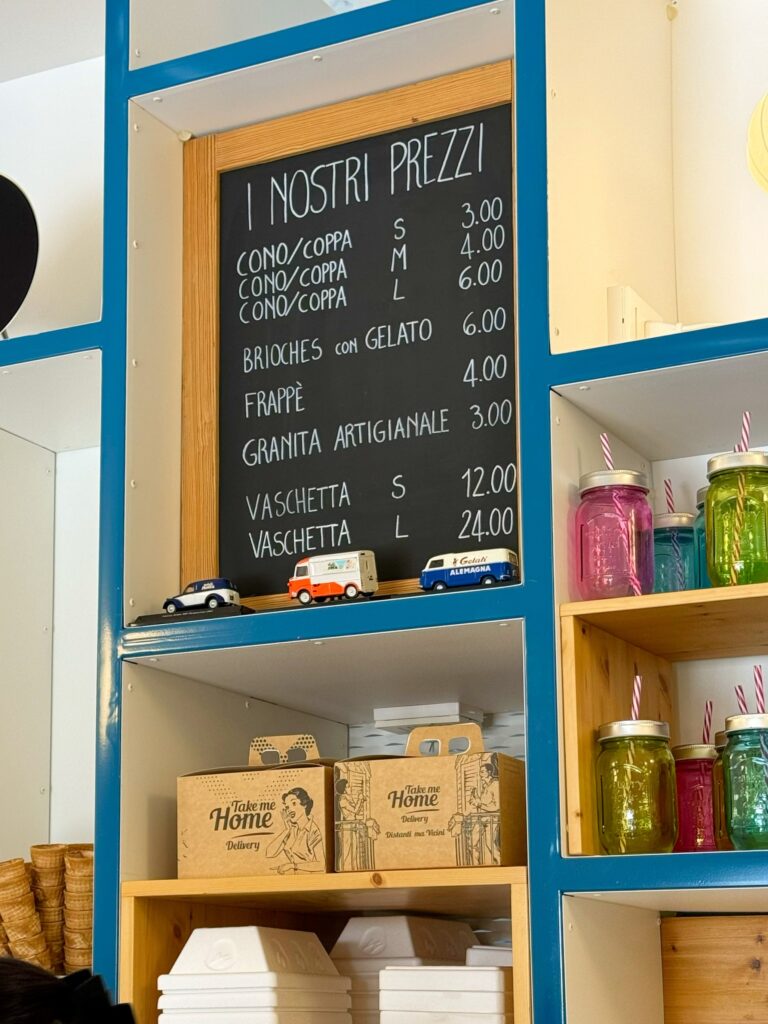
Caffè Garibaldi on the main piazza (📍Piazza della Libertà, 52/53) has one of our favourite flavour combinations. Fondente, a deep dark chocolate, and amarena is a particularly spectacular combination. Caffè Garibaldi is our spill over lunch spot if we can’t get a table at Ostuni Bistrot. They have good pizza and they do a version of spaghetti all’assassina, but it is a variation on the classic crunchy, burnt version. Using spaghetti that is already cooked, it is more like a spaghetti all’arrabbiata.
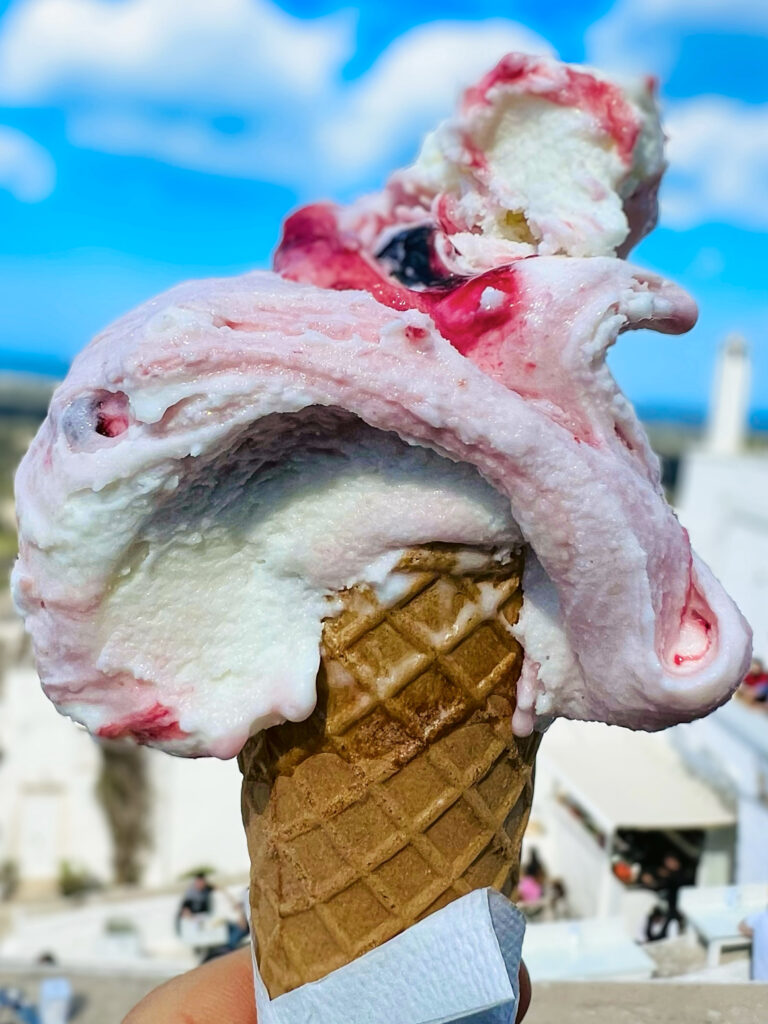
Alternatively head to the top of the centro storico. After the duomo and just beyond Arco Scoppa for the Gelateria Borgo Antico (📍Gelateria Borgo Antico).
Ostuni outskirts
Masseria Moroseta | fine dining
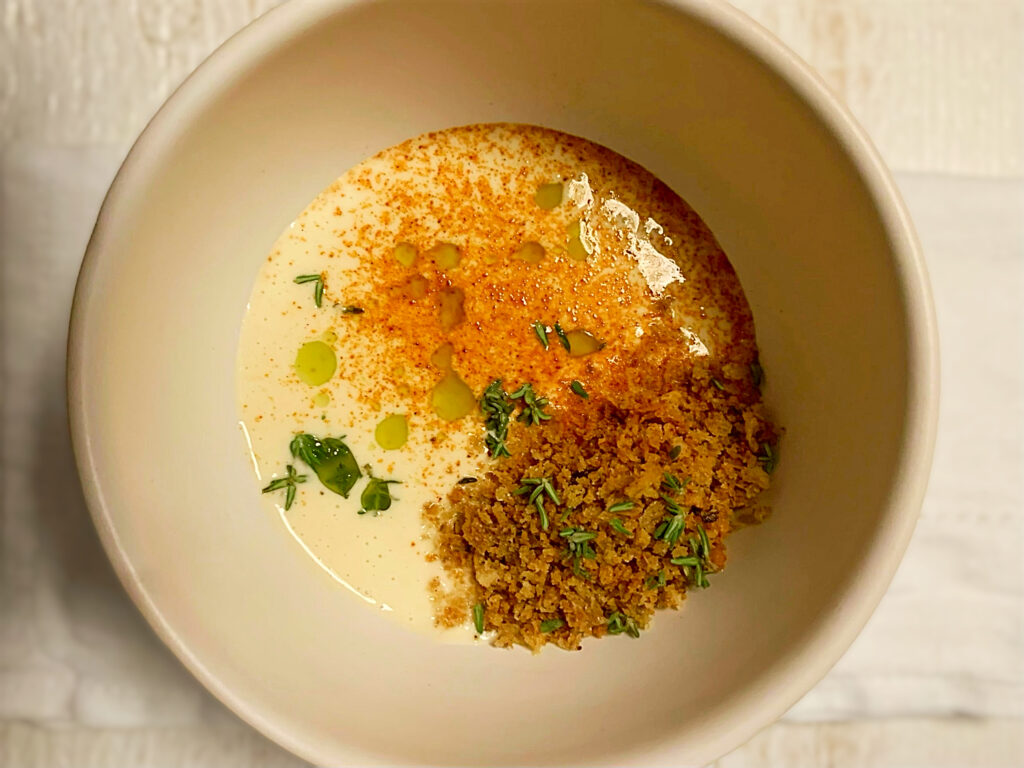
A modern take on traditional dishes in minimal surroundings. Expensive, but exceptional dining. A short drive from Ostuni en route to the main highway. Fixed menu, price on booking (booking essential, the restaurant fills up well in advance).
€€€€€
📍Contrada Lamacavallo snc, 72012 Ostuni
+39 338 18 99 199
Trattoria Il Cortiletto
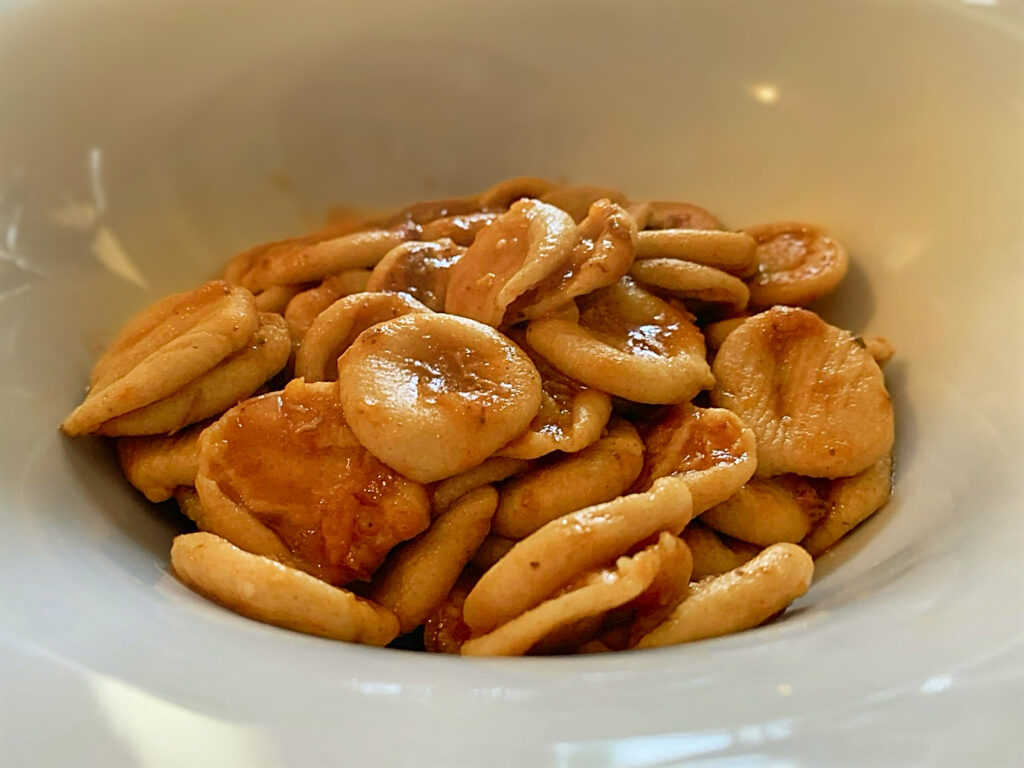
Good food in modest unassuming surroundings. A short drive from Ostuni en route to the main highway.
€€
📍Via Lecce 91, 72015 Speziale
+39 080 481 0758
Carovigno | 8km from Ostuni
Nearby neighbour Carovigno punches well above its weight with fantastic bars, restaurants and a really intimate old town. From a family run trattoria to a Michelin starred restaurant on the main piazza, and from a sizzling hot Naples pizzeria to an amazing Braceria grill restaurant (a speciality of the region), it has a top choice of places to eat at.
Where we avoid
We visit most places when writing and updating our Ostuni guide. If we don’t like it we usually don’t mention it. But if we have a negative experience, only then do we recommend not visiting.
RICCARDO caffè
You will find this on the far side of the old town, on Via Gaetano Tanzarella Vitale, 61 just along from Osteria Del Tempo Perso.
Offering aperitifs and cocktails in a cave setting with a trendy outside seating area marked by beanbags up and down the stone steps, beware of being overcharged and paying for unexpected extras. We pointed out that it was not permitted to charge more than the menu price, required to be displayed by Italian law. We were refunded but in what we considered a very aggressive, confrontational and threatening manner, we were ultimately asked to leave, and escorted off the premises.
Osteria Del Tempo Perso
When we visited we were disappointed with the quality of the food, which we found overpriced and very ordinary. This restaurant is often highly recommended by tourists for its traditional cuisine. The majority of its customers are tourists, who recommend it to other tourists. It would be unusual for locals to eat there.
Casbah Risto Café
Trendy bar just off the main Piazza adjacent to Sant’Oronzo’s column. A prime location but with matching premium pricing. At 15€ the most expensive Aperol Spritz on the piazza. Do not sit there without checking out the prices first! Just 10 metres away on the other side of the column, at Fanelli an Aperol Spritz served with snacks costs much less than half the Casbah price!
Easter 2025 Update: You might notice the outdoor seating at Casbah has been removed. This has been confiscated due to an alleged infringement caused by the seating areas extending into public highway beyond the permitted concession!
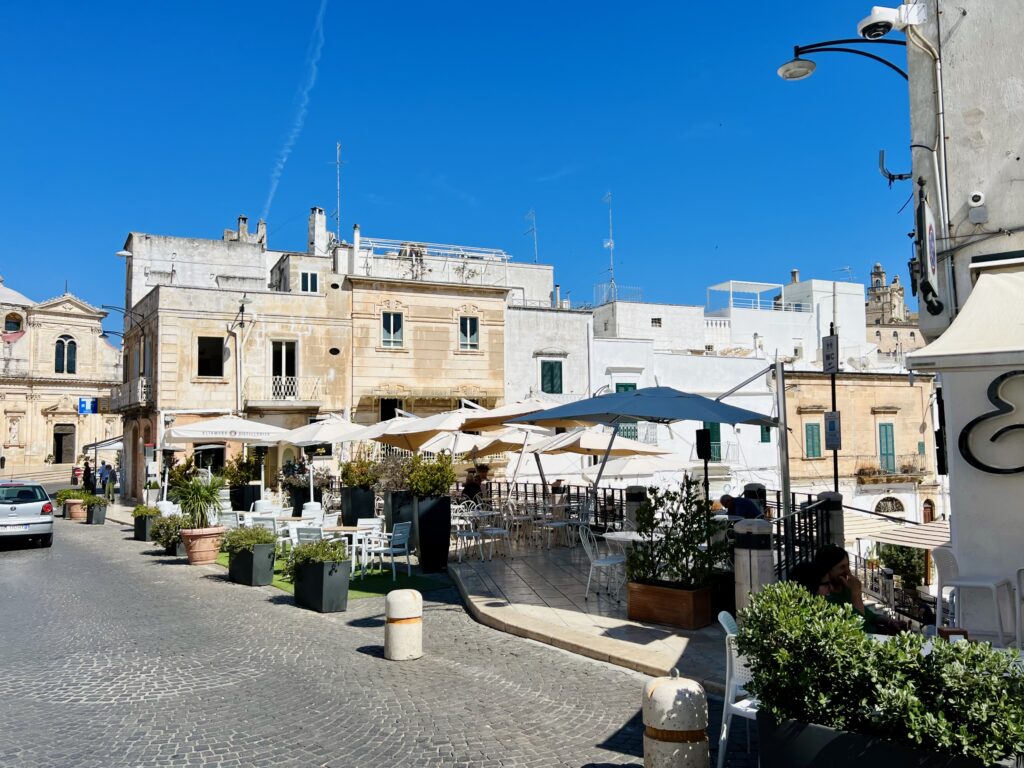
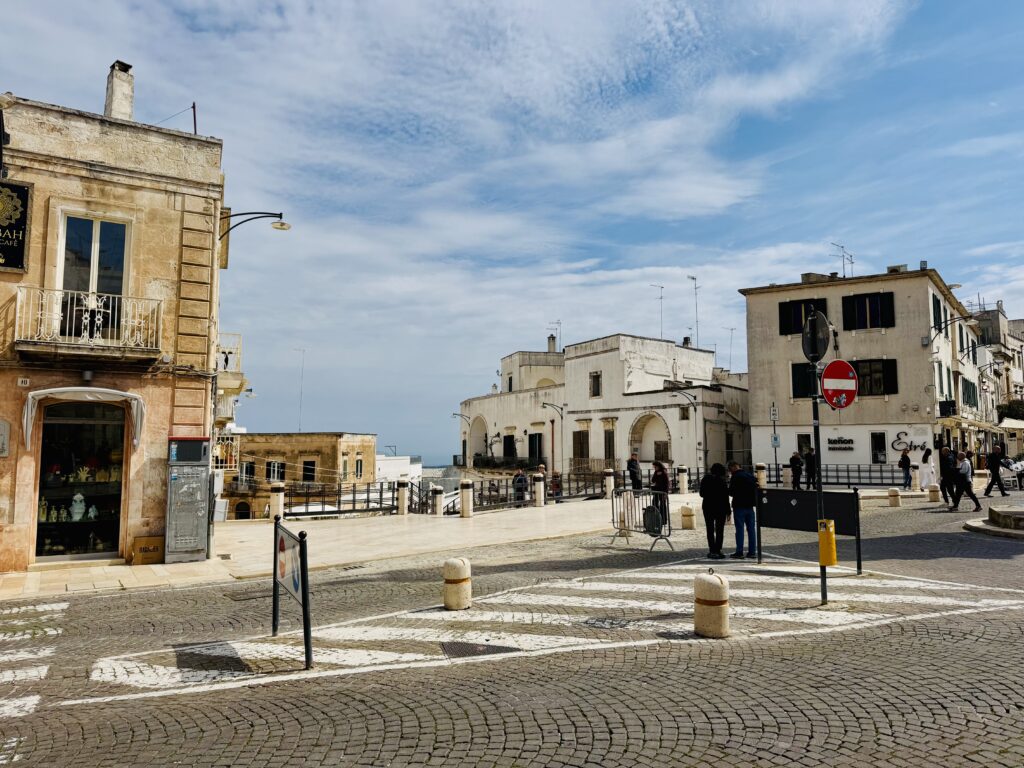
More | for reviews and thoughts on other Puglia restaurants, bars and eateries, check out our #EatPuglia Guide to Puglia’s best restaurants and places to eat.
2. Ostuni guide | our favourite nearby beaches
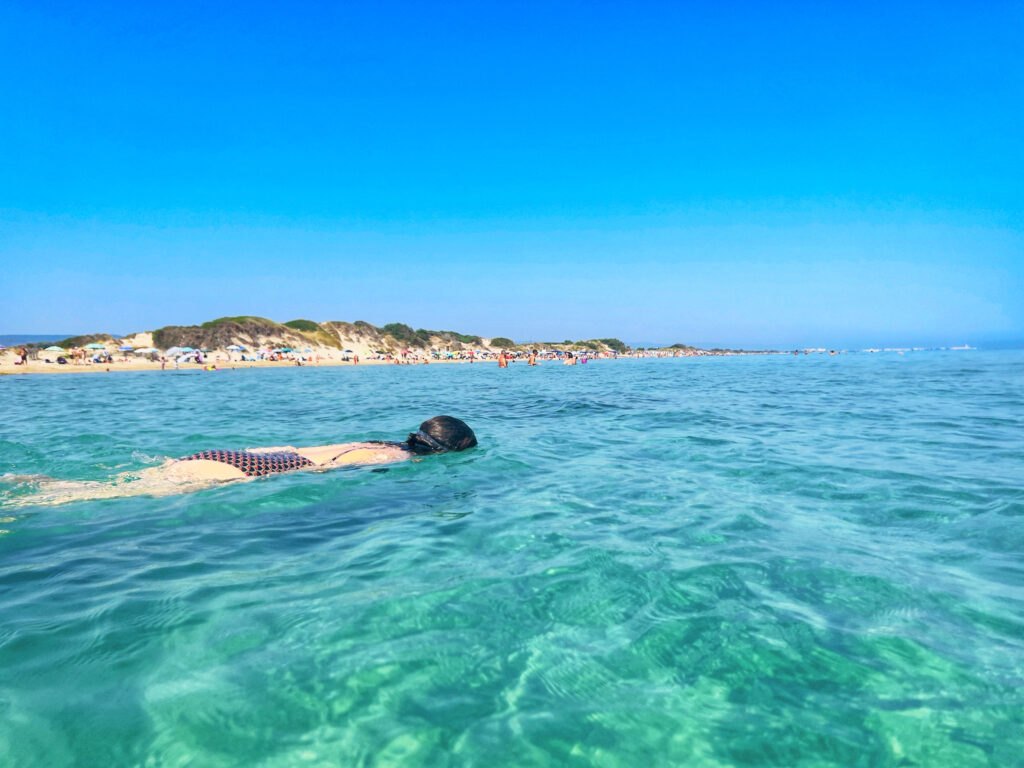
The stretch of the Adriatic coast from Bari south has more rocky coves than the endless strips of sandy beach you will find on the Ionian coast. Nevertheless there are some fine sections to enjoy, especially around Ostuni.
Savelletri
Long stretches of sandy beach. Many private lidos with loungers, umbrellas, bars and restaurants but fewer free public beaches.
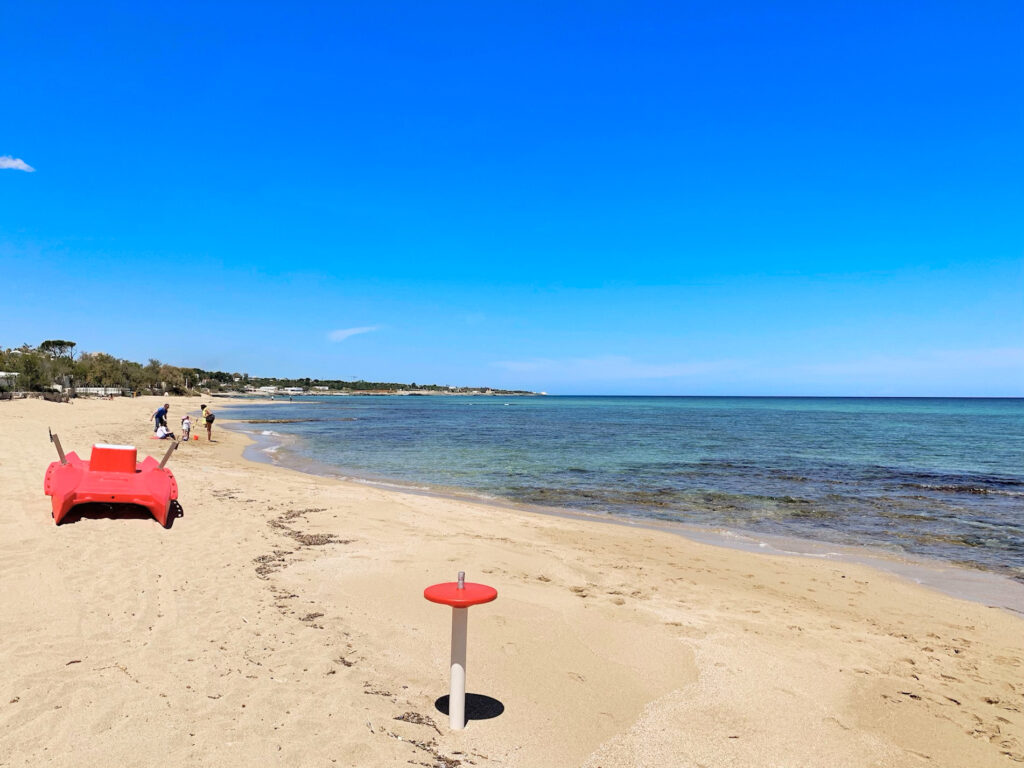
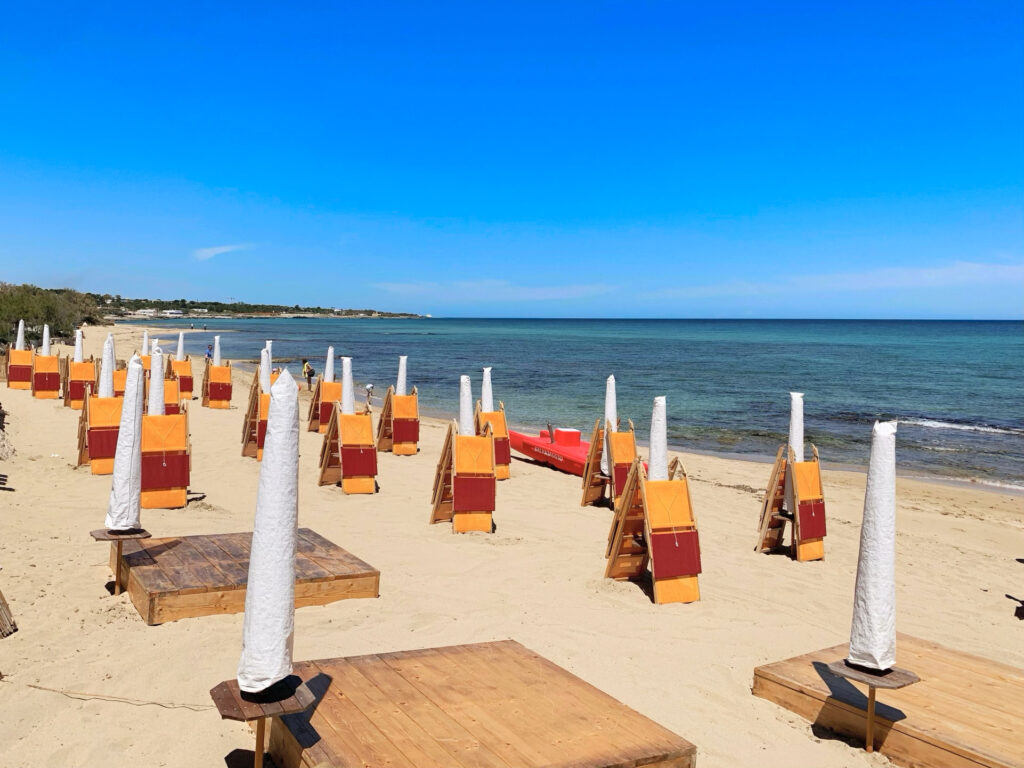
📍Savelletri Beaches SP90, 72015 Fasano (BR).
Torre Canne
Long stretches of public, sandy beaches. Popular with families and sports enthusiasts, there is canoeing and kite surfing.
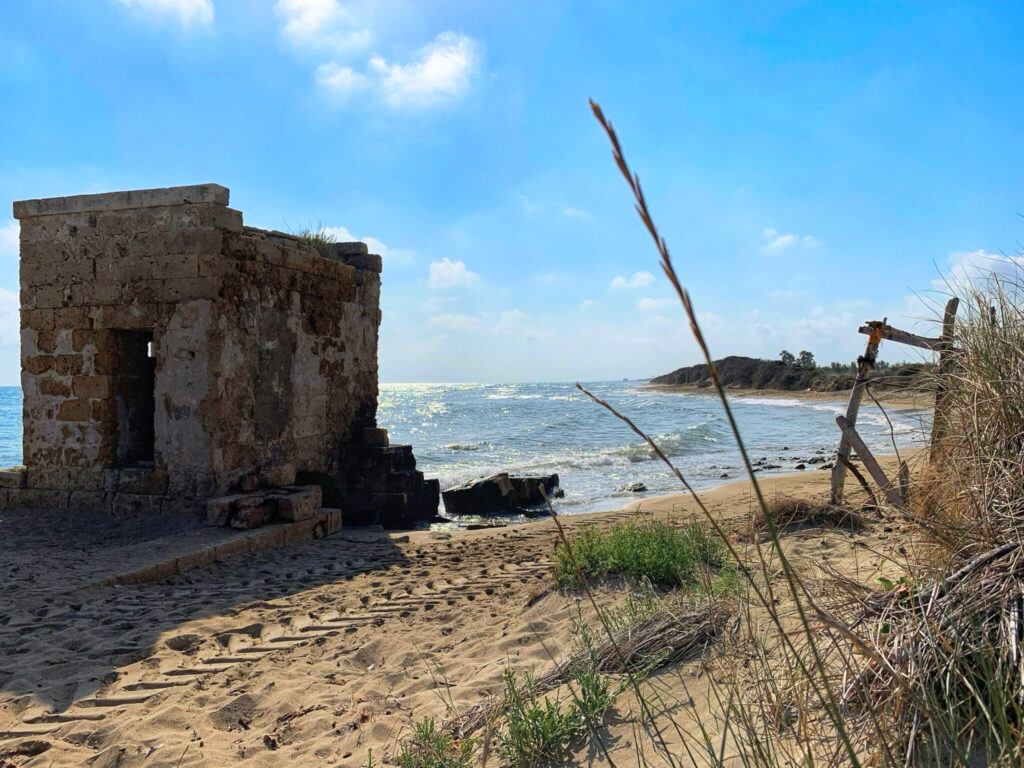
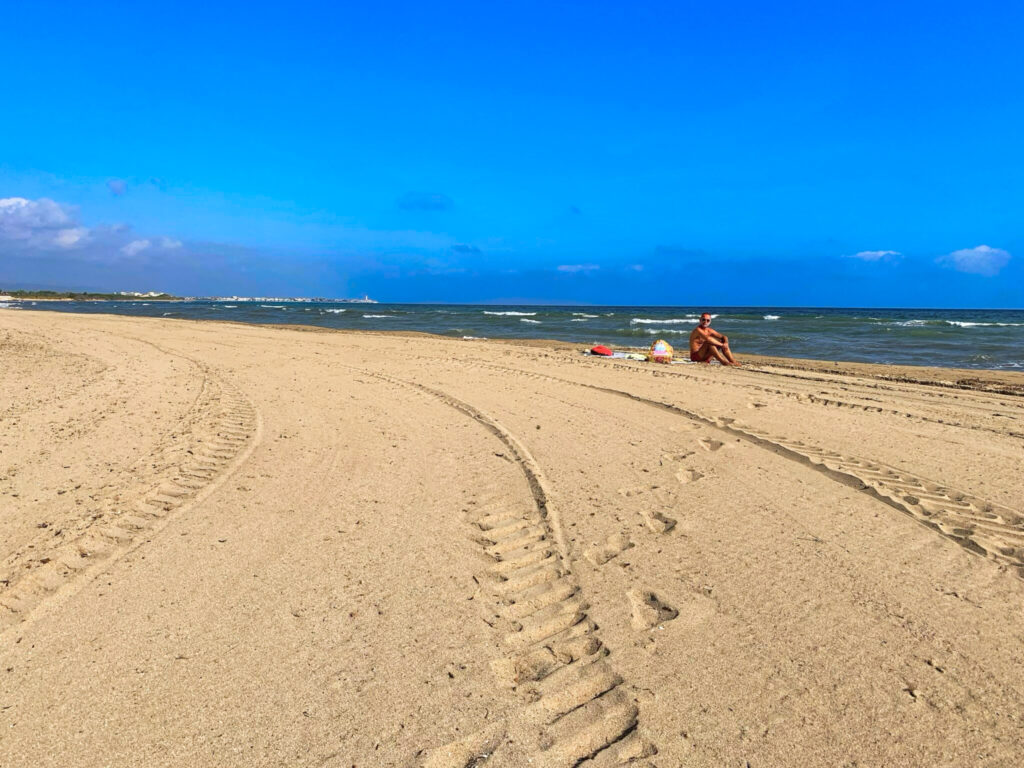
📍Spiaggia di Torre Canne, Via Eroi del Mare, 72016 Tore Canne, Fasano (BR) to Lido Morelli.
Pilone
Sandy beach, popular with residents of the camping and touristic villages nearby, who often arrange for residents’ beach club activities for kids, so it can get noisy!
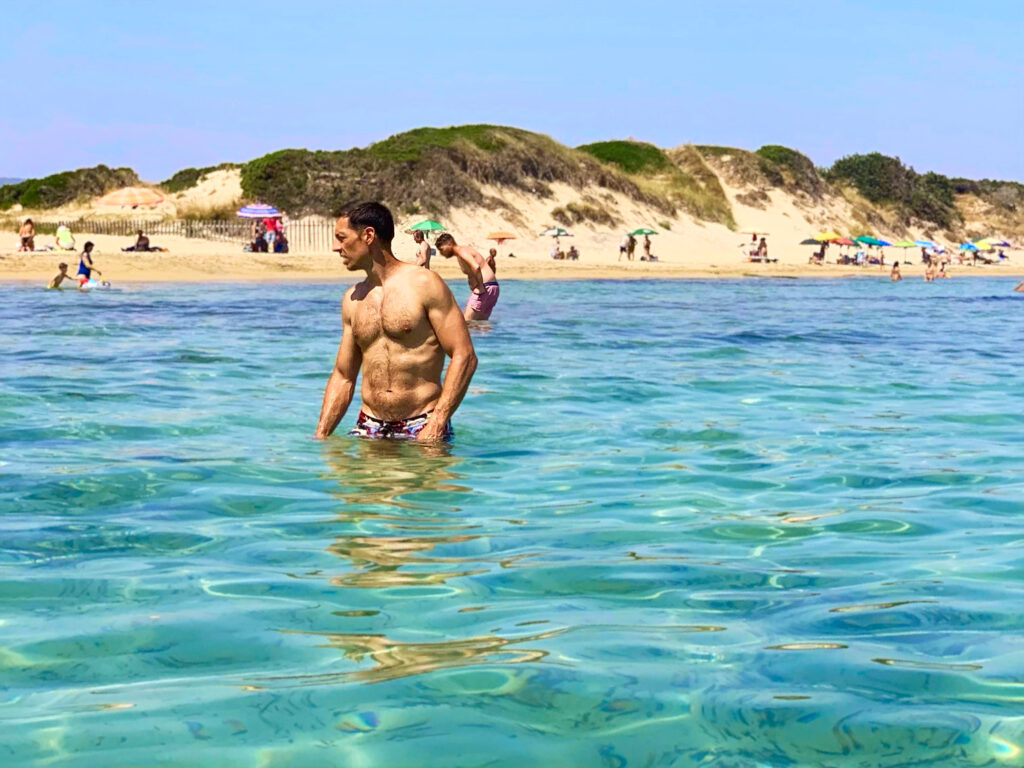
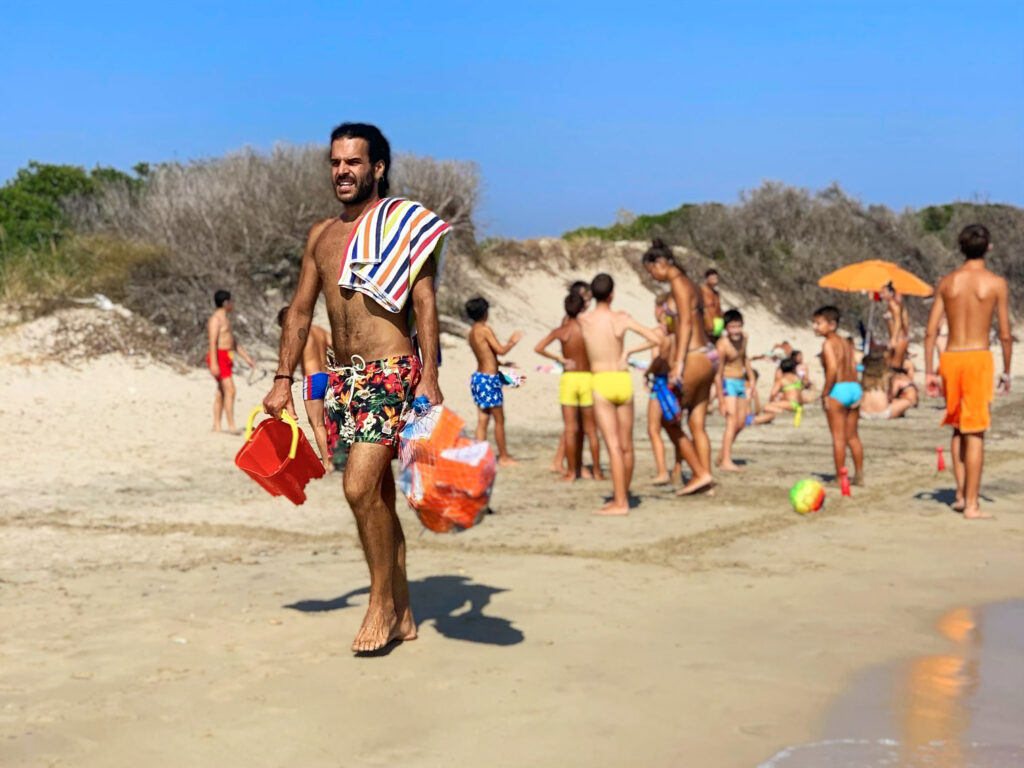
📍Spiaggia di Pilone, Torre Pilone, Ostuni, Via mare Adriatico, 72017 Ostuni (BR).
Torre Pozzelle | Lamaforca
Small sandy beaches in rocky coves, surrounded by pine forest. Both are popular with the families who stay in the nearby camping touristic villages.
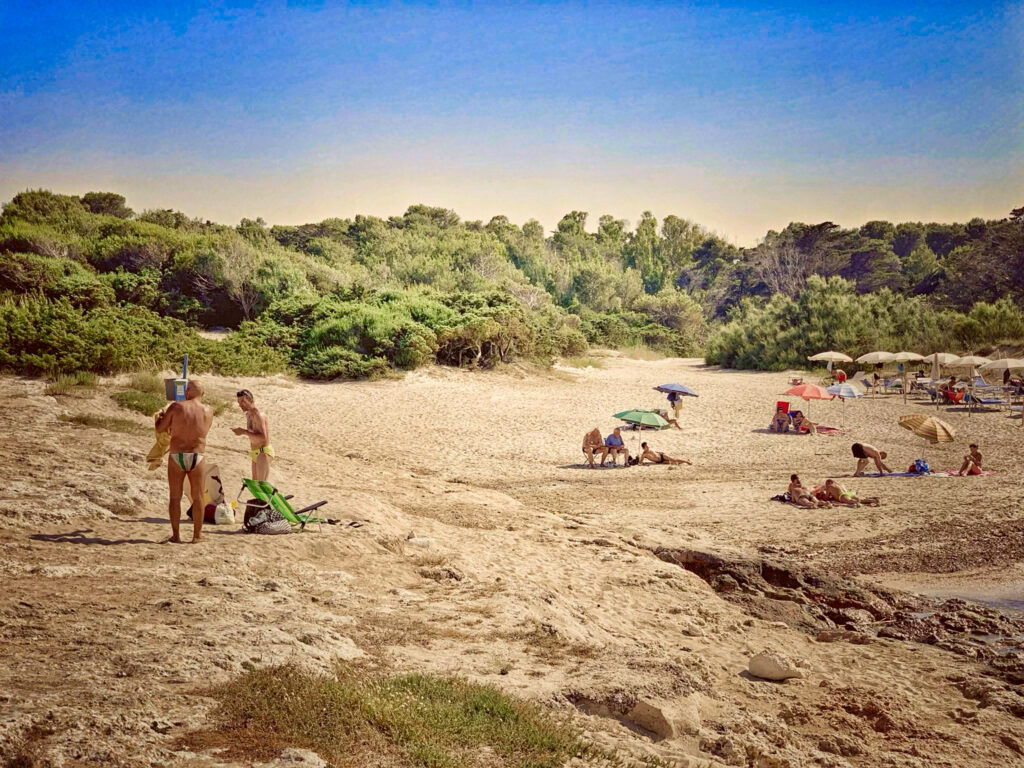
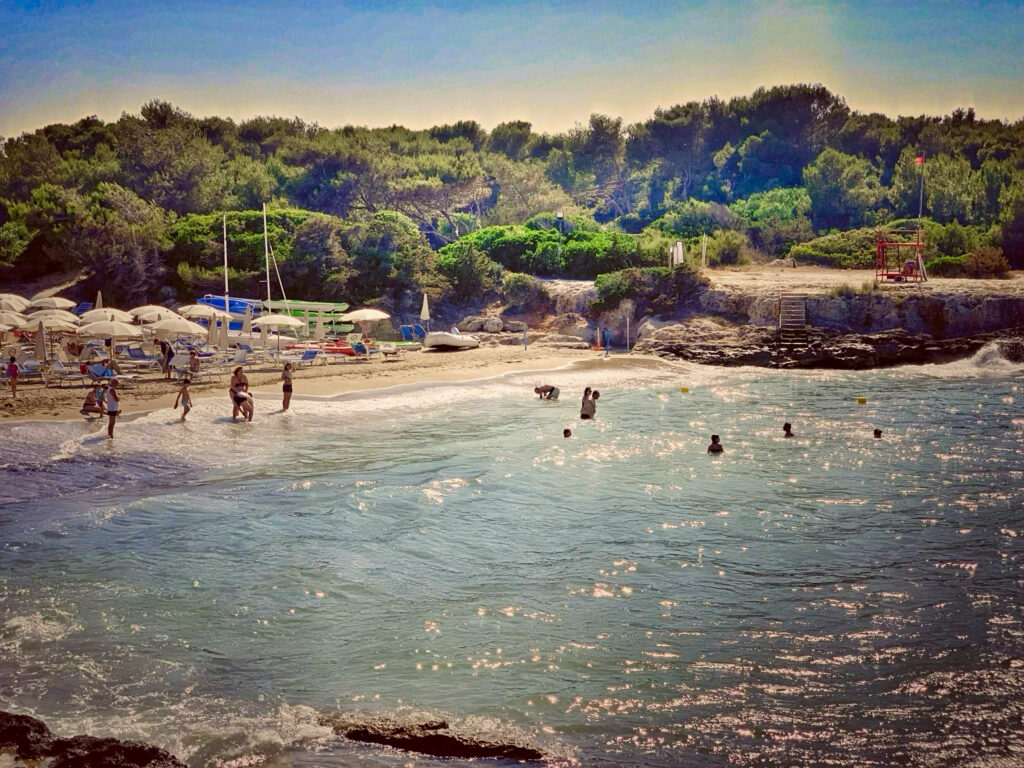
📍Spiaggia di Torre Pozzelle | 📍Spiaggia di Lamaforca, Contrada Lamaforca, Ostuni.
Specchiolla
A selection of public beaches and private lidos. Approach from the south-eastern end from the highway Specchiolla exit. Usually we can find free parking along the way, but there are pay car parks by the lidos.
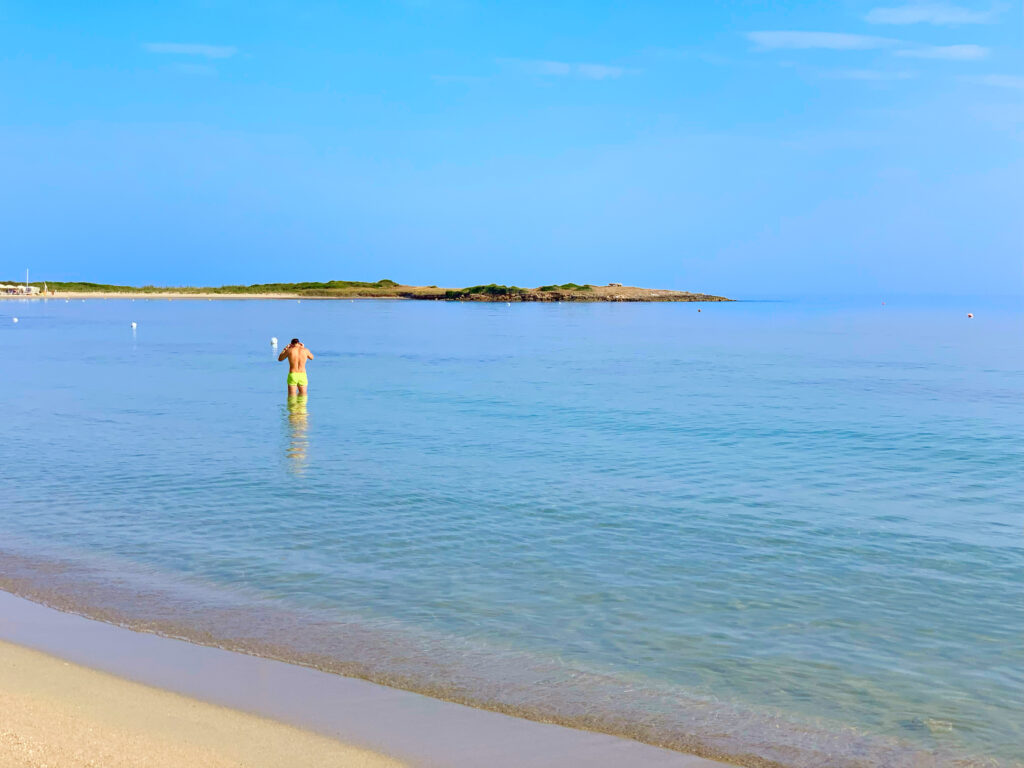
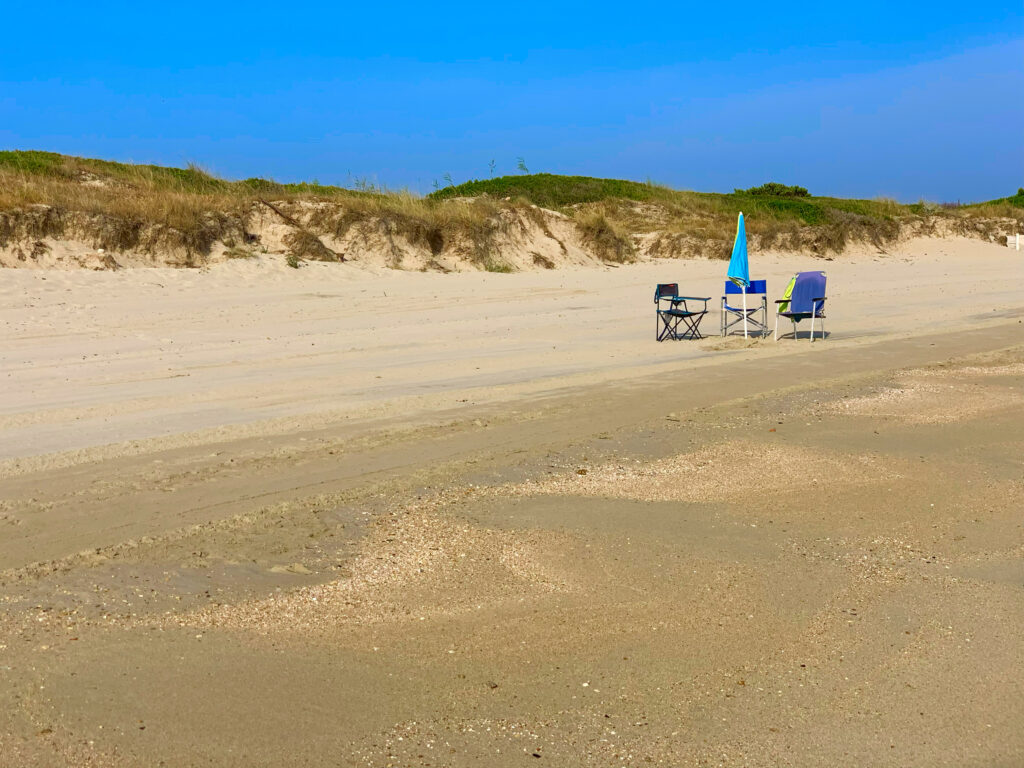
📍Specchiolla public beaches, Carovigno.
Punta Penna Grossa (Torre Guaceto)
The family friendly end of Torre Guaceto. Extremely popular, but you need to park in the not so nearby pay car park at the north entrance parking area for the Torre Guaceto nature reserve (by the Meditur Village) and take the shuttle trolly train (around 4 mins each way with waits up to 15 minutes).
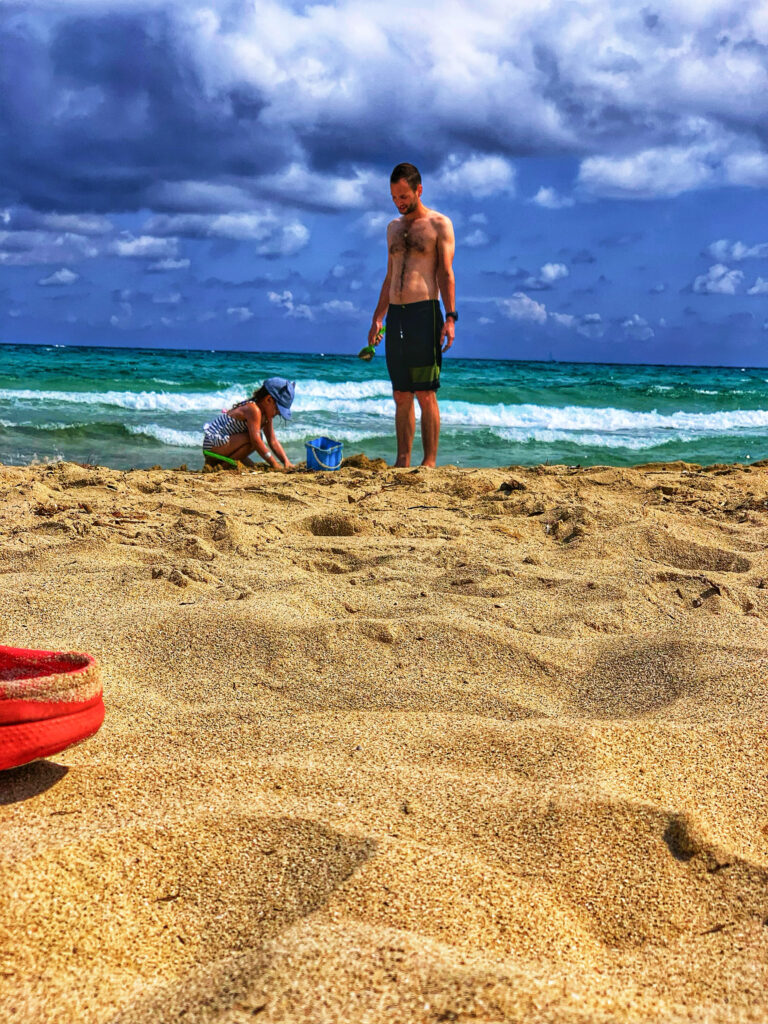
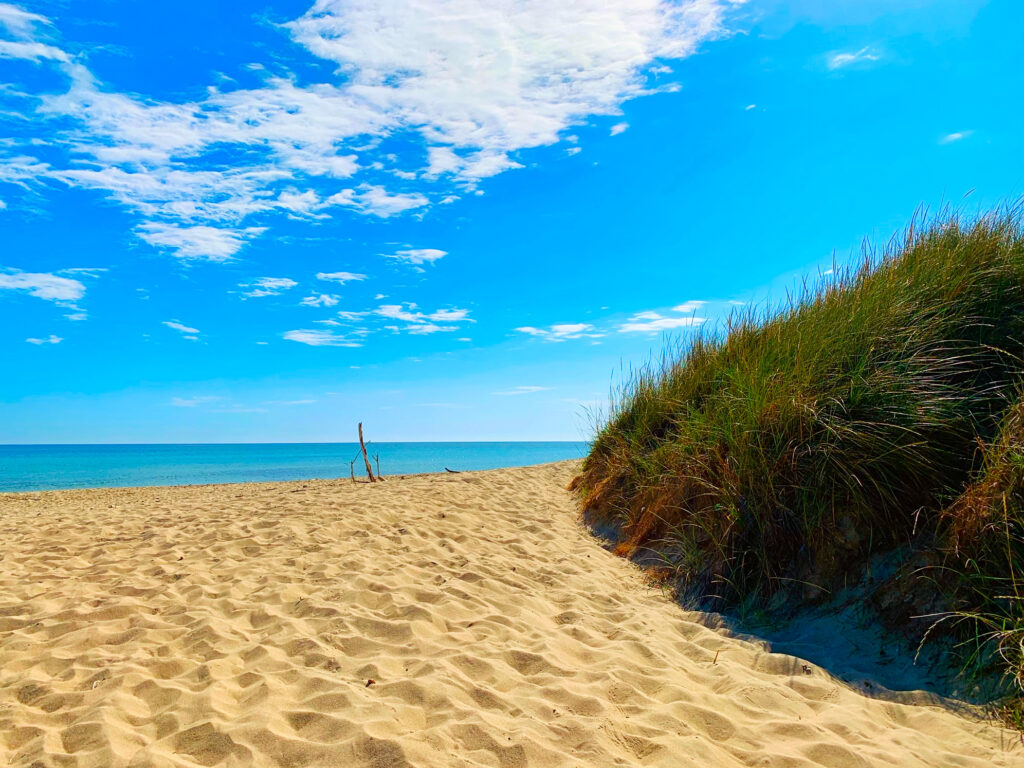
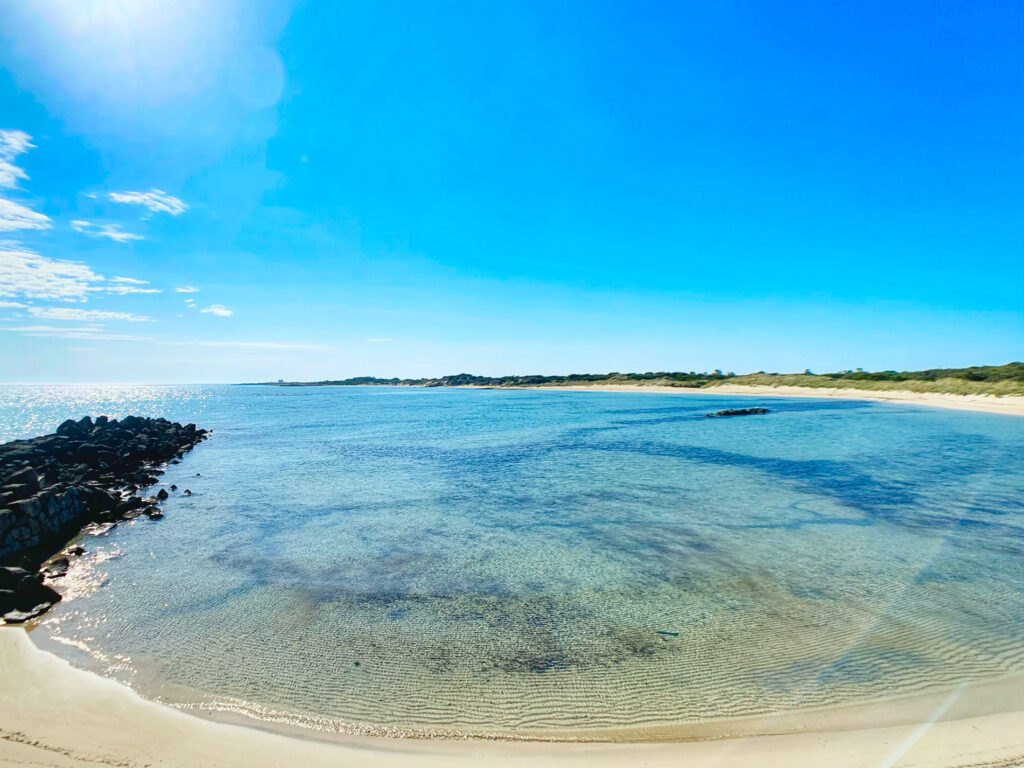
Punta Penna Grossa, Torre Guaceto.
Public Parking
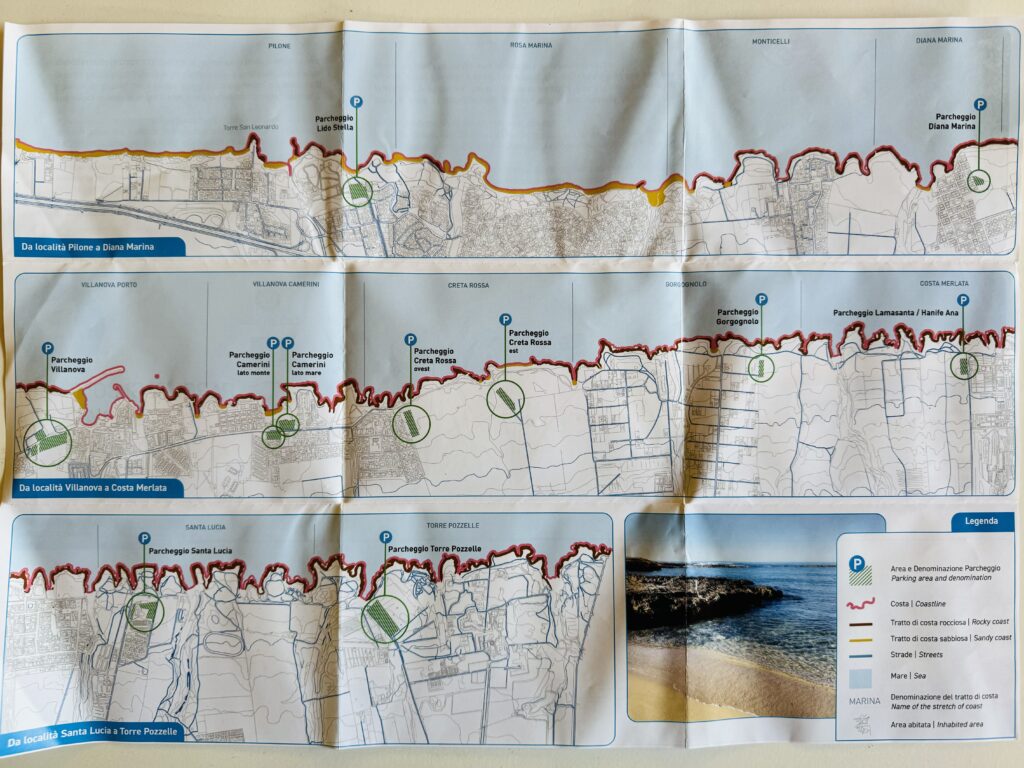
The municipality has set up free car parking spaces along the 17km stretch of coastline along Ostuni’s territory, to protect the amenity by discouraging off road parking elsewhere. Please use the car parking provided!
More beach | 50 of Puglia’s best beaches
Puglia has some of Italy’s finest coast. In 2023 it was awarded 22 bandiera blu awards for the water quality of its beaches, the most in Italy outside the Italian Riviera.
Check out our insider guide to 50 of the best beaches in Puglia.
3. Where to park | the Ostuni guide to parking
Like most Italian towns and cities, car parking in Ostuni can be a challenge. From mid-July to mid-September parking spaces are Ostuni’s most precious commodity! Either side of peak visiting we usually find a free parking space in the centre of Ostuni without a problem.
On-street parking is usually marked on the road surface. But not always. Parking is generally permitted unless no parking signs indicate that it is restricted.
Otherwise, free parking spaces are outlined in white. Watch for any adjacent signs indicating restrictions, such as maximum time limits. In these cases, display a parking disc on your dashboard indicating the arrival time. You can purchase these discs for a few euros at tobacconists or newspaper shops. Rental cars often come with them already attached to the windshield.
Blue lines indicate “pay and display” parking. Check accompanying signs for details. Payment can be made with coins, many machines accept cards, and some can be paid for using parking apps.
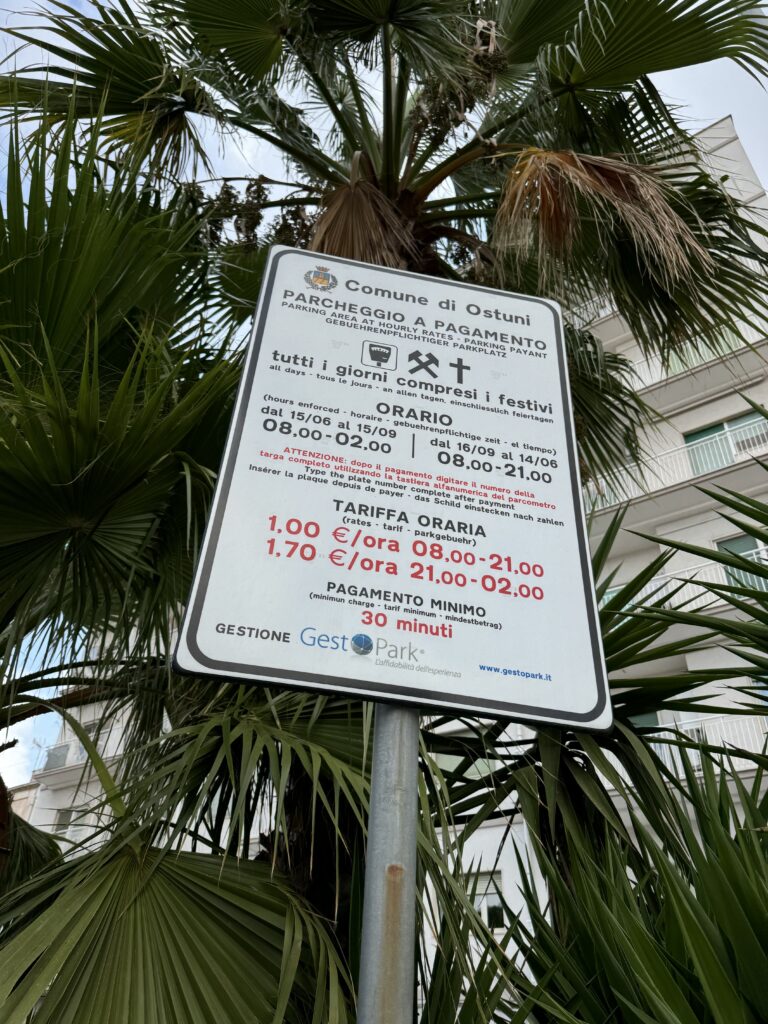
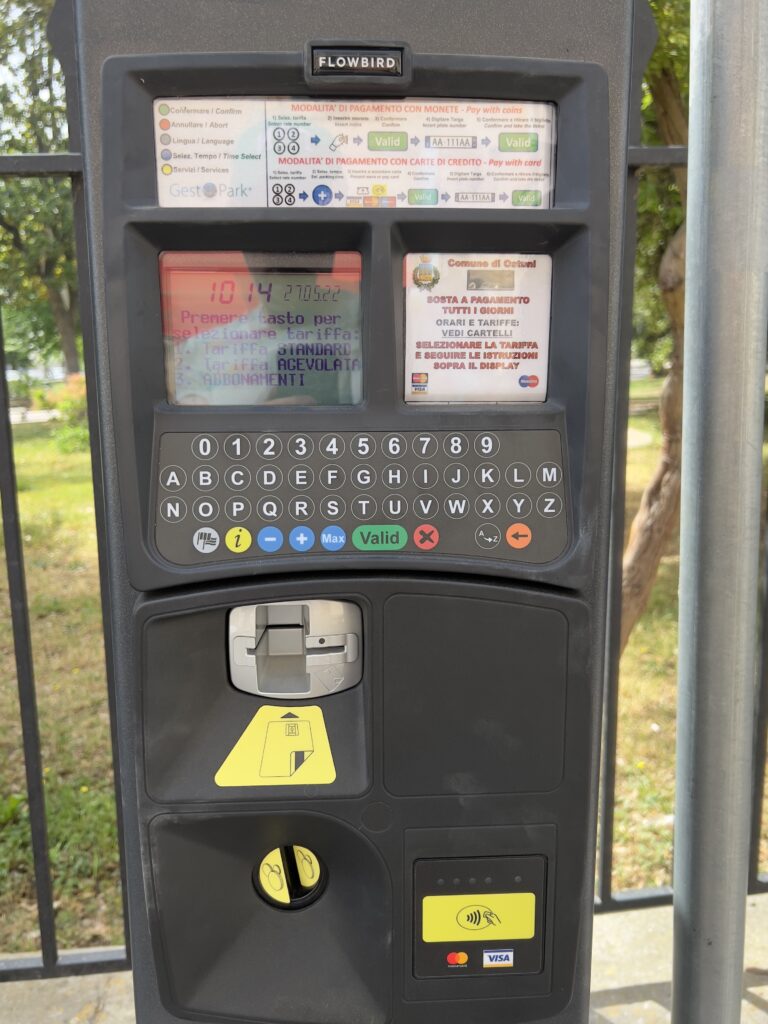
Signs specify payment hours and rates. Keep an eye on the ticket expiration time as you are feeding in your coins or adjusting the + or – when paying by card. Machines take account for free parking times in the afternoon and at night.
Most of the time you will need to input your car’s registration (license plate) number before purchasing a ticket. Look for the instruction “Digitare la targa del proprio veicolo.” Keeping a photo of your car’s registration number on your smartphone saves time (some hire car keys will have the registration number already attached). If you’ve already queued at the meter, you won’t have to join the line again.
Ensure your ticket is clearly displayed on the dashboard inside the car. The same rules apply to municipal car parks.
Yellow spaces are reserved for disabled badges, taxis, or official vehicles. You may encounter green zones with restricted parking during certain hours on working days for deliveries and similar activities.
Choosing a smaller rental car proves advantageous when it comes to parking.
Via Giosuè Pinto
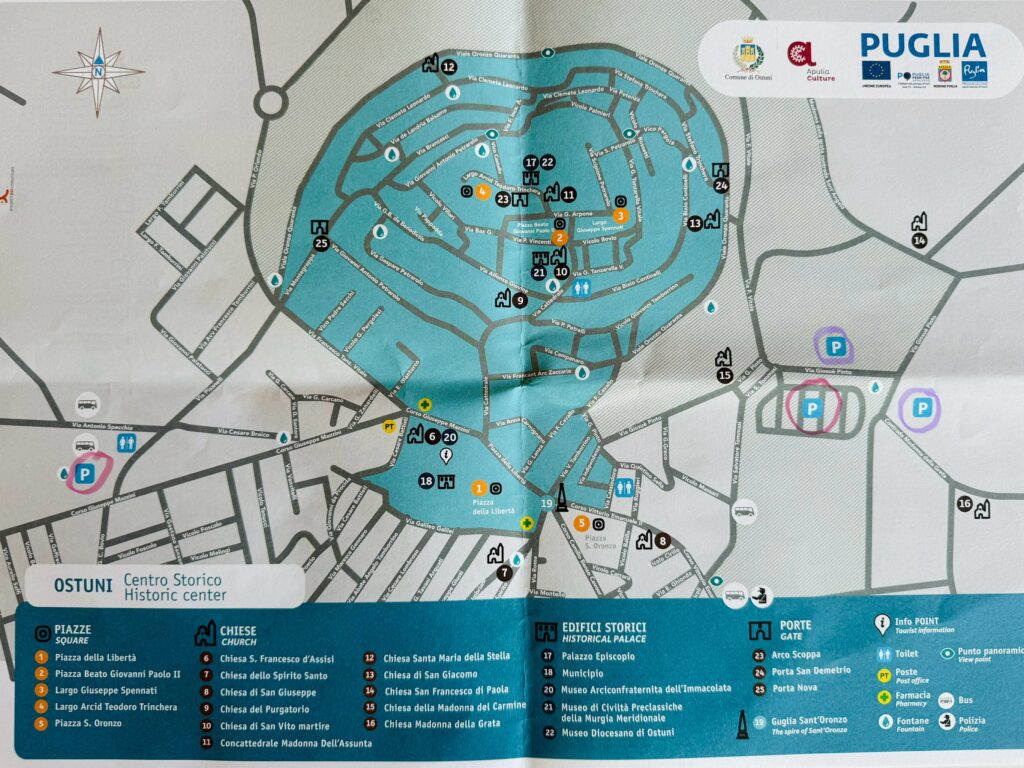
Coming into Ostuni from the Brindisi side (especially from the SP21), try parking in the municipal pay and display car park opposite the Confraternita del Carmine church between Via Salvatore Tommasi and Via Giosuè Pinto.
Insider Tip | You need to input your car registration number for your pay and display parking ticket, so if you don’t know it, have a photo of the licence plate on your phone so you don’t have to leave the queue/line to check it when it is your turn to pay.
Beware the gentleman in the high visibility waistcoat sometimes present and taking it upon himself to guide cars into spaces looking for payment. He is an opportunist and not an official. If in doubt ask the Golapa Tuk Tuk guides who line up adjacent to the car park.
A 2-minute walk, ending with the up the steps to Sant’Oronzo’s column will take you to the heart of Ostuni; the Piazza della Libertà and up to the duomo.
Ostuni parcheggio Tenente SPECCHIA
The car park at Via Antonio Specchia is useful if you are coming into Ostuni via the SS16 or SP20.
Villa Comunale | Parco Rimembranze
These car parks fill up pretty quickly in summer. Our fall back is parking around the Villa Comunale at Parco Rimembranze. On the right hand side, heading down towards piazza della Libertà, parking in the spaces delineated by white lines is free. You can also turn left into the Villa Comunale where there is a small free car park.
Along Corso A. Ayroldi and Via Martiri di Kindu it’s pay and display parking within the blue lines.
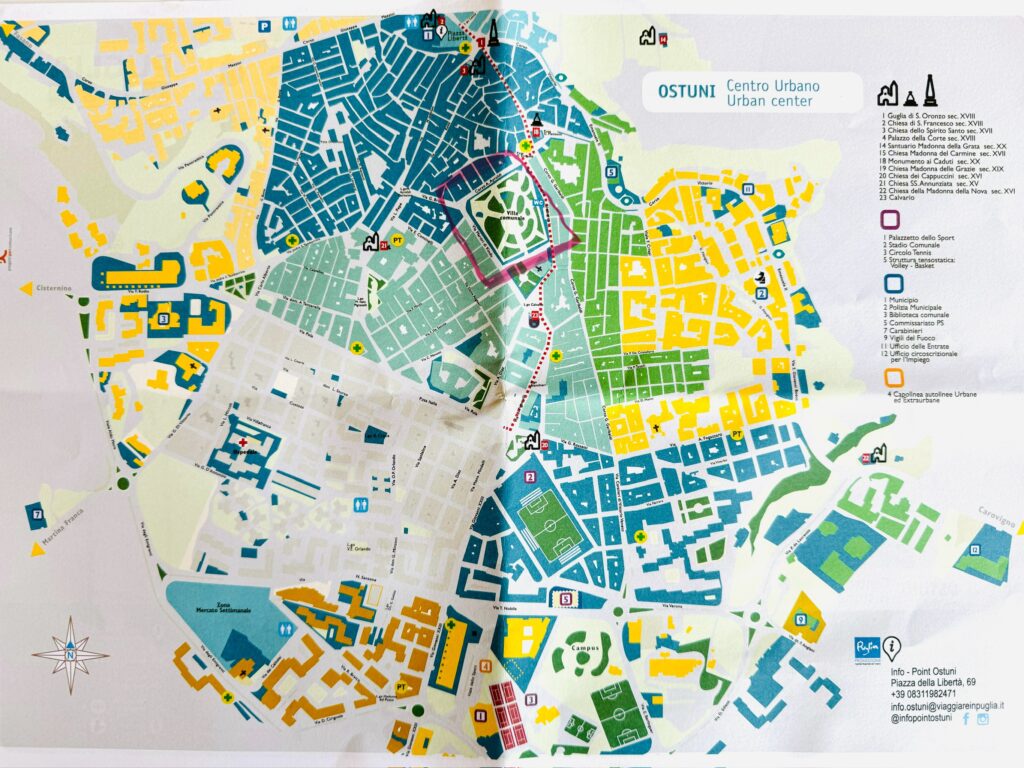
Insider Tip | the pay and display machines here require you to input your vehicle registration (license plate). If you have a hire car keep a photo of this to say you having to go back and re-join the line to pay for your ticket.
ZTL – Ostuni’s restricted traffic zone
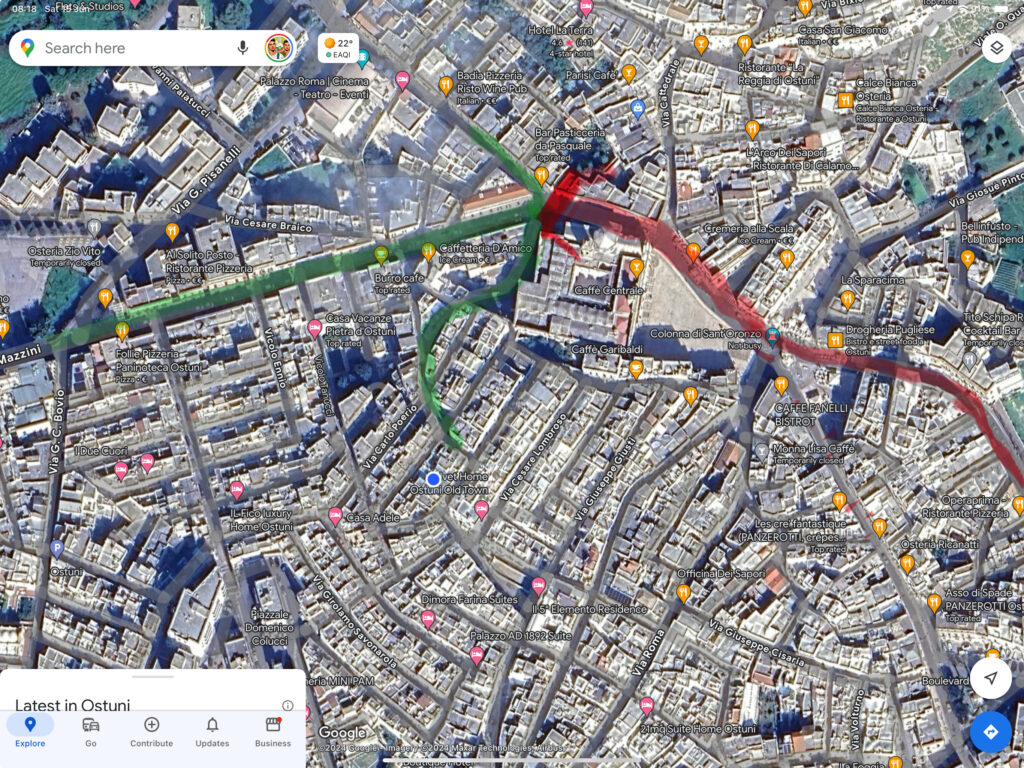
Beware Ostuni’s ZTL, zones of restricted circulation, particularly the one which runs along Corso Vittorio Emanuele II, past the Sant’Ornzo column and along the Piazza della Libertà into Corso Giuseppe Mazzini. Only the local residents and registered vehicles are authorised to drive here. These zones are therefore prohibited to outside vehicles during certain hours. Stray into it and you will get a hefty fine – and the hire car company will pass it on. Just before Easter the municipality replaced the old cameras that didn’t work with fully functioning new ones!
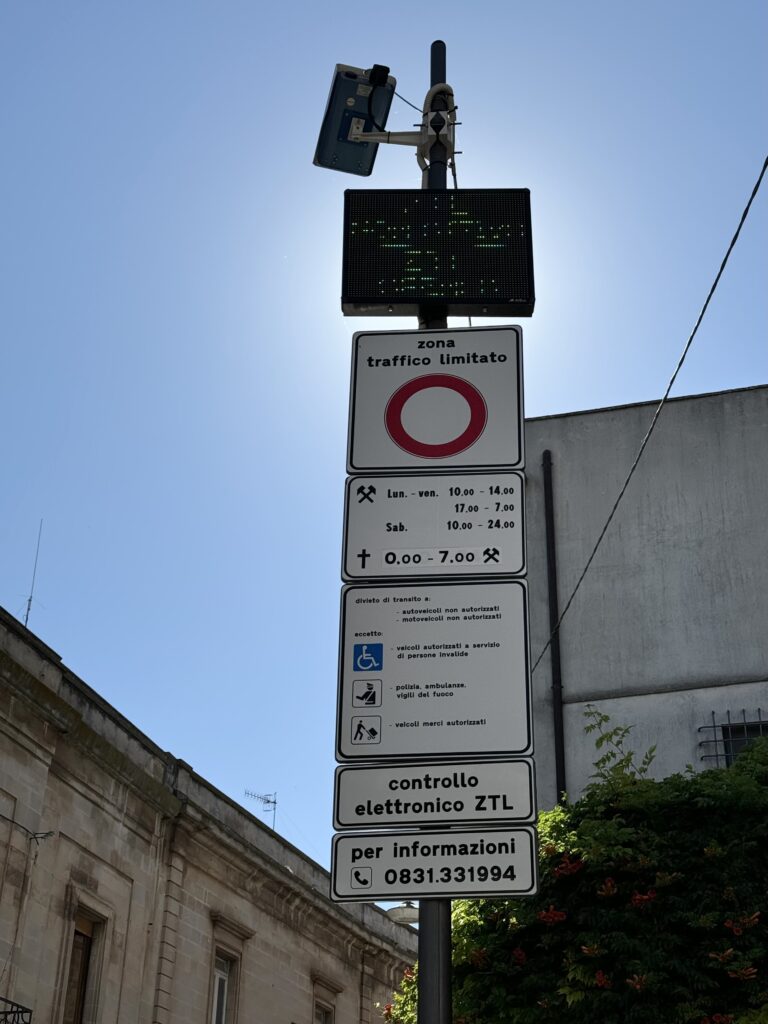
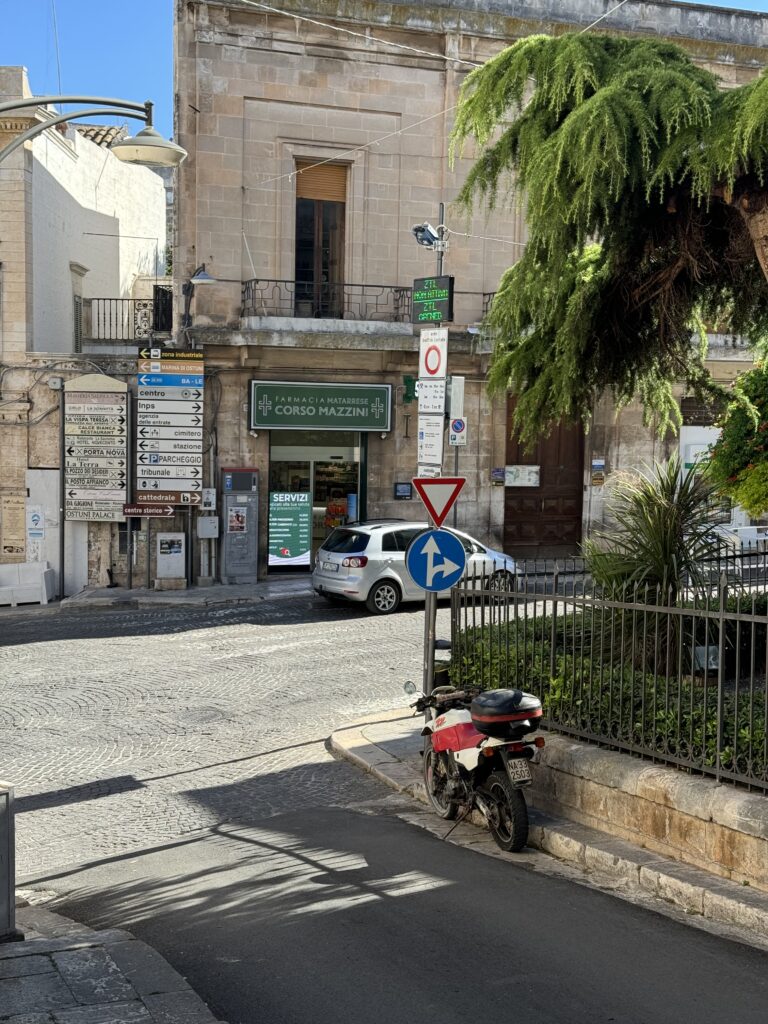
Insider Tip (mid-July to mid-September) | On street parking is easier to find after 10am when after breakfast visitors head to the beach | between 10am and 11am the AirBnB exodus takes place, but the apartment cleaners quickly snap up the spaces | before lunch and la pausa is a good time (until 12.30pm) for street parking, after that spots are full until around 4pm | visitors returning from the beach and others coming for aperitivi and dinner start filling the car parks from 5pm | if it’s raining most people will stay in town instead of heading to the beach, and parking stays challenging all day long!
4. La città bianca, Puglia’s White City | what to see and do
Ostuni | Origins
Ostuni’s oldest inhabitant can be traced back to the Middle Palaeolithic some 25,000 years ago. The skeleton of “Delia” found in the cave of San Maria di Agnano indicates the presence of Neanderthal hunters who made homes in the nearby caves.
Later settled by the Messapi around 1000 BC, the city came under the dominion of Rome until the later stages of the fall of the Roman Empire. Invasion and conquest followed and over the next 1000+ years came the Ostrogoths, the Lombards, the Normans and the Aragonese.
During the 16th century the Aragonese widened the defensive wall around the city rebuilding the Villanova Tower and constructing the Pozzella and San Leonardo towers to protect against the Turks.
Tyranny reigned for almost 150 years under Duke Giovanni Zevallos, to whom Ostuni was sold in 1679, and his descendants. Calm was only restored under the Bourbons who rose to power after Napoleon’s defeat at Waterloo.
Following Italian unification under Garibaldi, Ostuni became part of Garibaldi’s Italian nation state.
A plague on all your houses
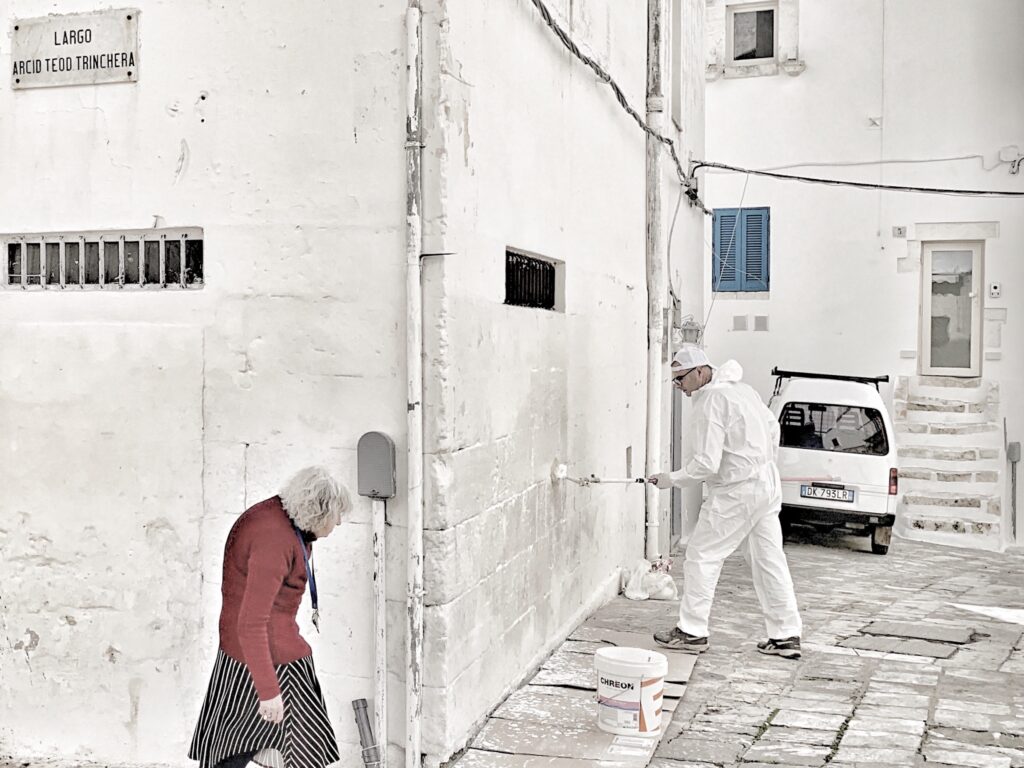
Lime washing the town’s houses – a practice believed to have originated as a defence against the plague in the 17th century – is still carried out annually, lightening up the centro storico’s maze of dark medieval streets and stairways.
Hints of the Middle Ages still lie around each corner of the old town’s cobble streets but what most visitors see today dates from between the 1400s and the 1700s and has survived three major earthquakes
Loose yourself in its nooks and crannies as you explore the tangle of narrow streets and stairways of the centro storico. Ostuni is an easy sightseeing visit as all the favourite sight seeing spots are within very close proximity. But the city is built on three hills, so you will be walking uphill and downhill most of the time.
Cross the Piazza della Libertà (main town square), with the baroque obelisk of Sant’ Oronzo (la colonna), the saviour of Ostuni; stop for a spritz at Caffè Fanelli on the smaller side of the piazza before taking the Via Cattedrale up into the old town to the duomo, Ostuni’s cathedral, that sits at the highest point looking down at the rest of us!
We wouldn’t stop to buy olive oil or wine on the Via Cattedrale – it’s overpriced of course.
After the duomo, pass under the Arco Scoppa, the ornate pedestrian bridge between the buildings, originally in wood.
Enjoy an ice-cream from the gelateria a little beyond the arch, before turning the corner to enjoy the panoramic view from the east, out to sea, taking in the acres and acres of silver green olive groves (try to blank out the ugly industrial buildings spoiling the view, beyond which is the train station).
Don’t forget to take a selfie at La Porta Blu. These days it seems to be a more popular selfie stop than the adjacent view of the olive groves.
Go down the steps, keeping right, and up some more, to find your way around the edge of the old town and back to the via Cattedrale. Alternatively keeping left will take you around the Aragonese wall.
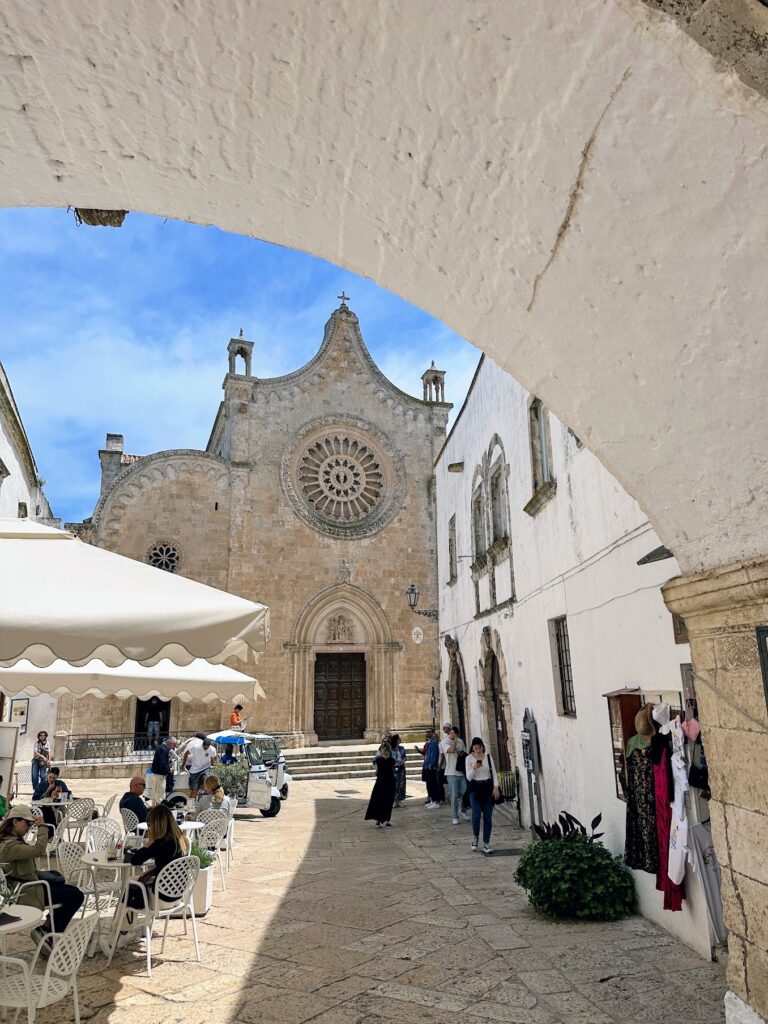
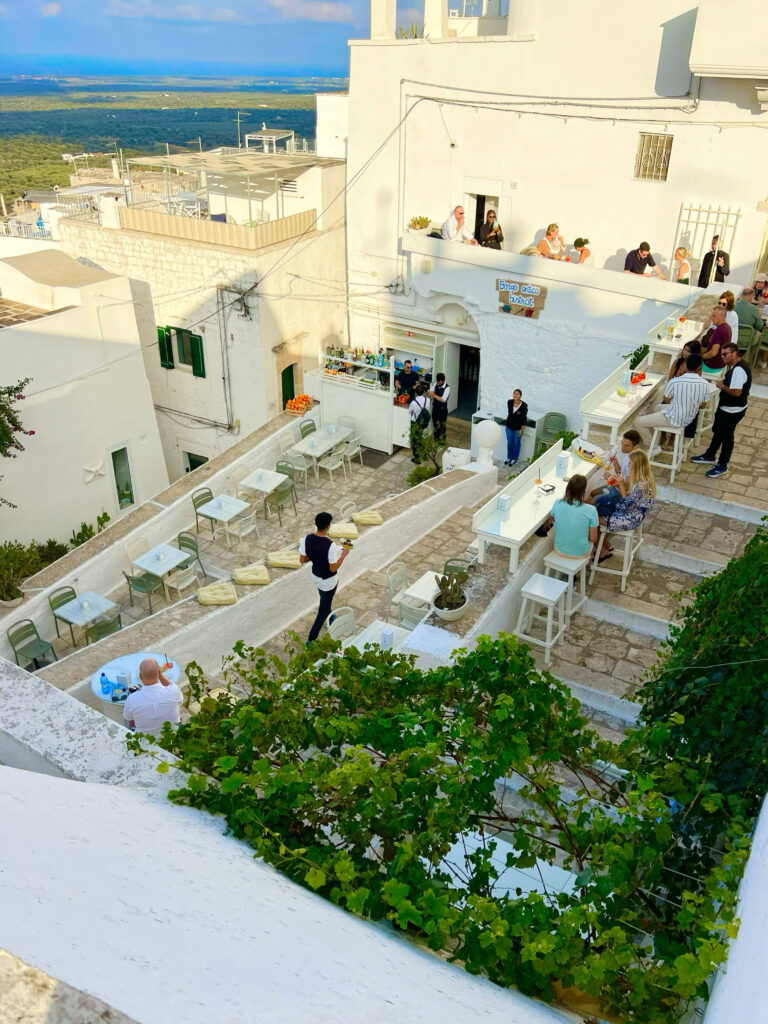
Piazza della Libertà
The piazza is a large open space on which, in addition to the café bars and restaurants sits Palazzo San Francesco, an ancient Franciscan monastery, and now the Town Hall. Standing next to it is the Church of San Francesco d’Assisi.
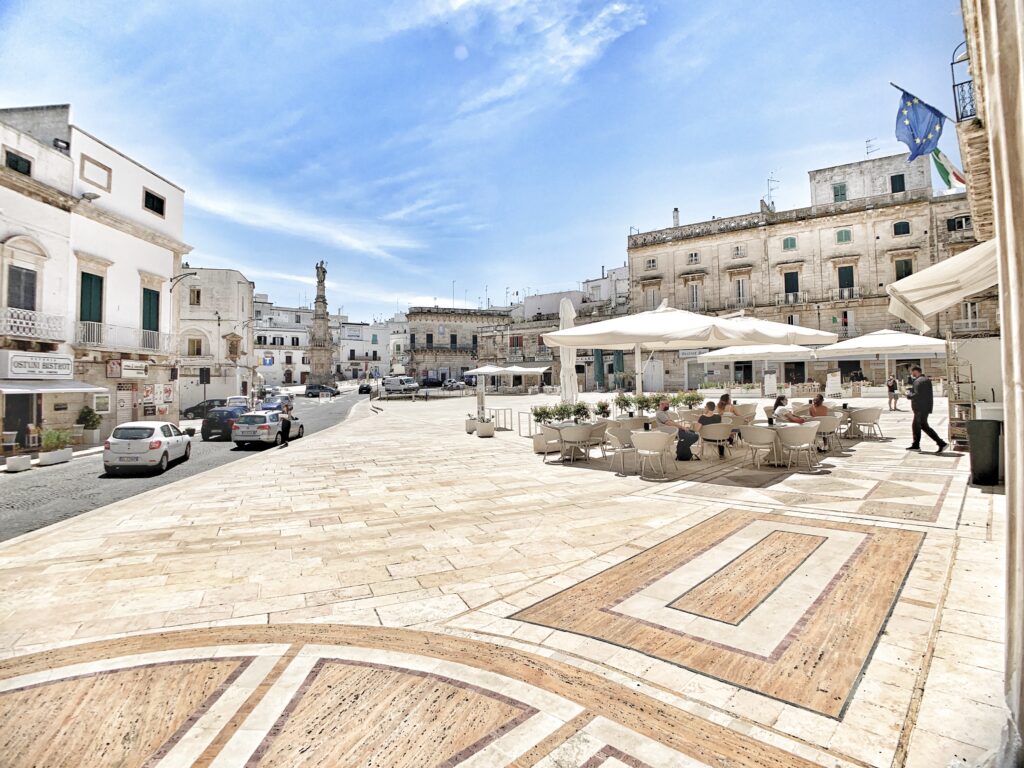
Chiesa di San Francesco d’Assisi
Originally built in the 14th century built in the fourteenth century the church was restored after being severely damaged by the 1743 earthquake.
Sant’Oronzo’s Column
The column was built in 1743 and is a tribute to Sant’Oronzo the saviour and holy bishop of the city of Ostuni. It stands 19.5 meters high and marks the spot where the Valle d’Itria ends and Alto Salento begins, one half of the column sits on each side.
If in doubt, the column is the perfect meeting point if you are new to Ostuni. It’s an obvious landmark, central and perfect for orienting yourself.

Concattedrale di Santa Maria Assunta
Perched atop the highest of Ostuni’s three hills, the cathedral dominates Largo Trinchera, a square renowned for its harmonious Baroque urban design. Surrounded by the bishop’s palace and the seminary—linked by an elegant suspended passage dating back to 1750—the cathedral’s commanding presence marks it as a cultural and spiritual landmark.
A Legacy of Transformation
The original cathedral has long vanished, with its present structure attributed to extensive reconstruction initiated under Giovanni Antonio Orsini Del Balzo, a noble of the Taranto principality. Between 1437 and 1470, Bishop Nicola Arpone oversaw the cathedral’s transformation into a Late Gothic masterpiece. The architect, Giovanni Lombardo, together with skilled local artisans, crafted the structure from Ostuni’s characteristic native stone.
The cathedral’s façade is divided into three vertical sections, each embellished with pointed portals and intricate niches. The crowning feature is a distinctive curved central gable, which reflects Venetian and Dalmatian influences reinterpreted through Ostuni’s unique artistic lens.
The Magnificent Rose Window
One of the most remarkable aspects of the façade is its elaborate rose window. Composed of concentric rings, it radiates outward with 24 meticulously carved rays and 12 inner sections. At its heart, a central depiction of God the Creator is surrounded by prophets and angelic figures. The intricate sculptural details, featuring floral and fauna motifs, symbolise the eternal passage of both sacred and earthly time.
A Fusion of Artistic Styles
Inside, the cathedral follows a Latin cross layout with three naves, supported by columns adorned with Neoclassical capitals. Over the centuries, renovations have introduced Renaissance and Baroque elements, particularly under Bishop Francesco Antonio Scoppa in the mid-18th century. His modifications included elaborate stucco decorations, a new floor, and a painted wooden ceiling adorned with 18th-century biblical-themed canvases.
Treasures of Religious Art
The cathedral boasts an impressive collection of religious artwork. The centrepiece of Ostuni’s religious tradition is the silver statue of St. Orontius, crafted by Neapolitan silversmith Luca Baccaro in 1794. This revered figure is paraded annually through the town during the Cavalcata, a key event in Ostuni’s patronal festival each August.
Among the cathedral’s prized artefacts is an 18th-century marble baptismal font, crafted by Neapolitan artisans. The chapels house exquisite works of art, including the Chapel of the Sacred Heart of Jesus, featuring an elaborate wooden altar by Giuseppe Morgese of Bari. The painting Madonna and Child with Saints Gaetano and Philip Neri, attributed to Domenico Antonio Vaccaro, graces the Petrarolo family chapel, while the Chapel of the Immaculate Conception, built in 1857, contains papier-mâché sculptures by Lecce-based artist Raffaele Carretta.
The Right Transept and Beyond
Since 1566, the right transept has been home to the Confraternity of the Trinity, featuring a matching altar adorned with an image of the Madonna della Sanità. A surviving 16th-century fresco depicting St. Catherine of Alexandria adds to the historical richness of the space. The Chapel of the Blessed Sacrament, originally dedicated to St. Philomena, contains mannequin statues of the Holy Family dressed in 19th-century garments.
The Left Transept and Additional Chapels
The left transept is equally significant, housing busts of St. Blaise, St. Orontius, and St. Augustine, with a gilded altar adorned by a painting of St. Orontius. Further along, the Calcagni family chapel features the Presentation of Mary in the Temple with Saints Charles Borromeo and Francis, attributed to Antonio Vassillacchi. The final chapel, dedicated to St. Anthony, showcases an 18th-century painting of the Virgin and Child with St. Anthony.
Arco Scopa
Built to connect the bishop’s palace to the seminary, the original was made of wood. This was replaced by the stone bridge that now exists. Either because the wooden structure was unsound, or according to popular history, because of the wear and tear of overuse due to nighttime visits by the bishop to the seminary on the other side.
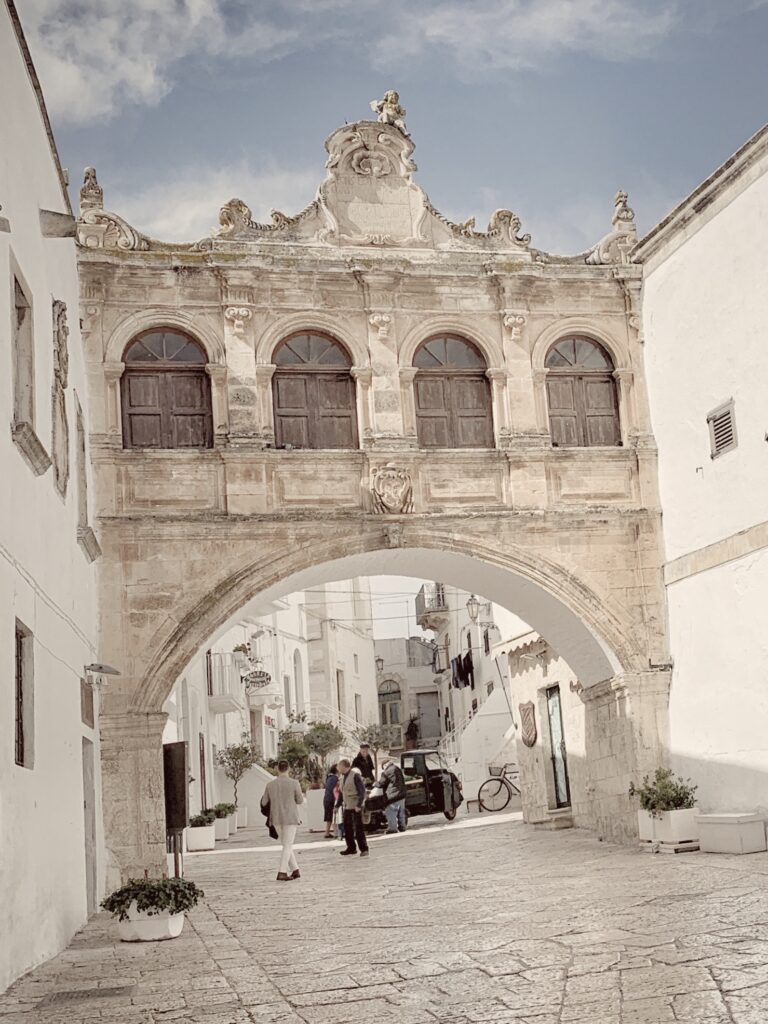
Heaven’s Door | La Porta Blu
No Ostuni guide would be complete without mentioning Puglia’s most famous door and certainly Ostuni’s most popular selfie stop. Some believe paradise lies behind the door, opening onto a vista of blue sky, green olive groves and the azure blue of the Adriatic beyond (giving it its other name – Heaven’s Door). It is in fact a B&B (we visited in September 2023).
Be sure to give it a “ Knock-knock-knockin’ on heaven’s door” for good luck on your visit.
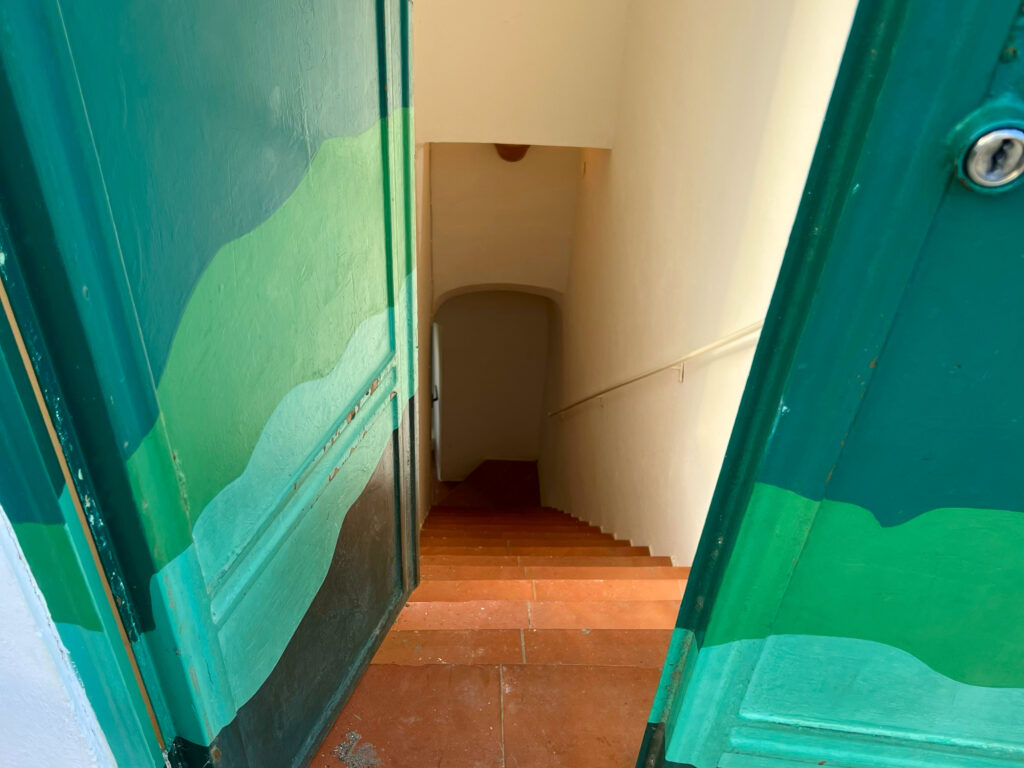
Mura aragonesi
The defensive walls around Ostuni date back to the Middle Ages and have been modified and added to over time. Extending from Porta Nova to Palazzo Scalona, it was the city’s third defensive wall built, to defend the lands from various invasion attempts by the Agarenese, Saracens and pirates.
The towers and bulwarks were erected in 1480. In 1500 the structure was restored and strengthened to allowed the construction of dwellings above it.
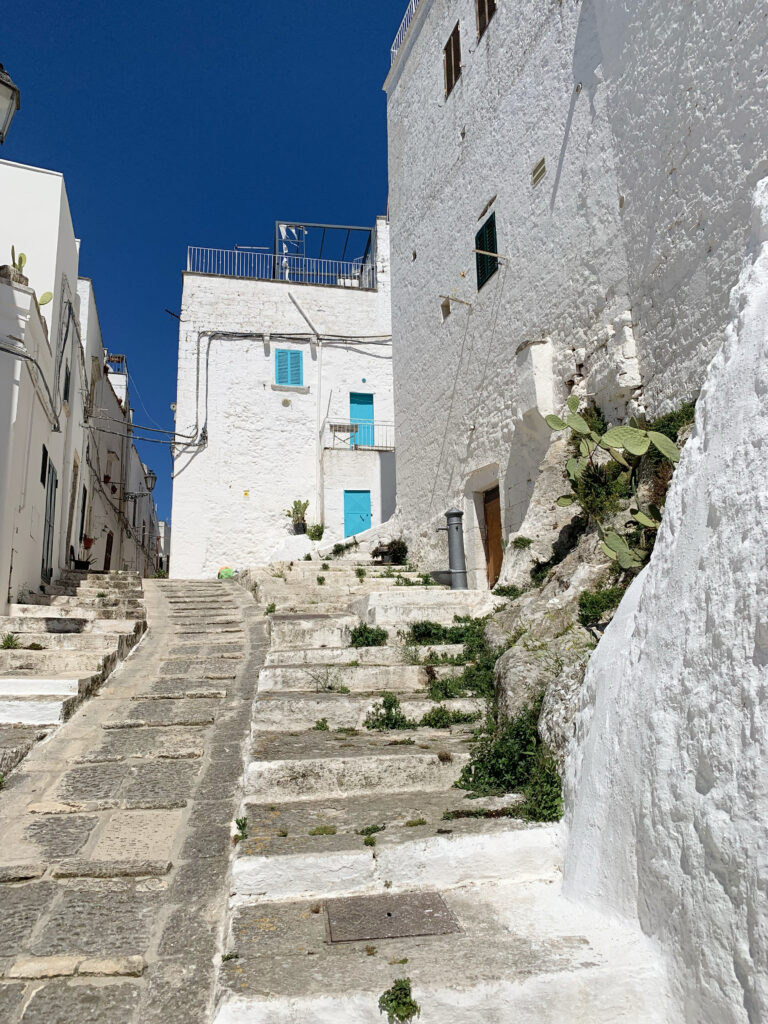
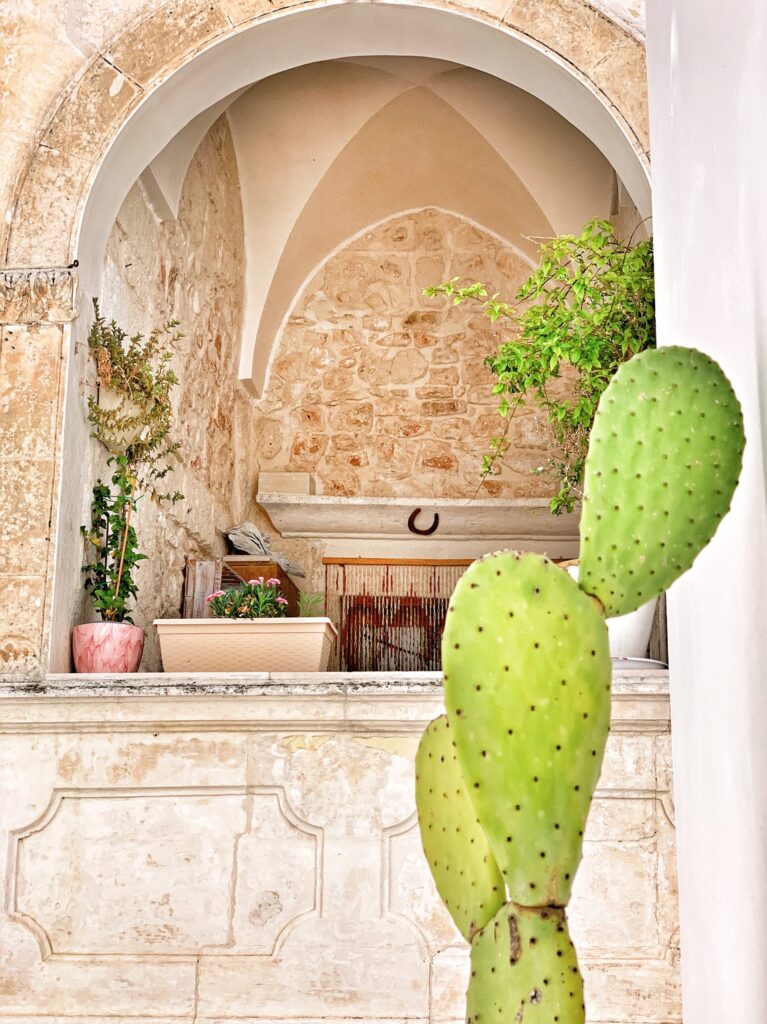
5. Where to stay in Ostuni | the Ostuni guide to selected accommodation
Ostuni has accommodation to suit all budgets. The most popular accommodation is in and around the old town, but be aware that the old town itself is within a ZTL restricted traffic zone. All our choices are central, outside the restricted traffic zone and with public street parking available on a first come first serve basis.
Other considerations: your apartment should have some outside space, especially if you are visiting in summer. Terraces and panoramic views are a bonus!
Private rental apartment | Apartment Q40 Ostuni
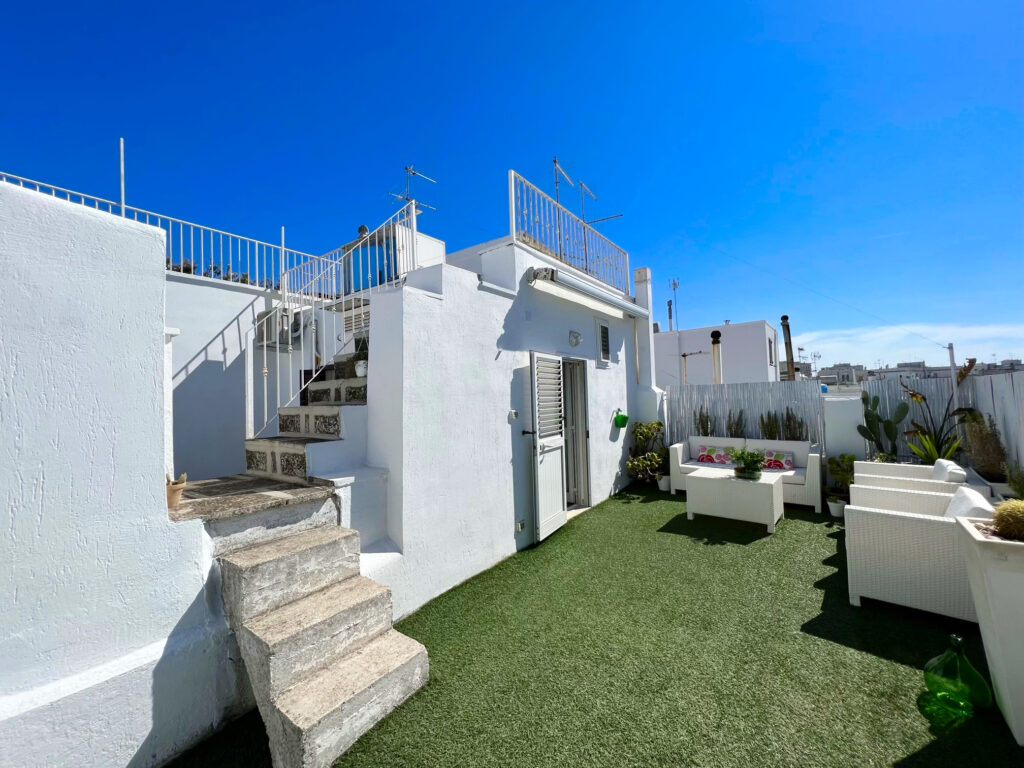
One of Ostuni’s most popular and highly recommended apartments, located just behind Piazza della Libertà (Ostuni’s main piazza with bars and restaurants). Apartment Q40 has three terraces, including an upper terrace with a panoramic view over Ostuni’s old town, across the olive groves and out to the Adriatic Sea.

Book Apartment Q40 on Booking.com.
Bed and Breakfast accommodation | Welcome Ostuni B&B
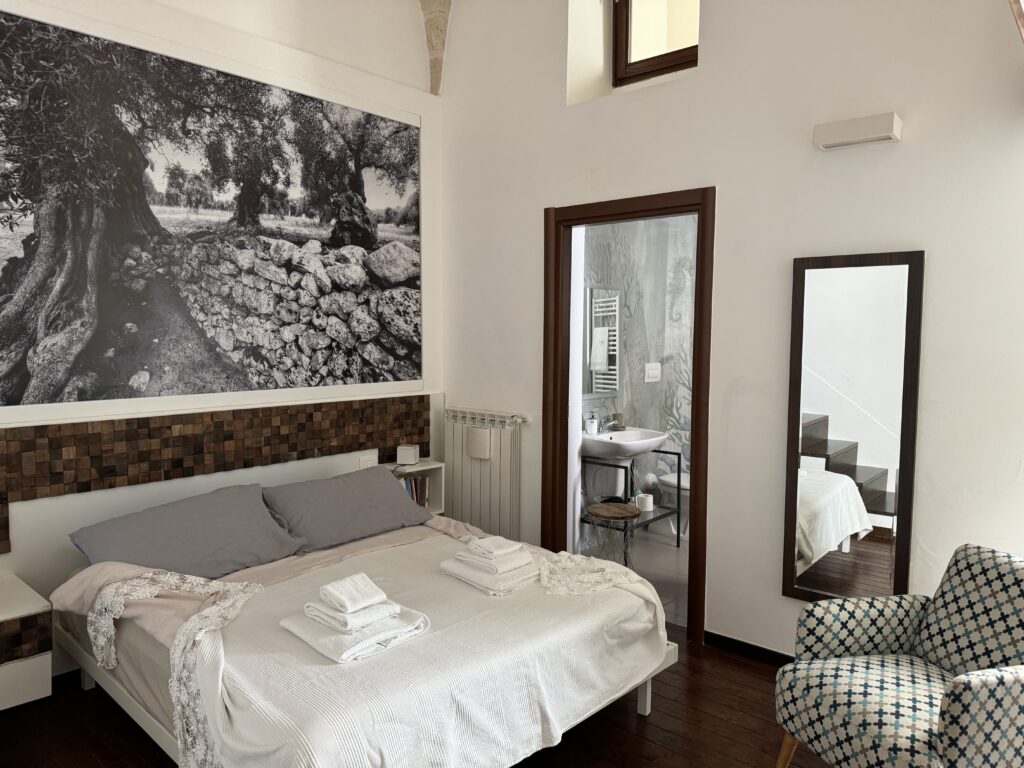
Modern, minimalist and centrally located B&B with a range of amenities, including fresh cooked breakfast, kitchenette, a small but well-equipped gymnasium, and a terrace.
Apartment complex | The 5 Elemento Residence
Large sixteenth-century mansion is now a completely renovated building, capable of accommodating up to 49 guests in 15 apartments, with common access and reception areas.
Boutique hotel | Paragon700
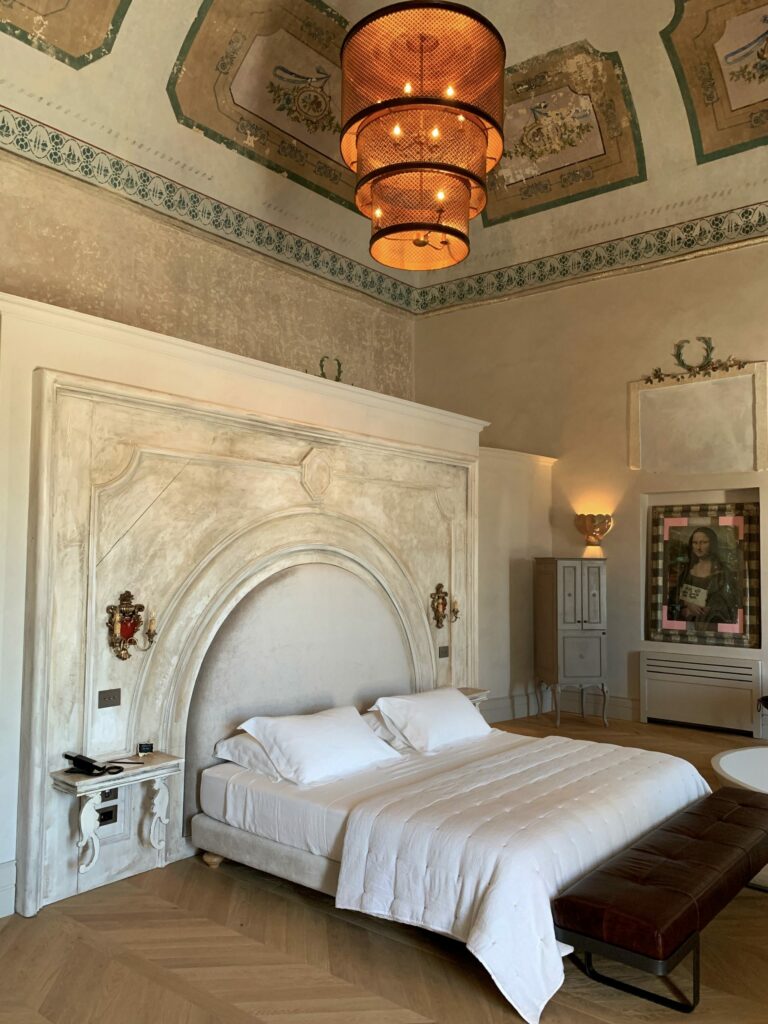
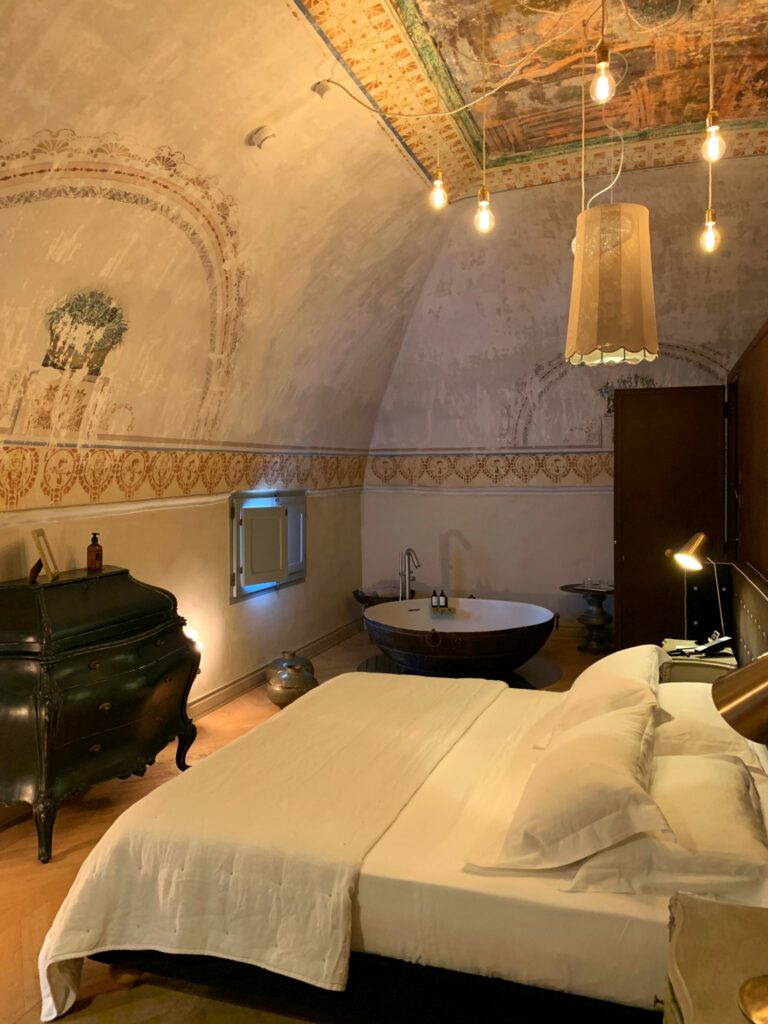
Luxury boutique hotel in resorted palazzo, renovated in an eclectic style. Large garden with orangerie, bar and swimming pool.
6. Ostuni Guide | The best time to visit Ostuni
We joke that in Puglia we only have two seasons: summer, and not-summer! Fortunately the ‘summer’ season is a long one. It starts in spring for Easter, and lasts through until the end of October.
April is usually pleasant. We still have shorter days and so less sun, but when the sun shines it’s perfect to sit on the piazza to people watch. May and June are relatively quieter than the later summer months, a good time to visit. Ostuni is at its most vibrant over summer when visitors swell the city’s population from around 32,000 to 200,000 at peak. The busiest months are August and September. A parking space becomes Ostuni’s most precious commodity!
From the end of October until the start of Easter, many bars and restaurants in and around the old town stay closed. During this period options for eating out – especially during the daytime – will be very limited. Although February is carnevale time, many of the bars and restaurants that are for local residents take an annual holiday, sometimes up to two weeks. After Ash Wednesday February can be particularly fallow month.
We usually don’t recommend visiting from November – March. We have already mentioned that in and around the old town there are fewer restaurants and bars open. It becomes a less interesting place to be. But also the weather is typically cold and damp. Many visitors think that because we are in the south of Italy we enjoy a much more temperate winter. When the sun shines, it still feels glorious and we can sit outside. But we have shorter days and less sun. As soon as it disappears so does its warmth.
We have a humid winter. The humidity means that even at temperatures between 6° – 11° it can chill to the bone.
These are the rainiest months. Ostuni is best enjoyed outside, from the terraces and balconies of private rented apartments to the piazza and outside eating and drinking. When you can’t do this because of the rain or penetrating damp cold, visiting Ostuni is a less pleasurable experience.
7. Aperitivo time | the best value Aperol Spritz on Ostuni’s main piazza
Ranging from 5,50€ to 15€, be careful where you choose to sit for your Aperol Spritz on Ostuni’s main piazza! Around the square Italy’s favourite aperitivo is served with a small ‘tris’ – a selection of 3+ small bowls from the following: olives, crisps (US chips), taralli, savoury crackers and peanuts.
Prices as at August 2024.
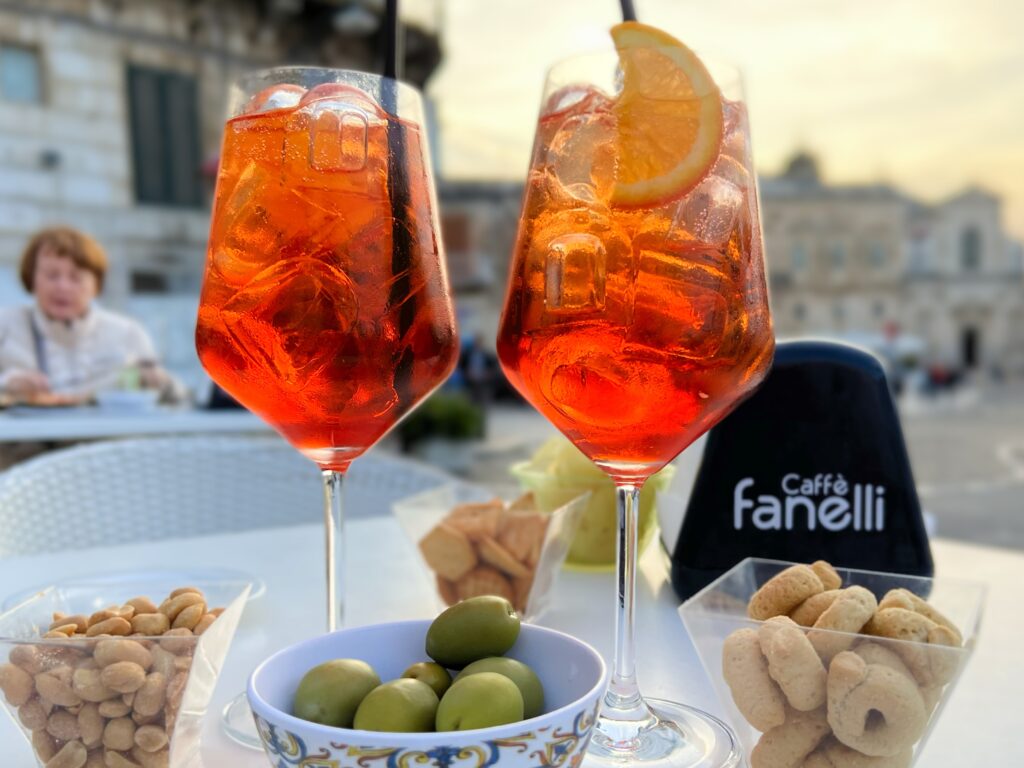
8. Ostuni guide | Day trip planning and road trips from Ostuni
Ostini is perfectly positioned as a base to explore the Valle d’Itria and beyond. From Ostuni Cisternino, Locorotondo, Alberobello, Monopoli and Polignano a Mare are all within easy distance, as also Lecce and some of Salento’s best beaches.
Check out the Puglia Guys itinerary guide to plan your schedule from an Ostuni base.
9. Ostuni guide | Adding value to your Ostuni vacation
Experience a local pizzica night, in-villa home cooking, and ‘stray’ local to avoid overly touristy areas, for a slower pace of life that is typically Puglian.
10. Eating in | Ostuni guide to food and wine shopping
Delicatessen and supermarket
For small scale shopping, try the charming and friendly Chjanga de L’ora Bottega & Bistrot, run by Kattia. It is newly opened. They have a small selection of fresh fruit and veg, some wines and other essentials. They also have a small deli counter for cold cuts, cheese and bread. They also have hot and cold food to go. They can make a delicious panino, fresh to order (choose your meats, and filling). They also offer hot food, pasta to take away. In the morning they have a selection of breakfast pastries.
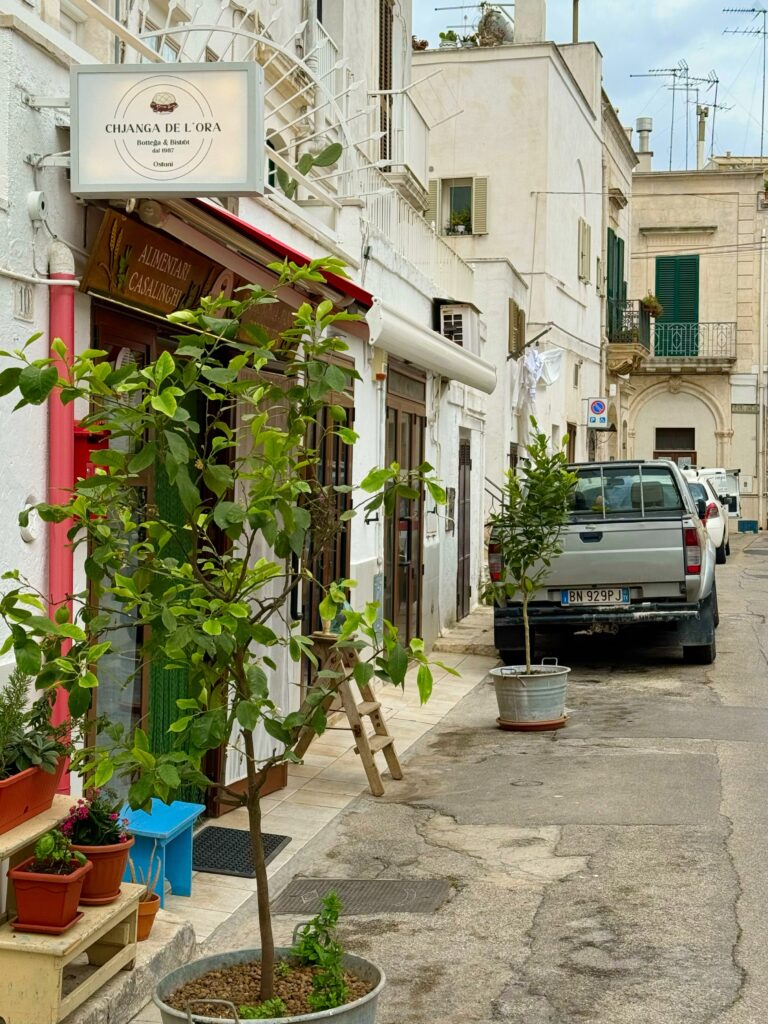
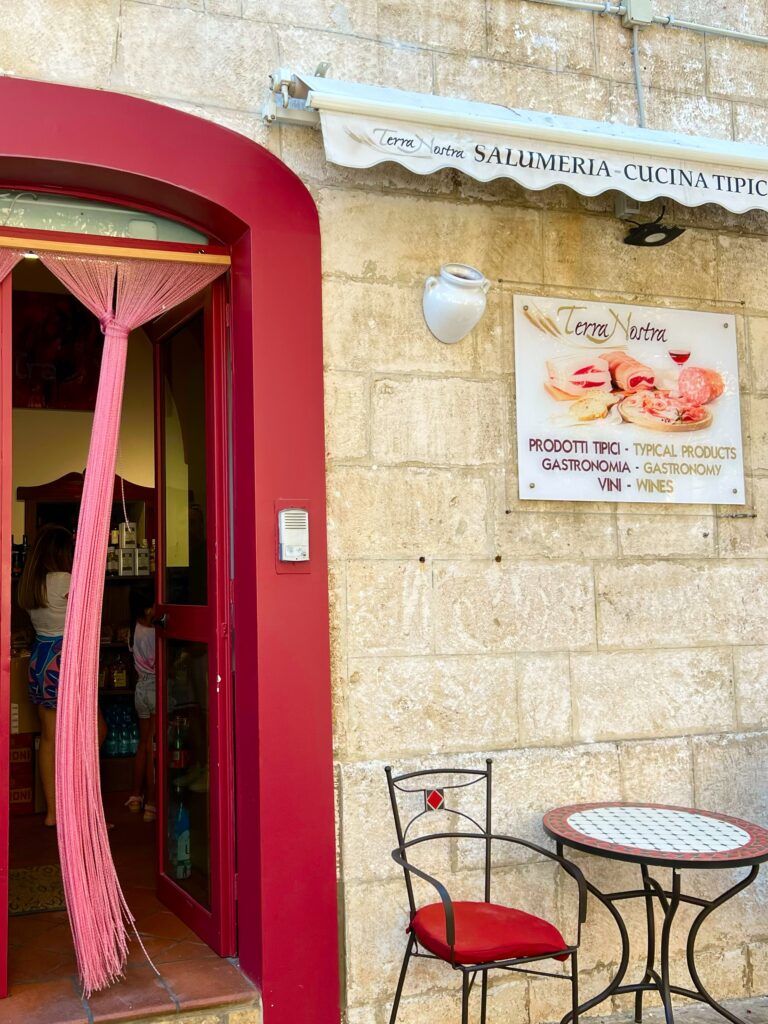
Along Corso Giuseppe Mazzini you will find Terra Nostra Salumeria e asporto Ostuni in similar style.
A local Despar mini market grocery store is located at Via Armando Diaz, 17 just a 10-minute walk from Piazza della Libertà. Usually open between 08.00 – 13.30 and 17.00 – 21.00 (Sunday 08.30 -14.00).
If you want to stock up on food we recommend supermercato Famila, Via Pietro de Laurentis (on the main Ostuni ringroad). This is Ostuni’s largest supermarket, and a favourite with locals and summer visitors. They have great fresh fruit and vegetable, bread, cheese, fish and meat counters, as well as regular supermarket goods. They stay open during the afternoon.
Forno 31 is a fantastic nearby baker, perfect (especially in the morning) for fresh baked bread, focaccia and other daily oven baked treats. Vicolo G. Ferrari, 6.
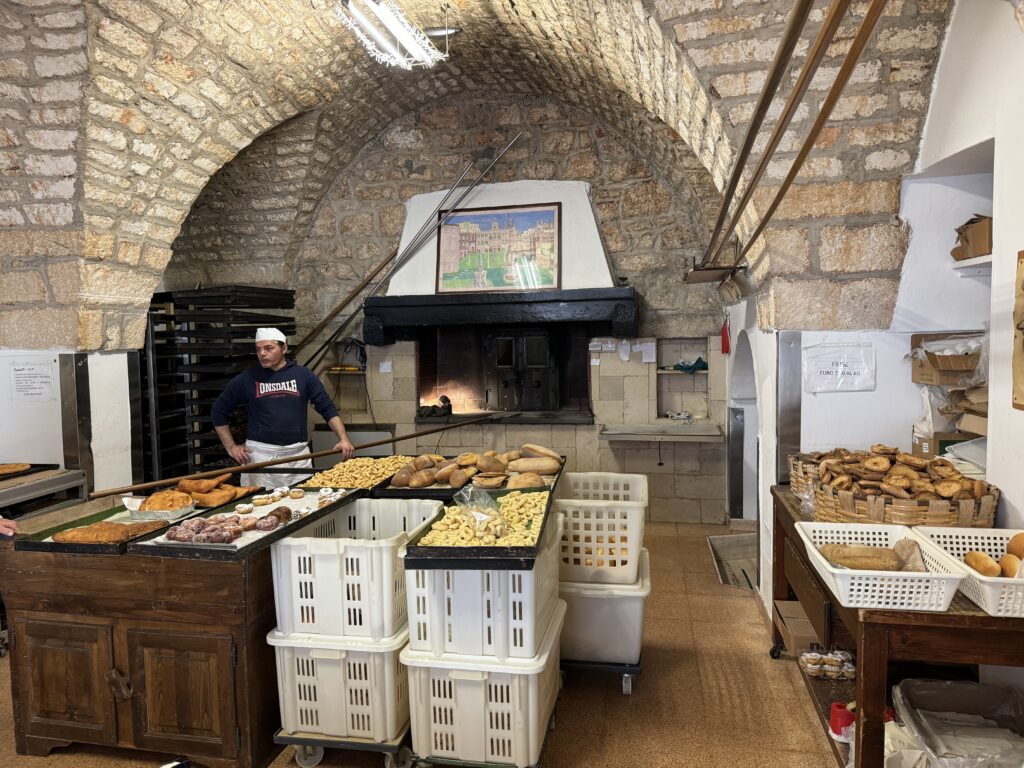
Wine
An exceptional range of Puglia wines at reasonable prices can be found at Enoteca Vini di Puglia wine store adjacent to the Famila supermarket. It’s where we shop for almost all our wines. They are closed during the afternoon pausa. Because they only stock wines from Puglia they don’t have Prosecco. Moinetto bio suits us well (around 9€). You will need to get this from Famila.
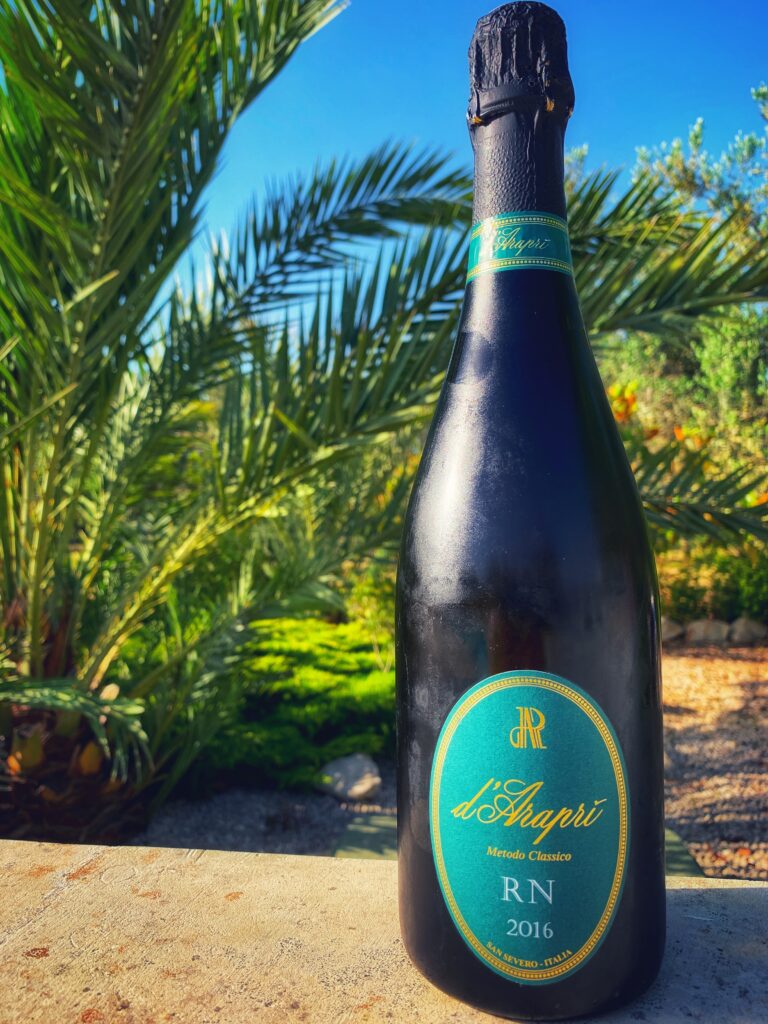
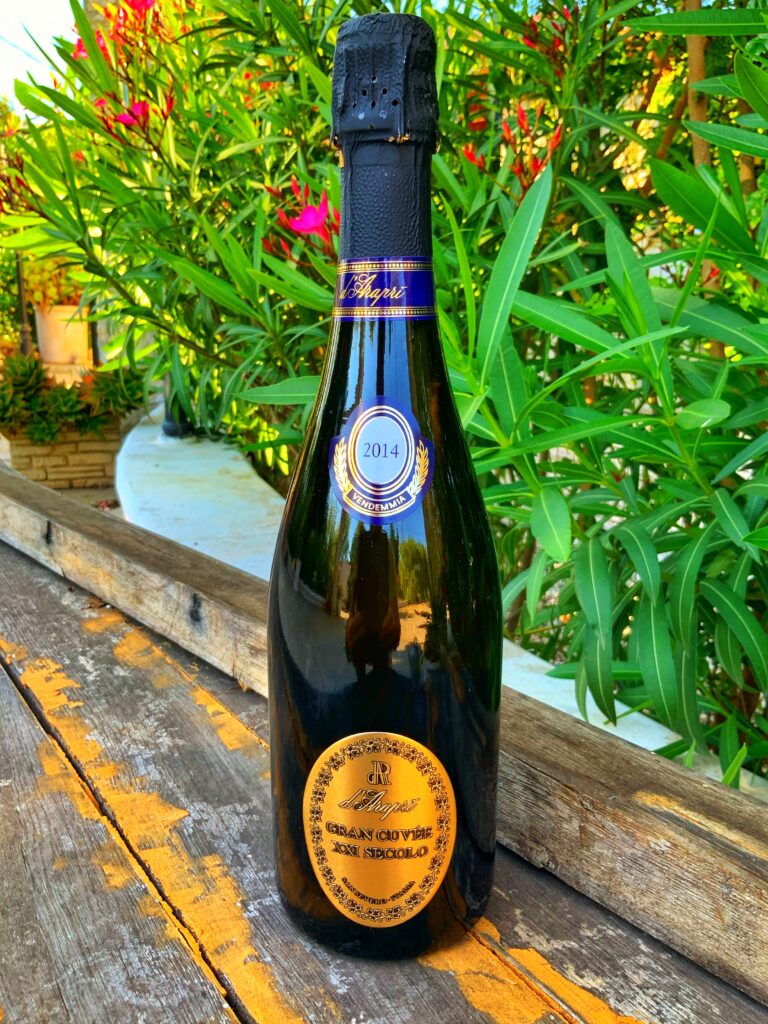
However we recommend d’Arapri spumante from San Severo in Gargano (around 18€). On special occasions we but the Gran Cuvée (28€).
Other wines we regularly buy from there include:
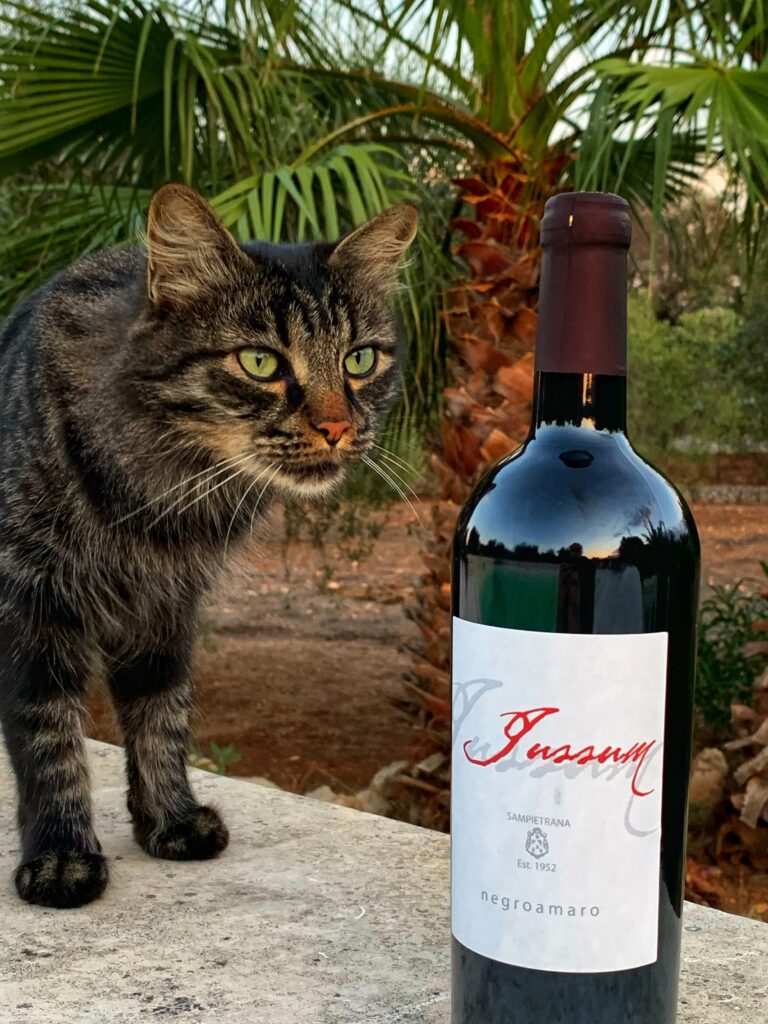
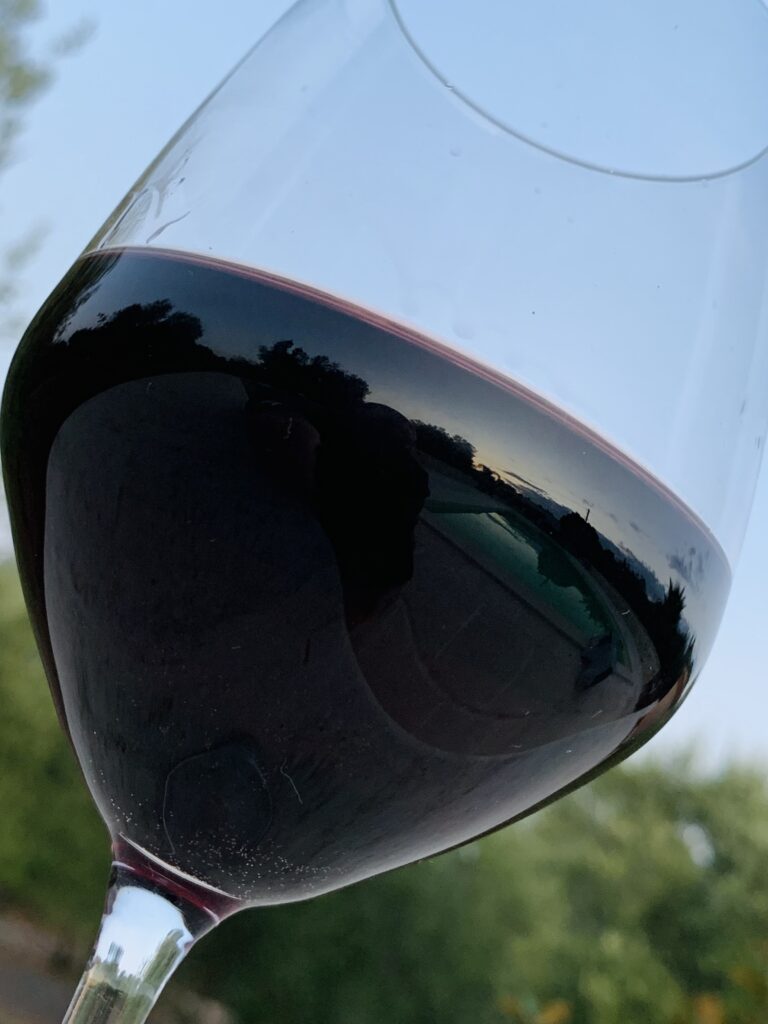
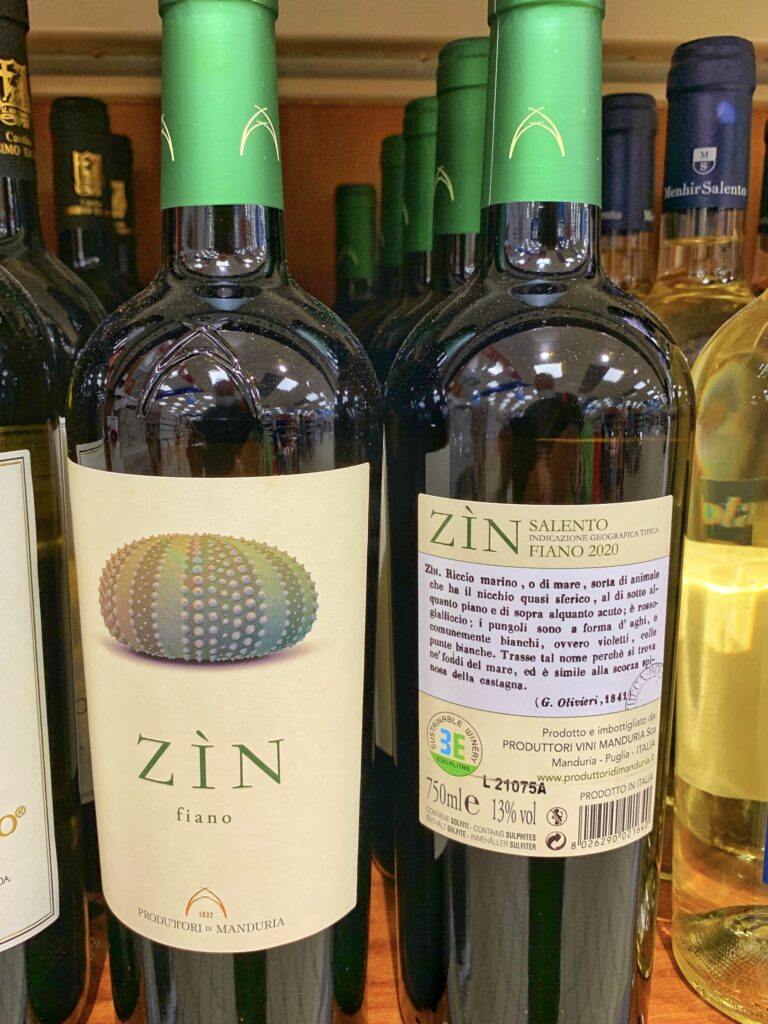
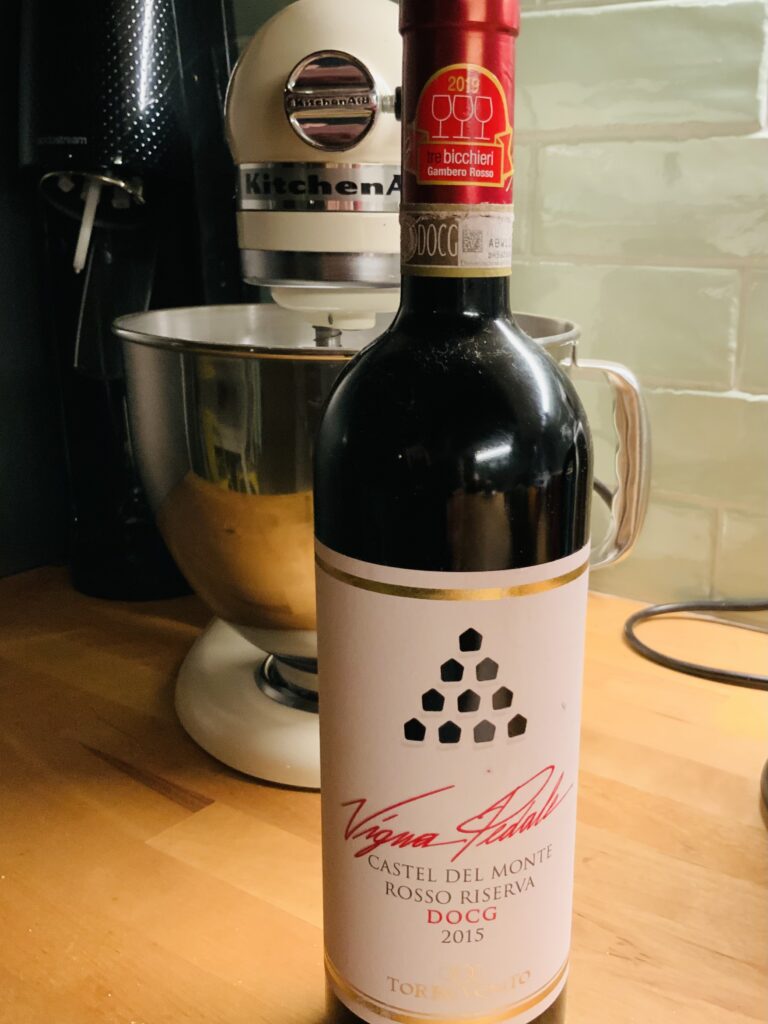
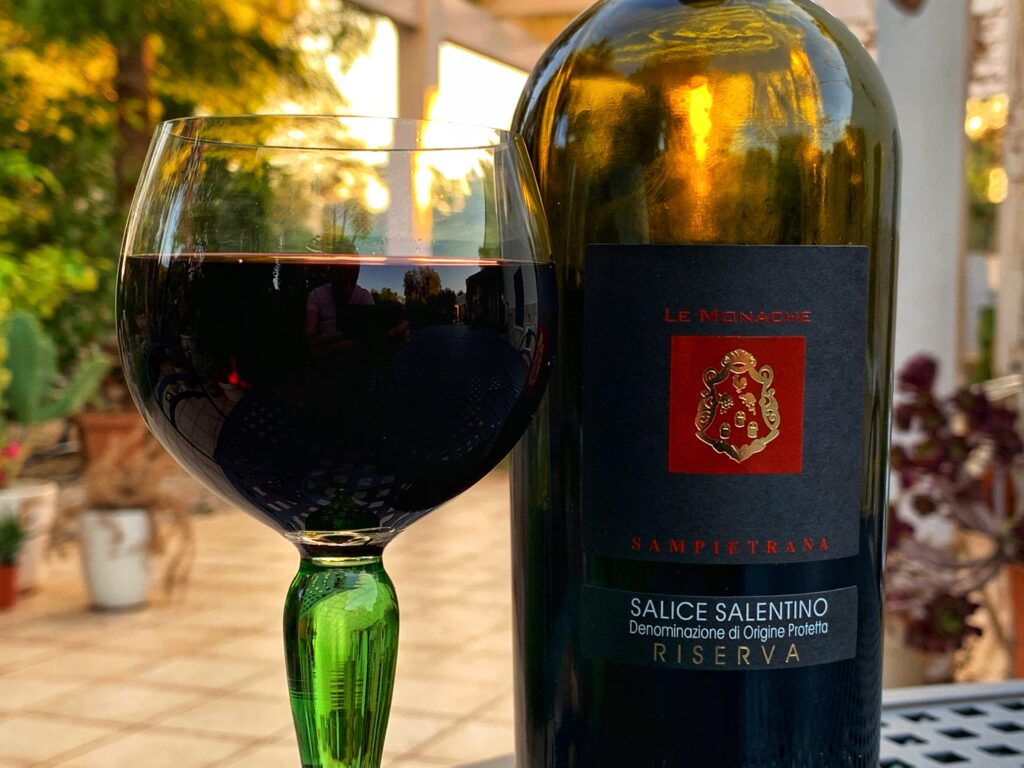
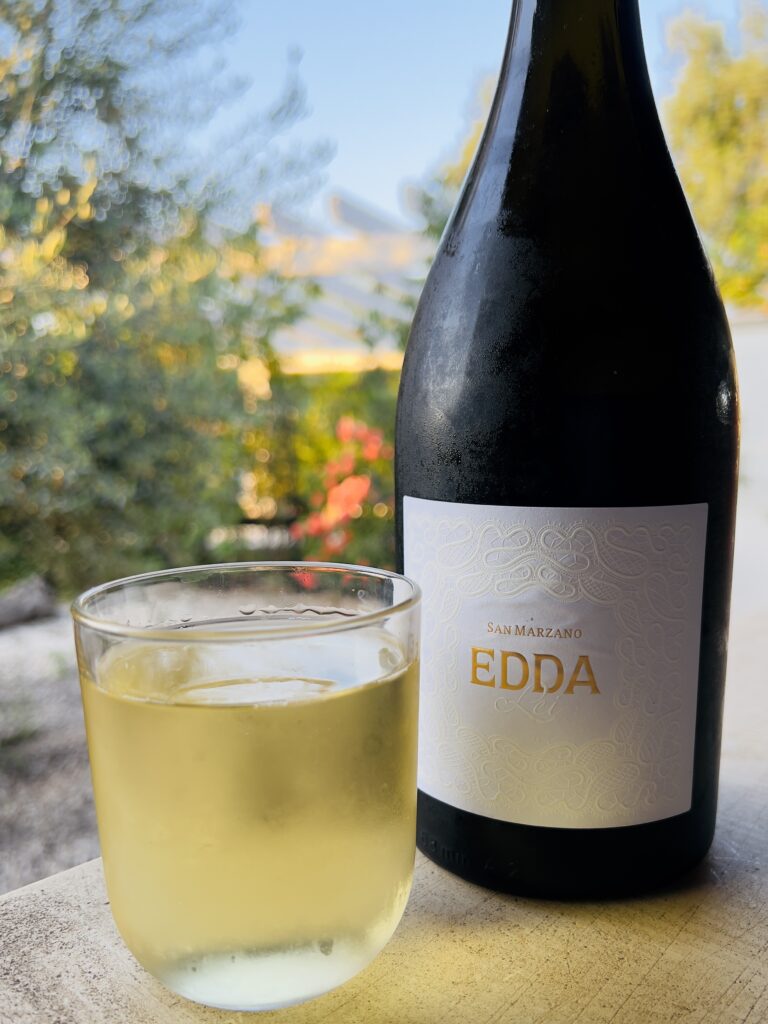
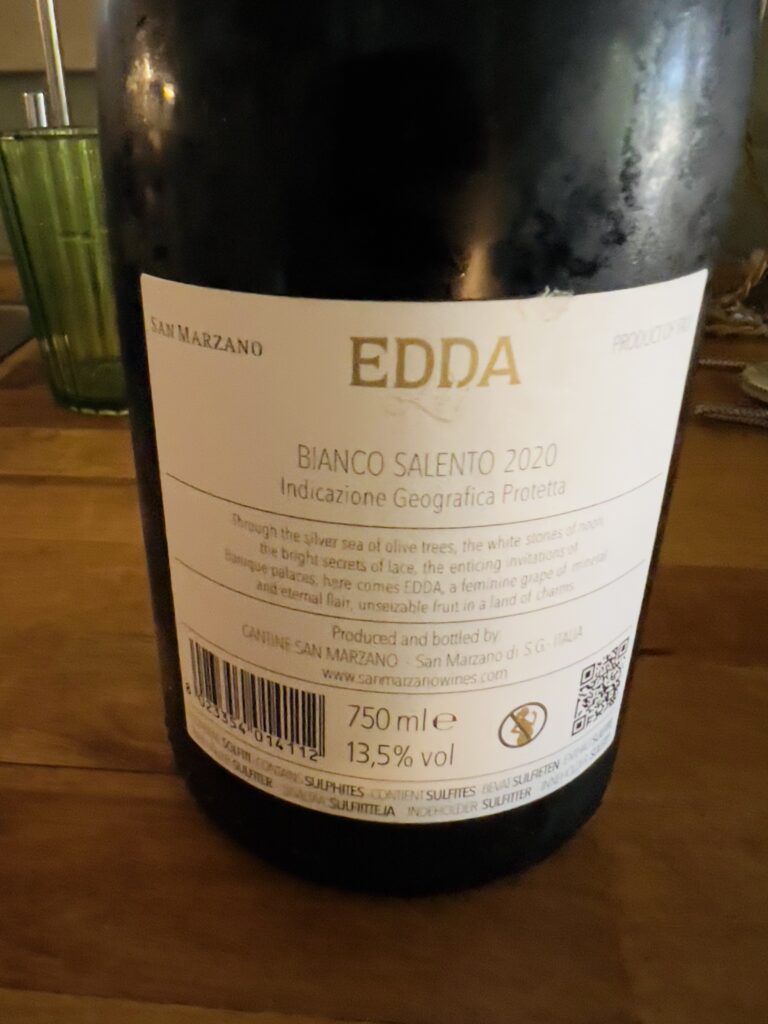
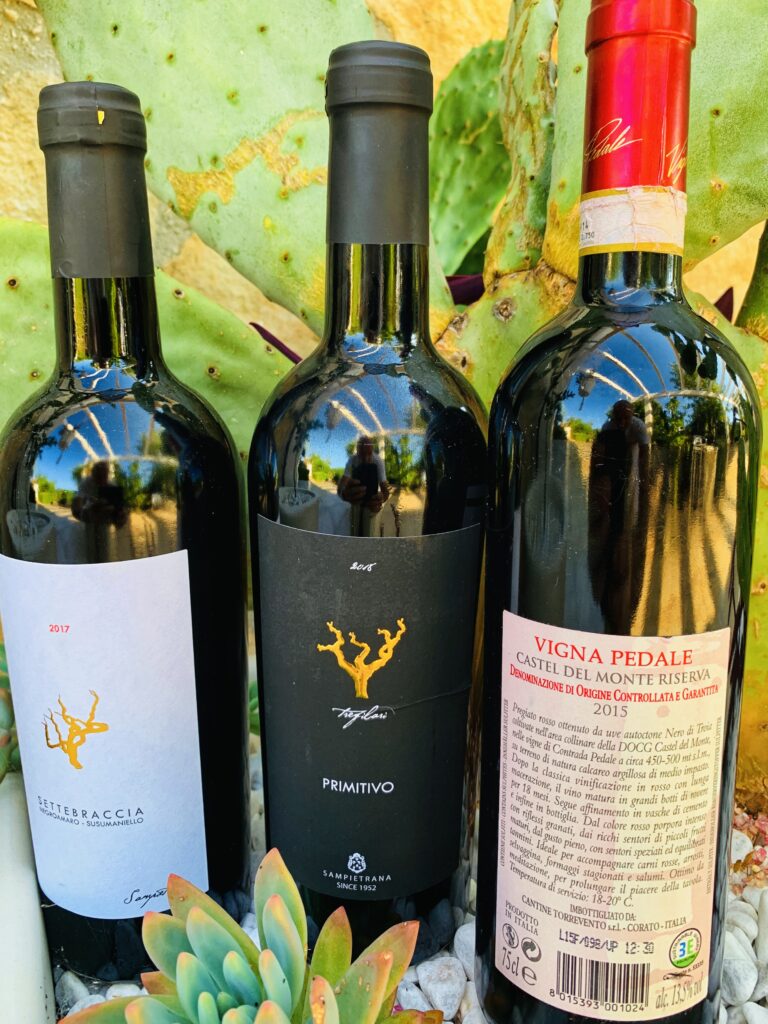
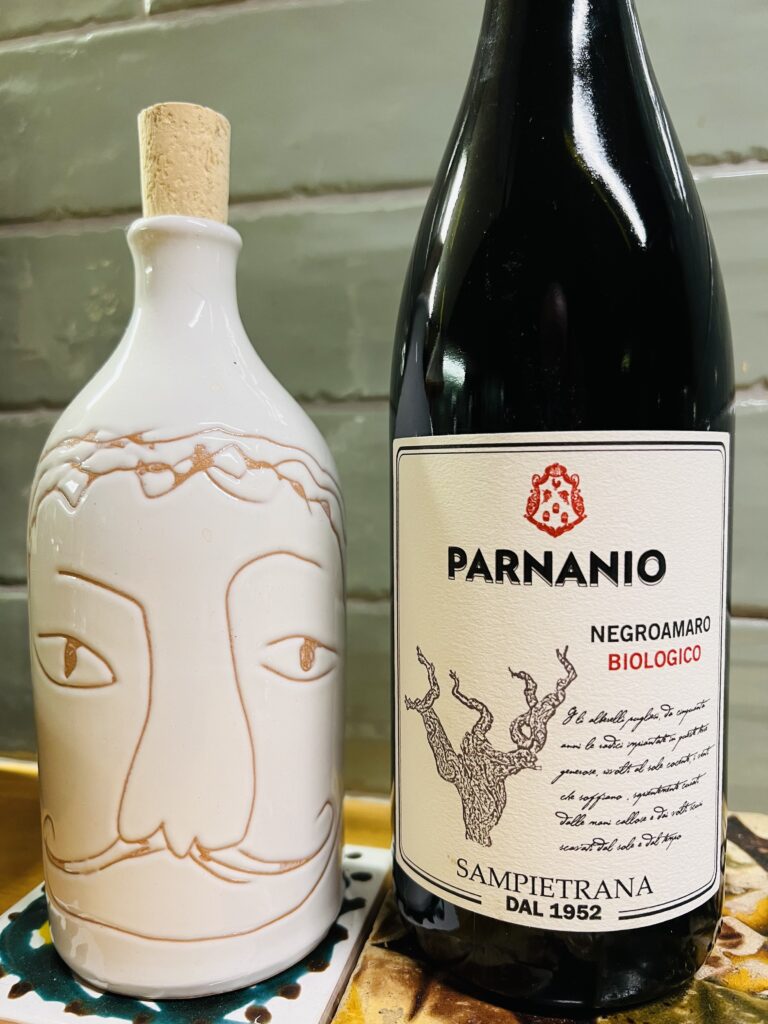
The prices referenced are from Enoteca Vini di Puglia, as at March 2023. All of these wines are very good, and are the wines we have at home. We have never been disappointed.
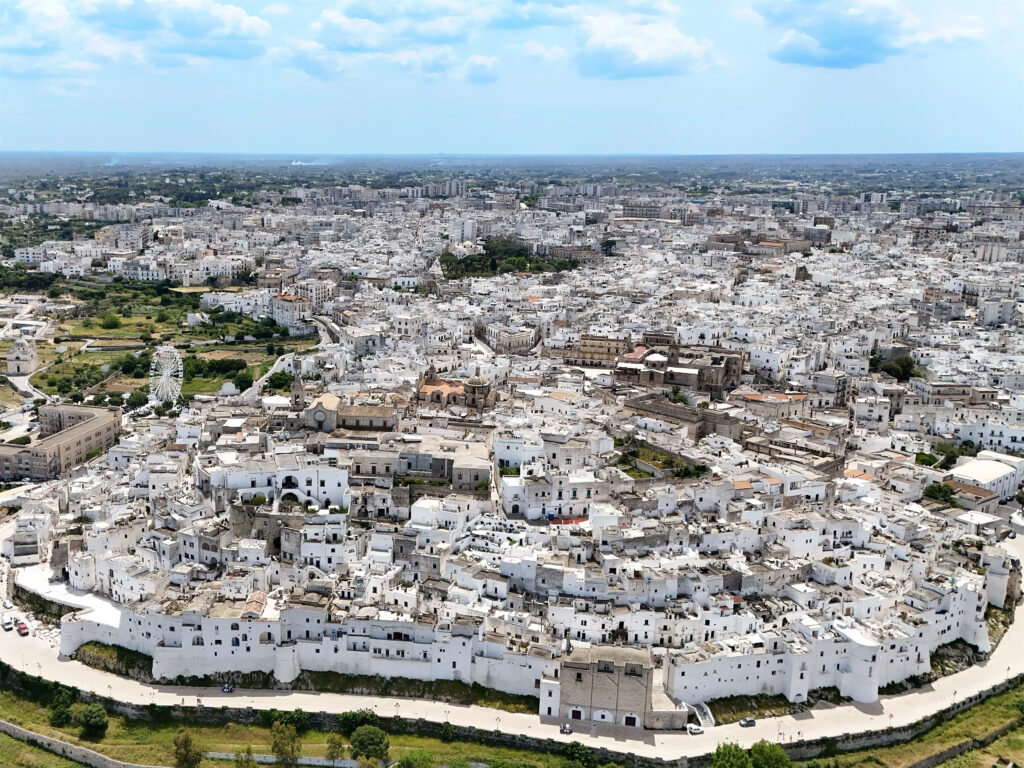


We don’t accept payments or freebies for positive coverage or recommendations. Our reviews are anonymous to ensure we have the same experience as any visitor.
Follow us on Instagram for frequent video stories, reels, photos, ideas and other information to inspire your visit to Puglia.

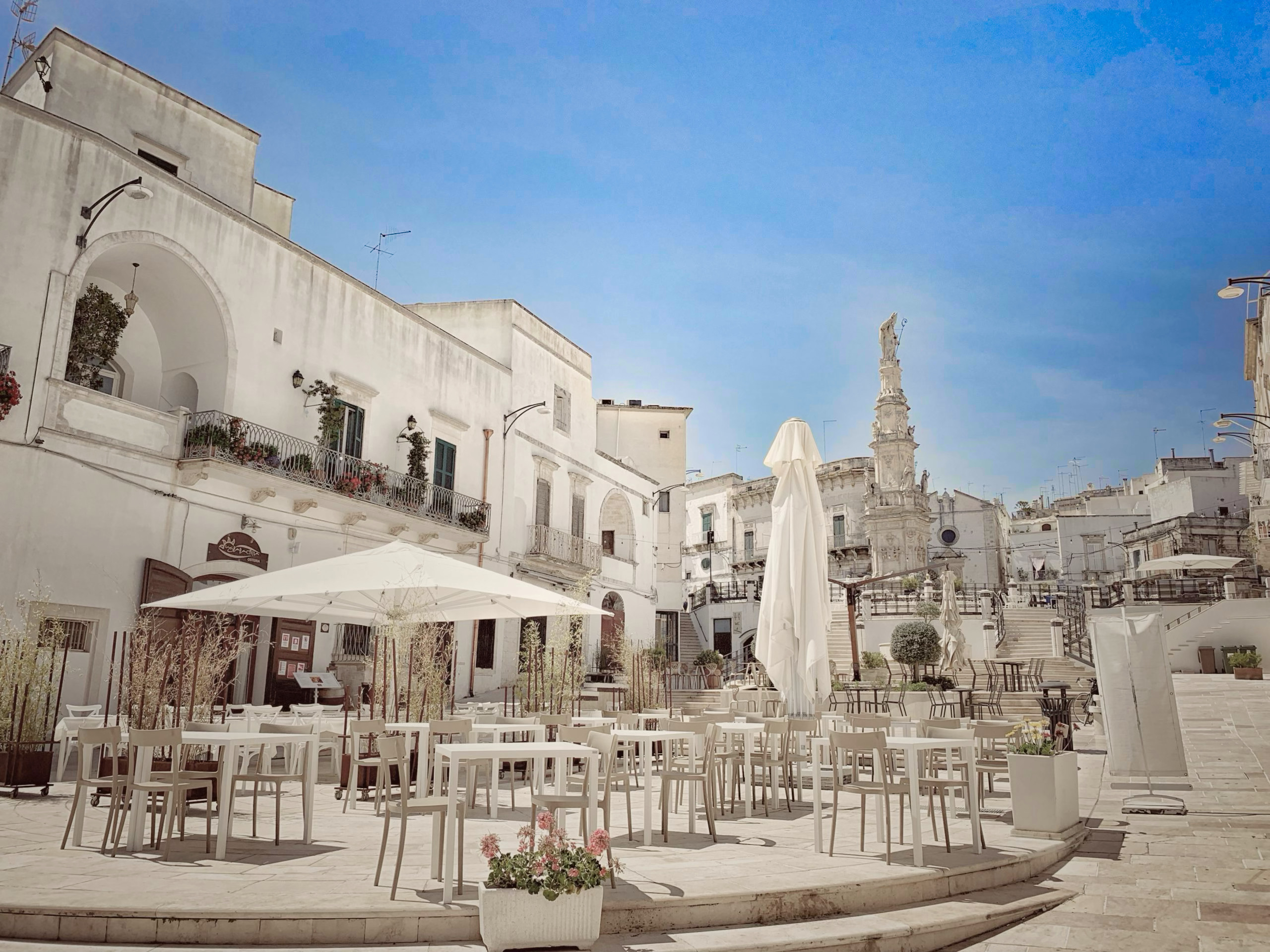
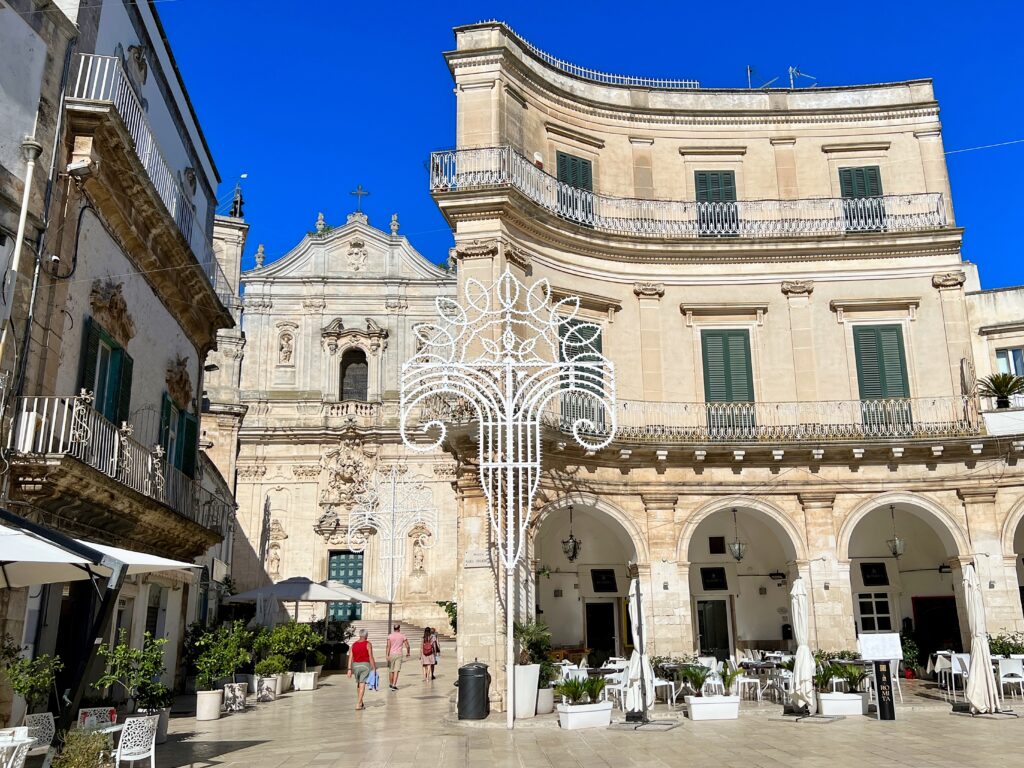
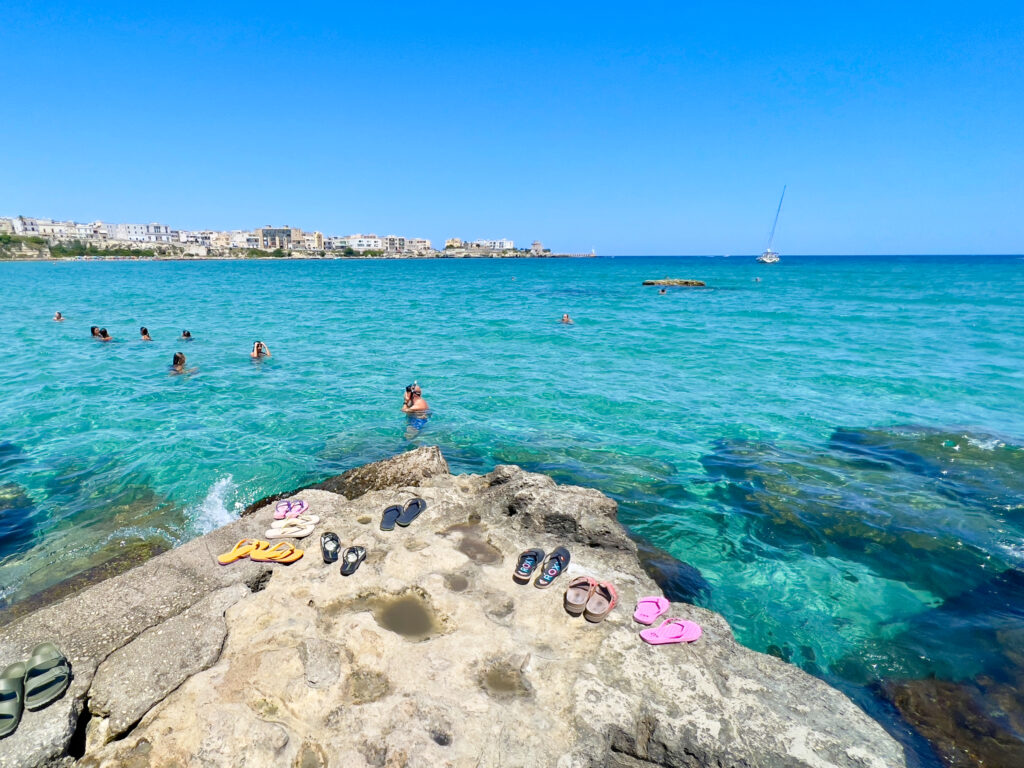

Ciao I’m coming tomorrow to Ostuni. Can you advise on any Easter events like parades? Grazie
Find events here or just look on the streets for the posters.
There should be a parade tonight at piazza della Libertà, a solemn procession. Around 8pm – we are in Taranto to see the best one in Puglia, so can’t quite recall the times etc for OStuni. But you will find posters and you can ask at tourist office.
So sad to hear that Osteria del Temp Perso is a big “avoid”. We ate there in 2012 and had a lovely meal in an atmospheric setting. Maybe we contributed to its demise by praising it so highly on travel reviews! Never mind, I’ll be checking out some of your recommendations when we visit in June.
Ciao! Don’t worry, it continues to delight tourists and it is a nice setting that still feels different for those visiting Ostuni. It continues to be recommended in almost every tourist guide, and almost every tourist we speak to has it on their list to visit. But by local standards, both times we visited (our last visit was July 2022 and we haven’t been back since), the food fell short of what we are accustomed to eating out, and for less. We try not to be prescriptive, why we write that we avoid it without telling others to do the same! It is not a restaurant for locals. A great alternative to try, where locals and Italian visitors go, would be Ristorante Trattoria Fave e Fogghje. Have a great time in June. Much to look forward to!
LuigiM.
I’m visiting Ostuni in early September and am looking for an olive grove tour that includes lunch or some sort of a meal. Do you have any recommendations?
Ciao Rose, currently based in Ostuni we always recommend tour guide Pietro from Puglialy, who organises this type of activity, also wine tastings and more. Pietro is a trusted travel designer and tour guide, born and raised in Puglia, fluent in English. He is popular and his tours are only for small groups. If you do contact him, be sure to let him know we recommended him to you.
Buone vacanze. LuigiM.
Hi there,
Great work, thank you! 👏🏻
And where would you recommend the best place for coffee/capuccino in Ostuni (off season also)? I heard of a very old coffee place once…
And, one last question, my son (almost 24) is gay, any recommandations on where to go (bars, etc.)
Thank you!
Ciao. Grazie. There are many old bars (where we go for coffee), but some might be a little away from the old town centre.
But we wonder if you might be thinking about Borgo Antico Bistrot, which is more than just a bar? It’s not that it’s particularly old, but it has the “Borgo Antico” (ancient village) part to its name. The oldest we can think of is Bar Biancofiore (Corso Giuseppe Mazzini, 79) which looks like an old traditional barber to us, almost, No frills….
Not sure if there’s a particular “magic” to an old coffee bar, as opposed to the fun of people watching on the piazza at either Caffè Fanelli Bistrot Piazza della Libertà, or Caffè Trieste Piazza della Libertà, 45.
If it’s traditional pastries that you are after try:
Gran Bar – Pasticceria Gelateria, Via Papa Giovanni XXIII, 58,
Ciccio in Piazza Ciccio Pastigel, Via Armando Diaz, 66, (great for gelato)
Bar Kennedy, Via Pola, 31/a.
For your son, is it just Ostuni or elsewhere in Puglia? There’s a huge gay presence through the summer months (from Easter through to October), but there’s no dedicated bar in Ostuni. Instead it’s just noticing hanging out on the piazza.
Your son can look at the Big Gay Puglia Guide site Ostuni guide (they might even have a podcast), or more generally the Big Gay Puglia Guide.
Out of interest, off season, do you mean, January, February?
Buone vacanze. LuigiM.
Hi my son is getting married in ostuni in may. I am looking for a tuxedo rental business 6 tuxedos. Do you have contact info for places I can look into?
Ahah! Afraid not, restaurants and places to visit are our thing. However we have never, ever seen a tuxedo at a wedding here in Puglia, and suspect that you may not find such a thing, at least not locally. In fact we have never seen anyone wear a tuxedo at any event we have attended. They may not be a thing here! But have you tried a google search? Happy travels and have a great time in Ostuni.
Luigi m.
Hello
Do you know of any festivals during the month of July , in Puglia ?
All summer long the various towns and cities have their Patron Saint festivals. The most impressive and famous is Scorrano known for its light and sound show. This is part of the civil celebrations, which includes a food festival. Side by side there are religious parades and celebrations. People visit from all over the world for Scorrano.
https://www.hdsalento.com/luminarie-del-salento/
As we said, these take place across Puglia all summer long. As do the sagre food festivals. We explain what they are in this article:
https://www.gaypugliapodcast.com/mainguides/foodfestivals/
In July there will be:
Patronal Feast of Santa Domenica in Scorrano (LE) in Puglia
Feast of San Vito in San Vito dei Normanni (BR) in Puglia
Festa Madonna del Carmine in Tuglie (LE) in Puglia
Feast of the Madonna del Carminein Apricena (FG) in Puglia
Patronal feast in honor of the patron saints Vito and Vincenzo in San Vito dei Normanni (BR) in Puglia
Historical parade of S. Margherita in Latiano (BR) in Puglia
Sagra te lu ranu in Merine (LE) in Puglia
Sagra ta Turre in Ugento (LE) in Puglia
Country festival Maria SS. Di Mellitto with floral floats parade in Grumo Apulla (BA) in Puglia
Among the other events held in July in Puglia are:
Palio dei capatosta – the challenge between the districts in Mola di Bari (BA) in Puglia
Tango Festival in Trani (BA) in Puglia
Pizzica in festa in Sternatia (LE) in Puglia
Assaprà Festival in Corato (BA) in Puglia
Festival Music Mundi in Grottaglie (TA) in Puglia
Summer Massafra Carnival in Massafra (TA) in Puglia
Wine is Music in Grottaglie (TA) in Puglia
Festa te la uliata in Caprarica di Lecce (LE) in Puglia
Festival of Lecce pasticciotto and Mediterranean flavors in Surano (LE) in Puglia
Summer Putignano Carnival in Putignano (BA) in Puglia
Troia Teatro Festival in Troia (FG) in Puglia
One of our favourites is the Coreutica festival, which is a celebration of pizzica, the music and dance of Salento. Again, combined with food, there are dance and music workshops, and free exhibitions and performances. It also includes street dancing for the public:
https://youtu.be/omnCyTiyFNQ?si=bquCOo9uV3OPnrYE
In due course info for 2024 will be added to their website:
https://www.worldmusicacademy.it/coreutica-2023/
Hope that helps.
LuigiMax
Buongiorno,
Vorrei il vostro consiglio per favore. Vogliamo venire in Puglia per 10 giorni ad Aprile. Pensiamo di stare in due posti. Cerciamo due belli alberghi, uno vicino il mare. Grazie per il vostro aiuto.
Ciao. This guide has all our thoughts on where to base yourself depending on your requirements (sea, city, countryside and whether you have a car or rely on public transport).
Ciao. In questa guida sono raccolte tutte le nostre riflessioni su dove alloggiare a seconda delle vostre esigenze (mare, città, campagna e se avete un’auto o vi affidate ai mezzi pubblici).
Enjoy!
https://www.pugliaguys.com/where-to-base-yourself/